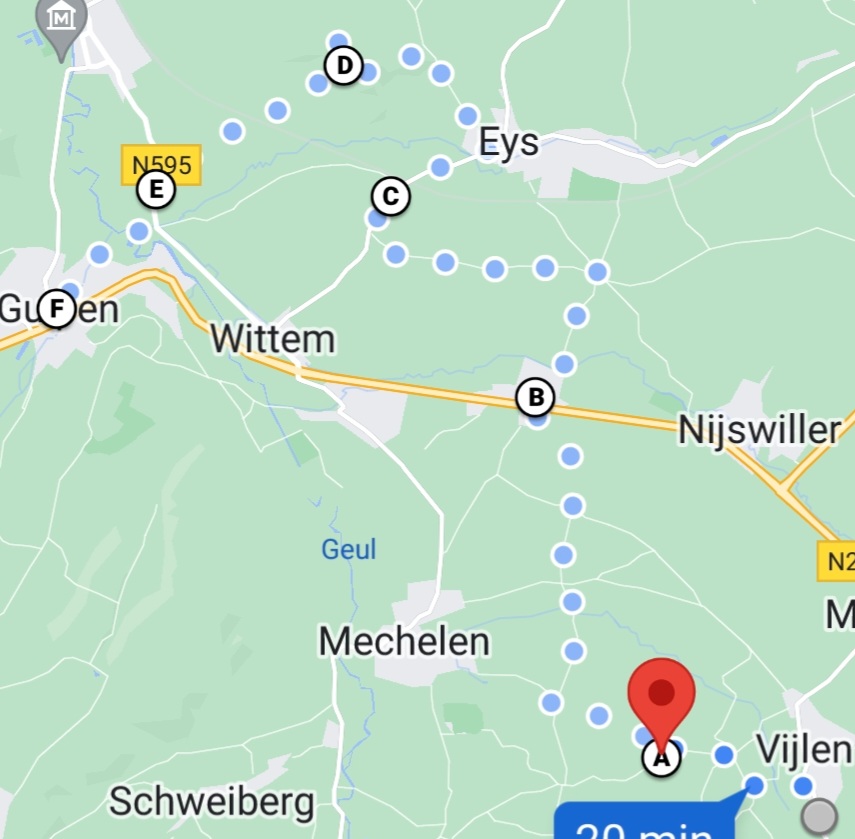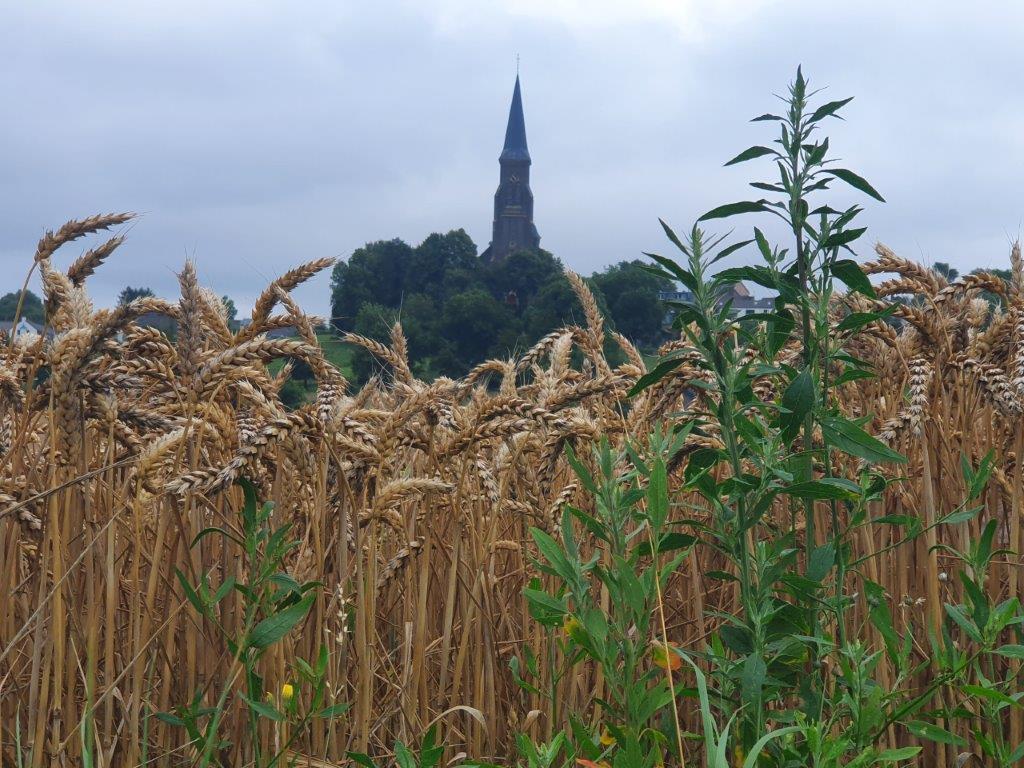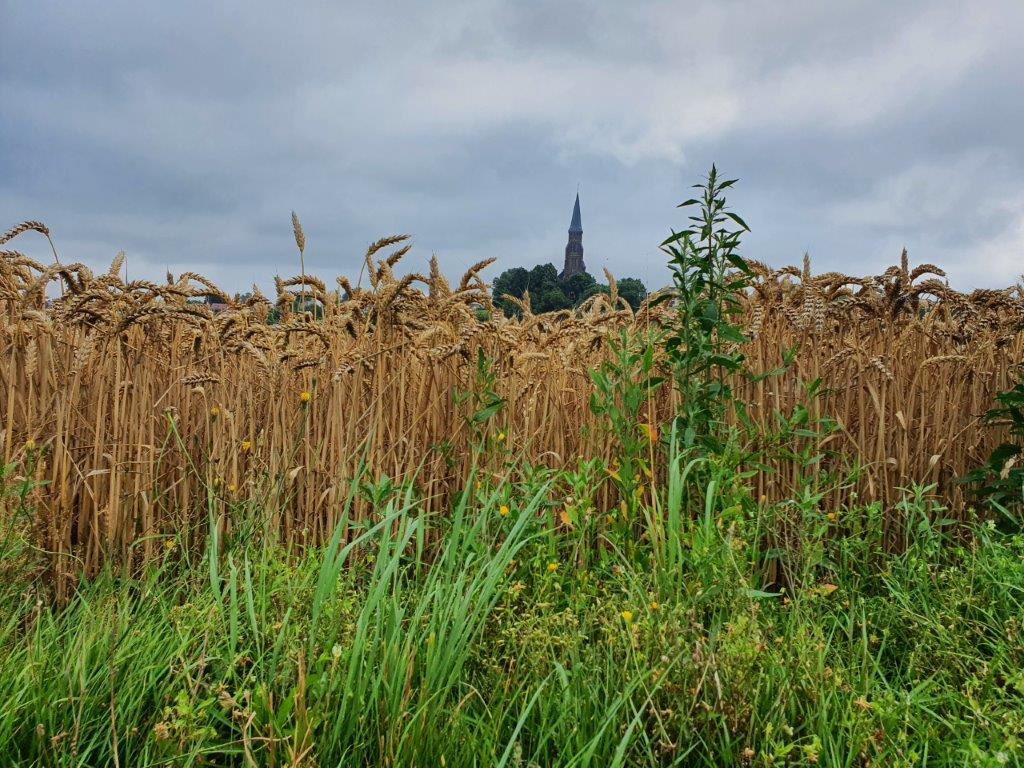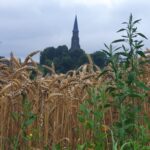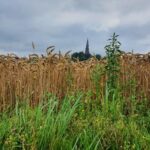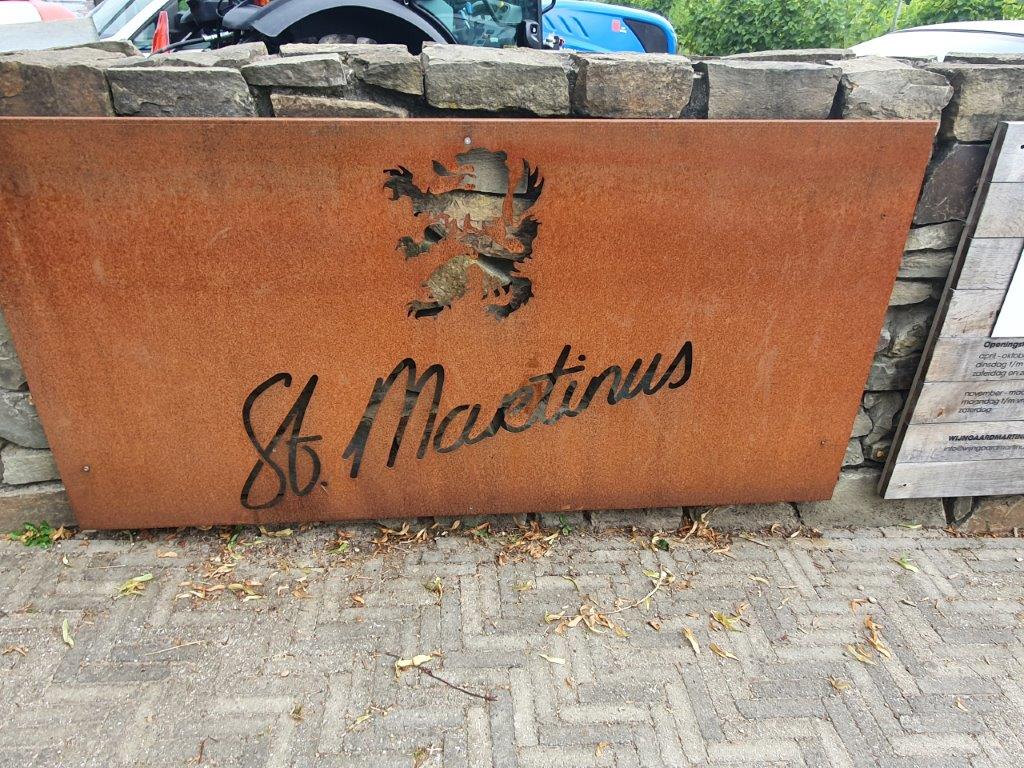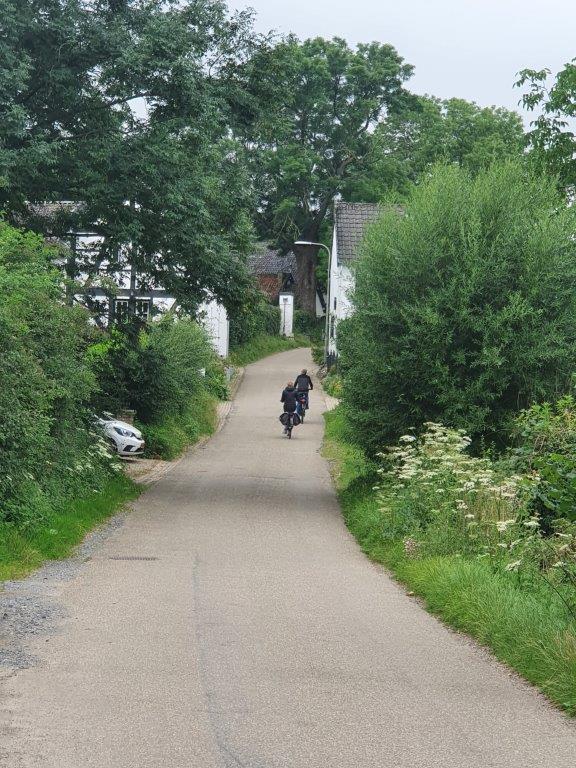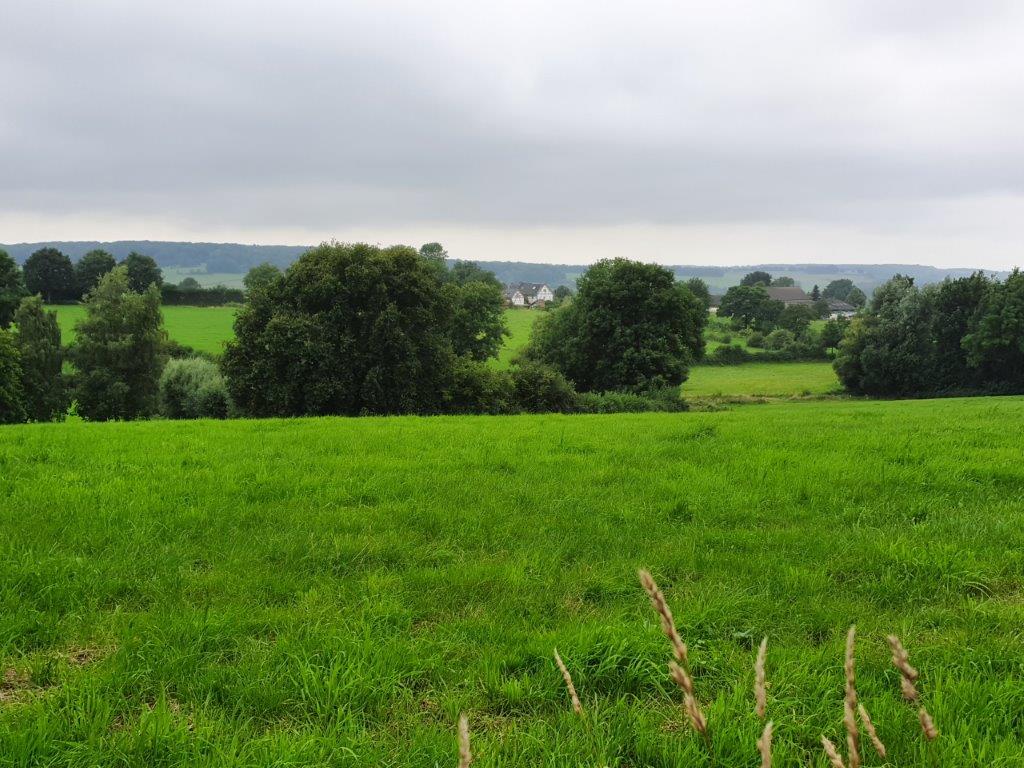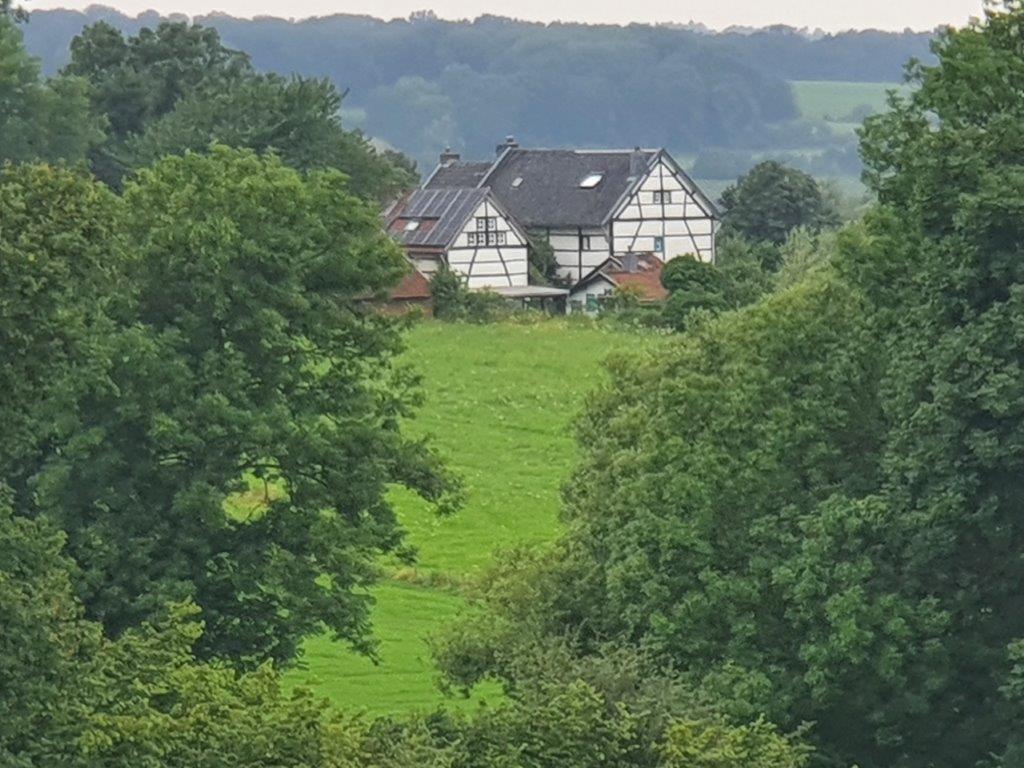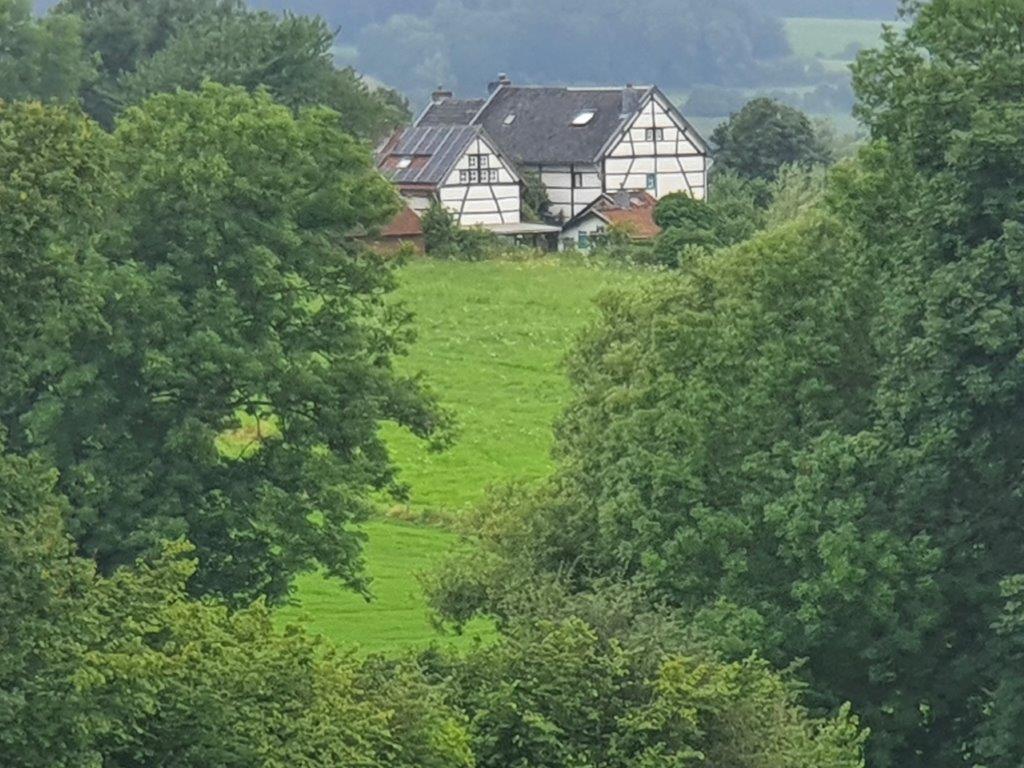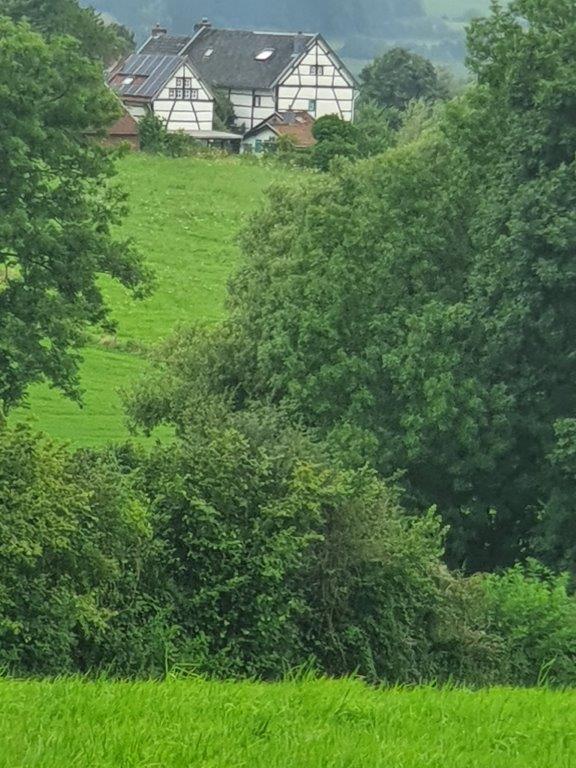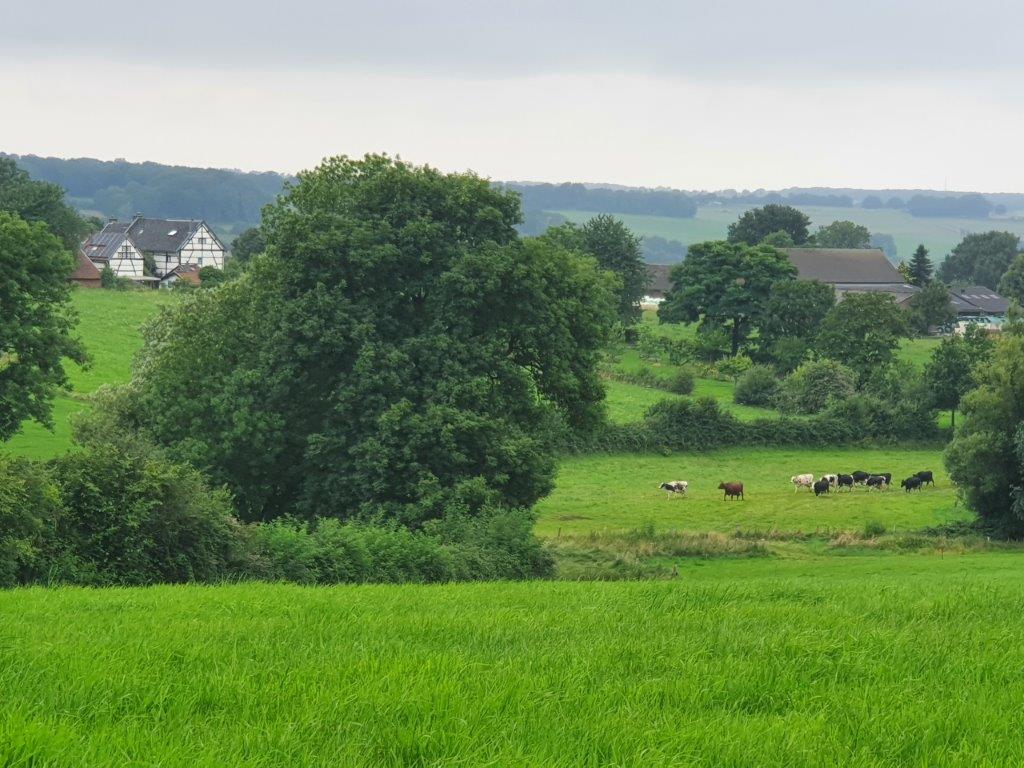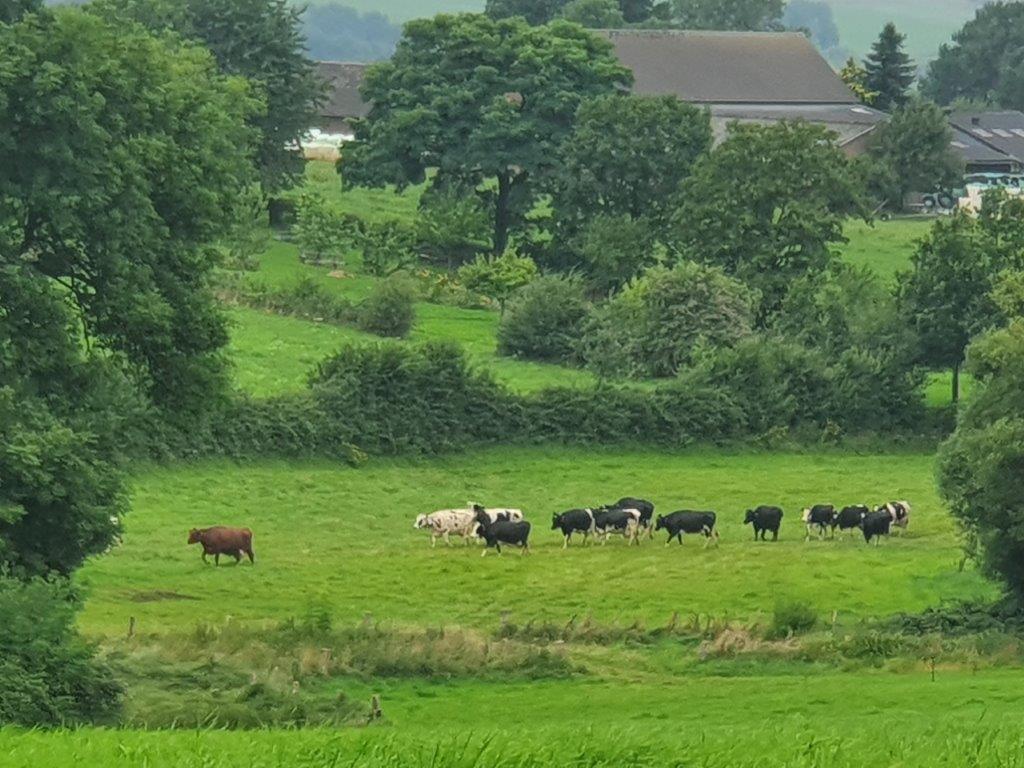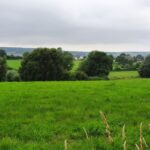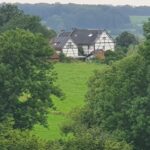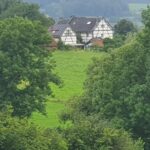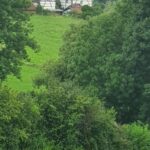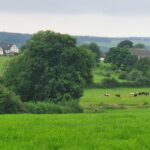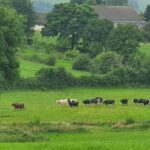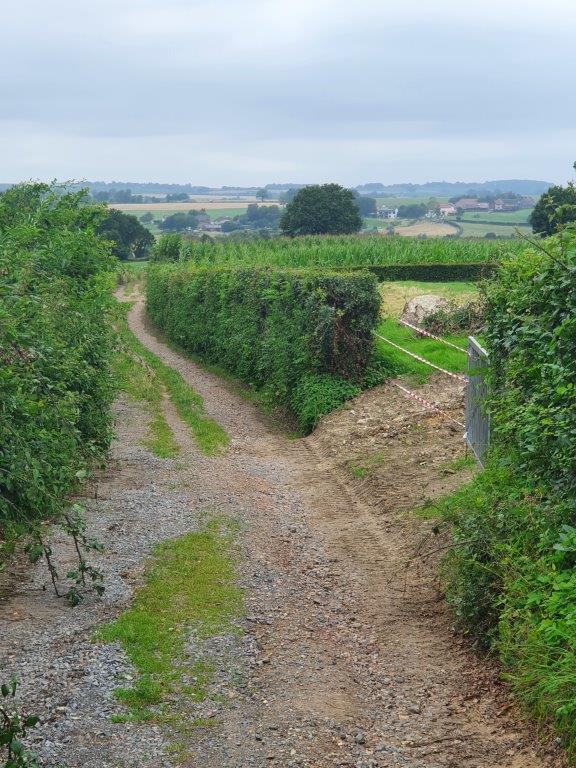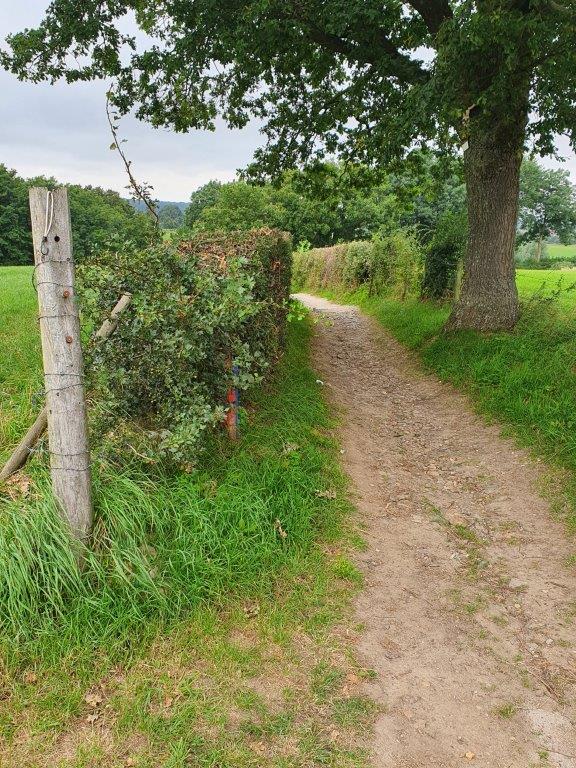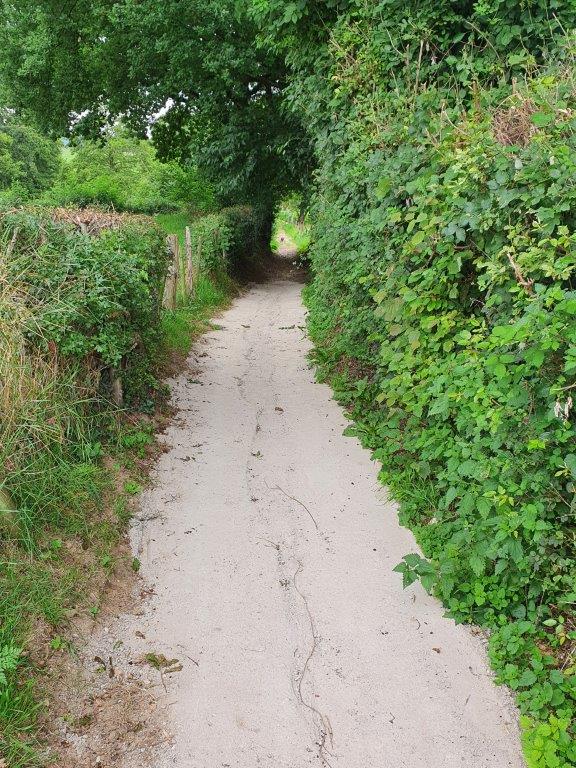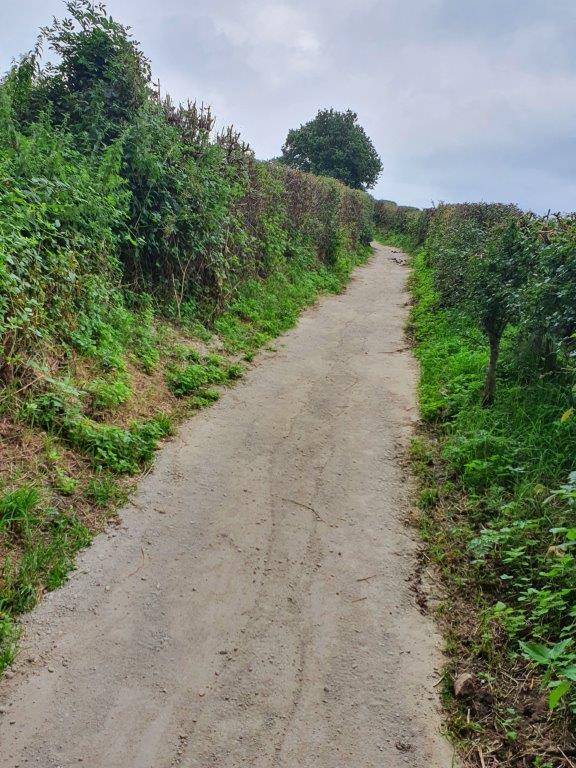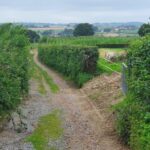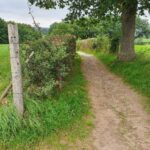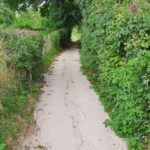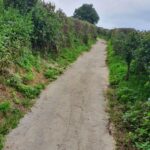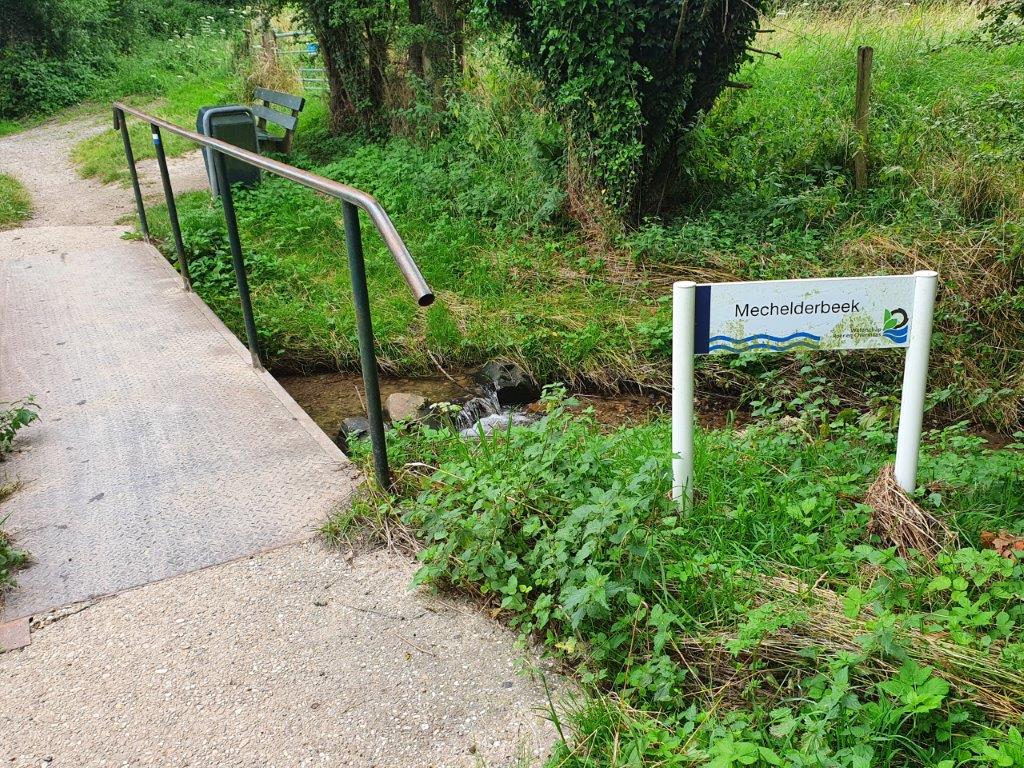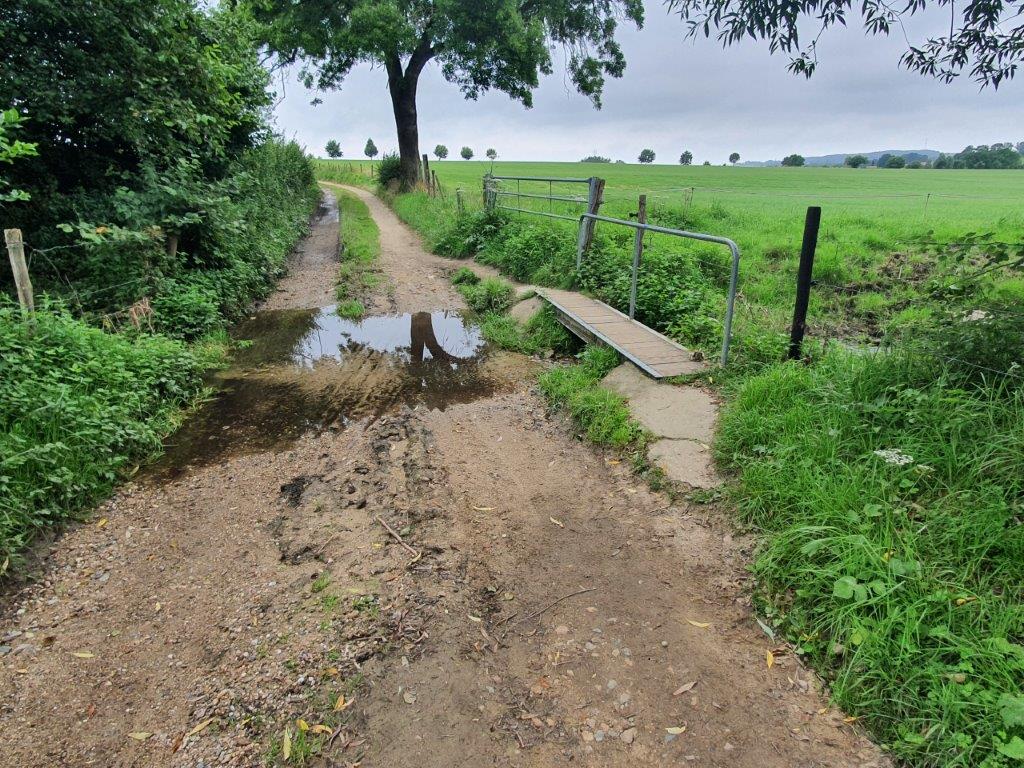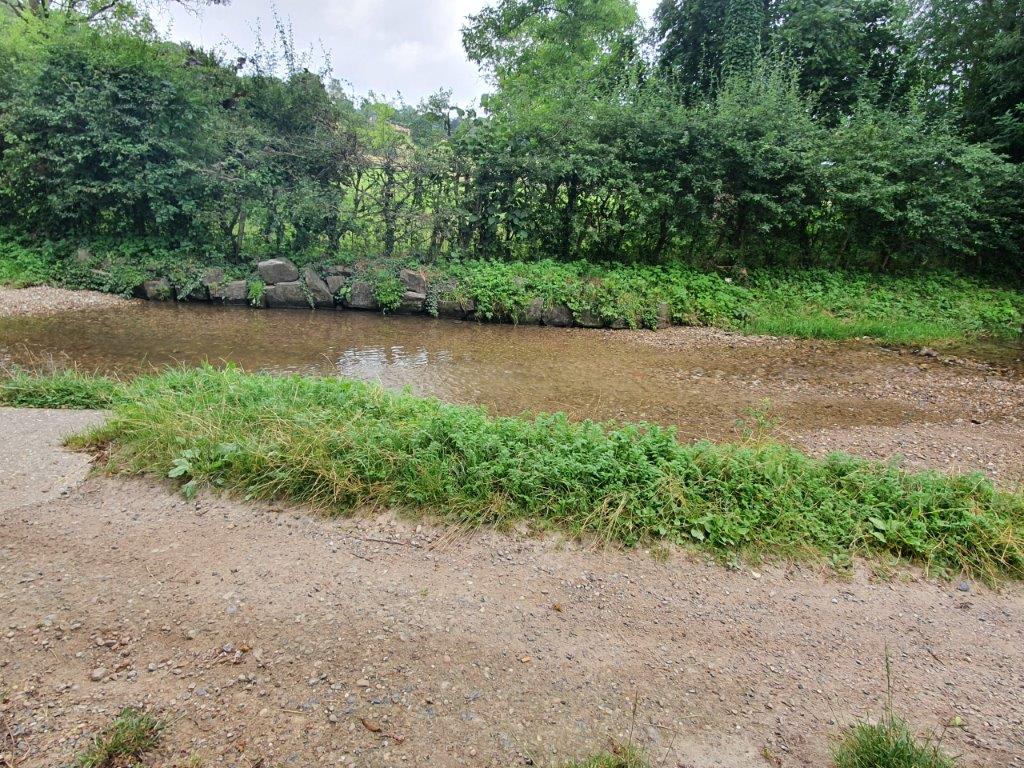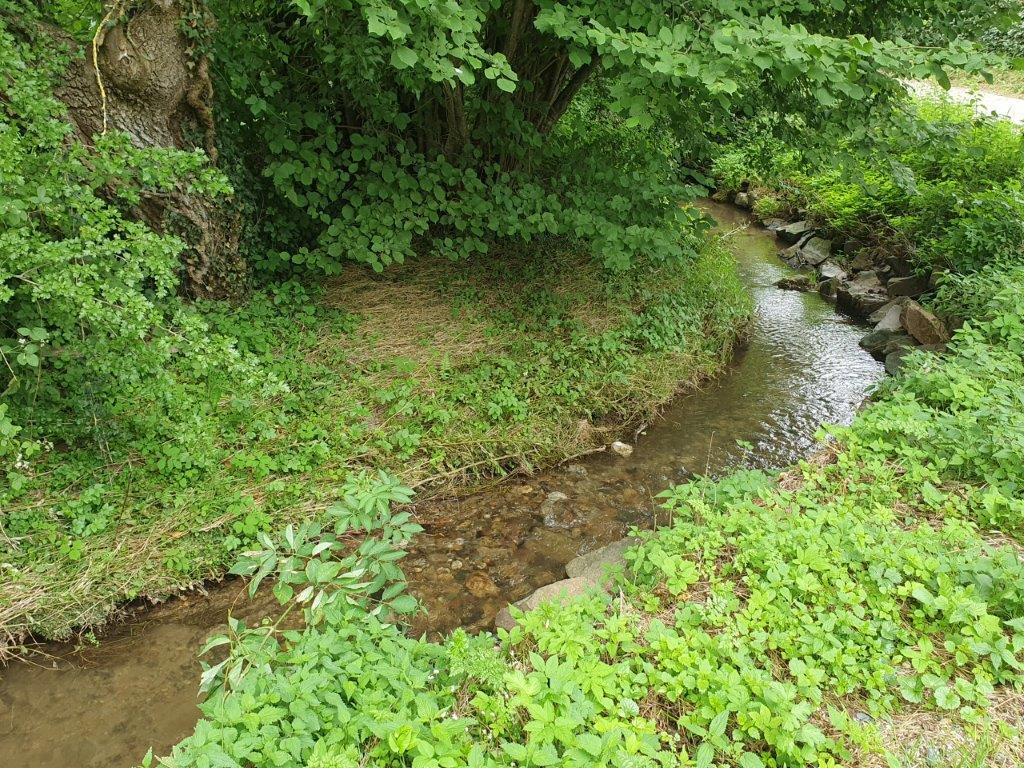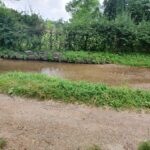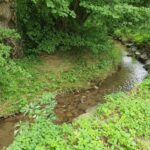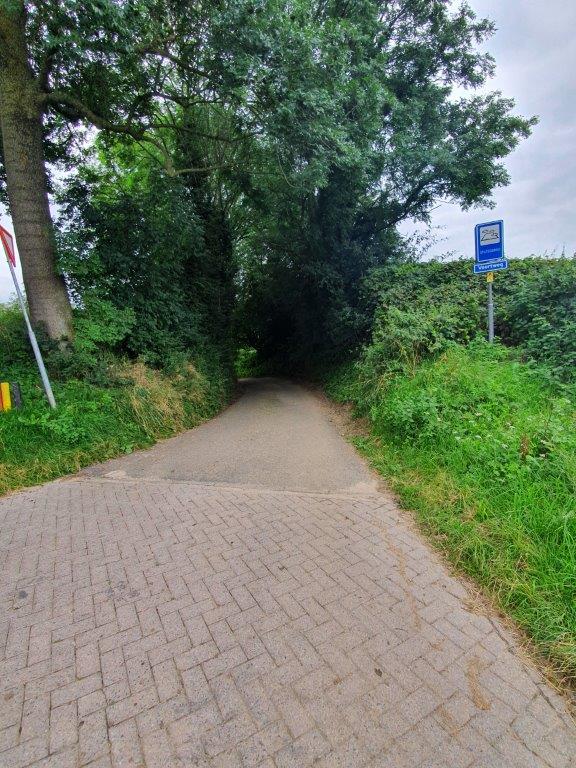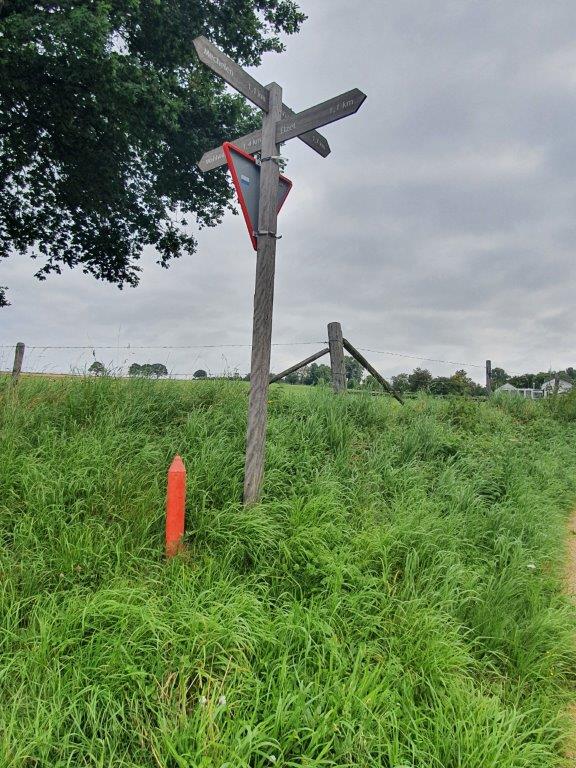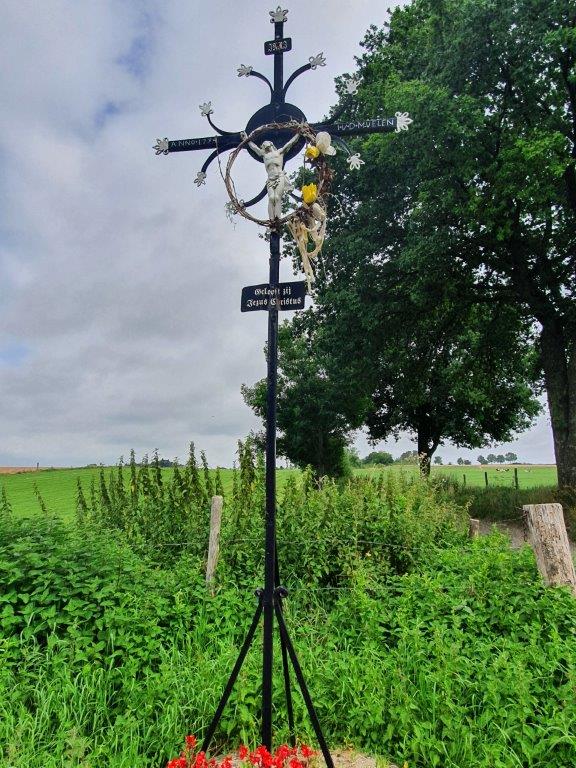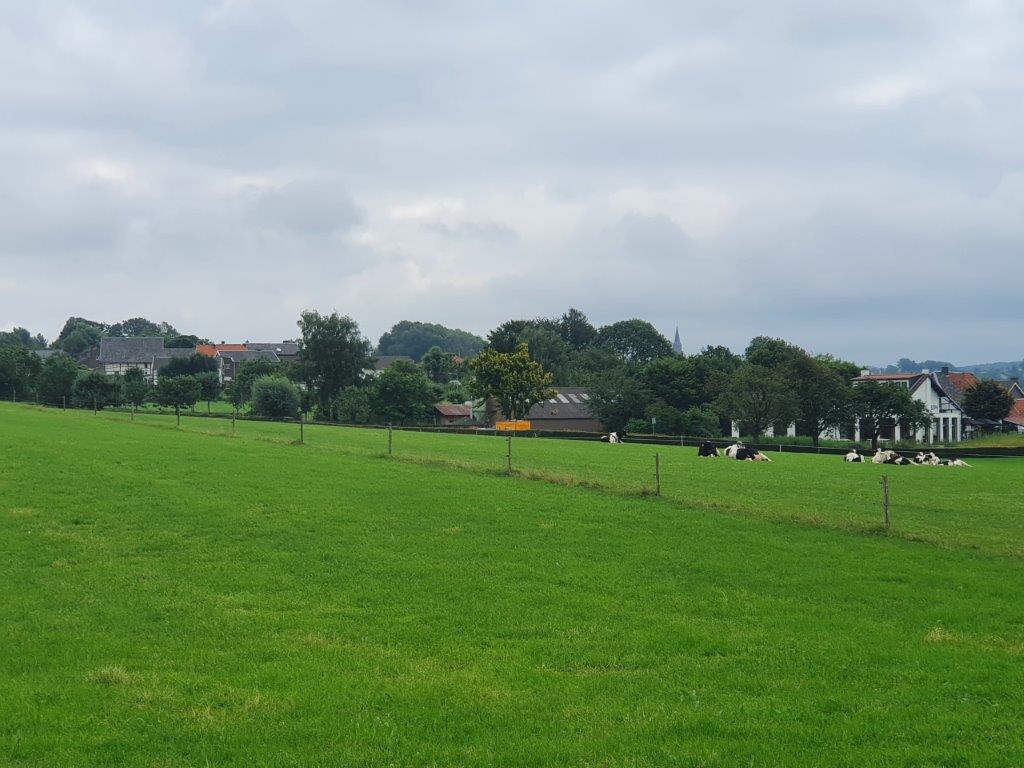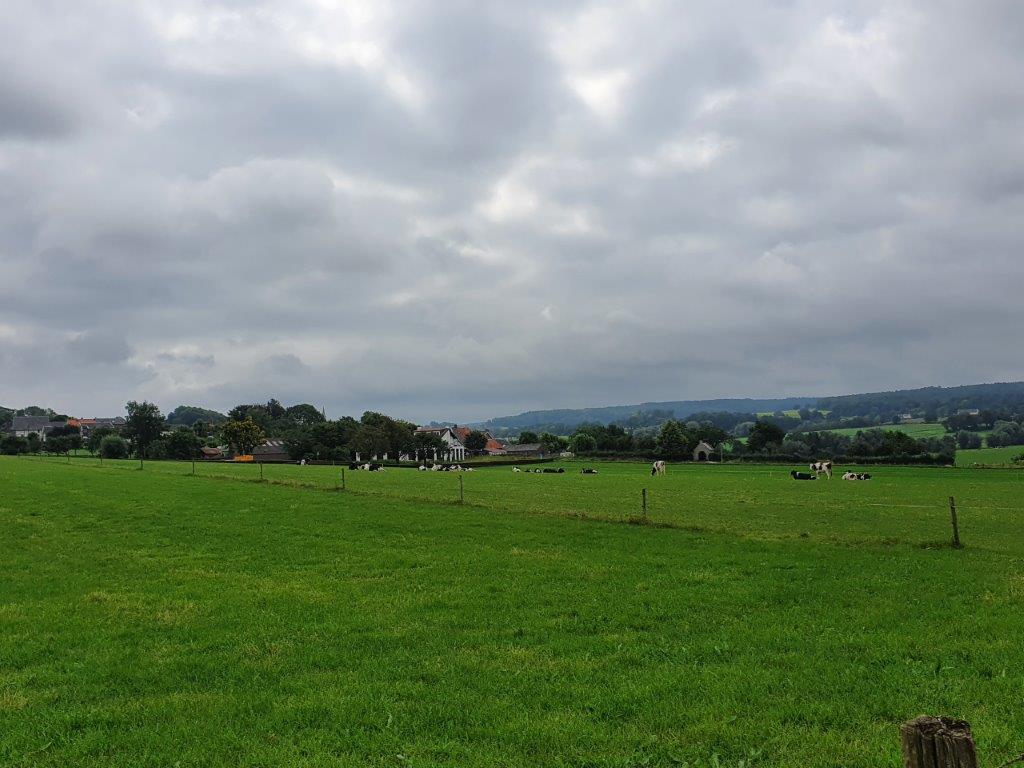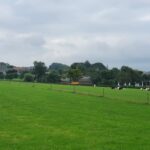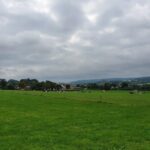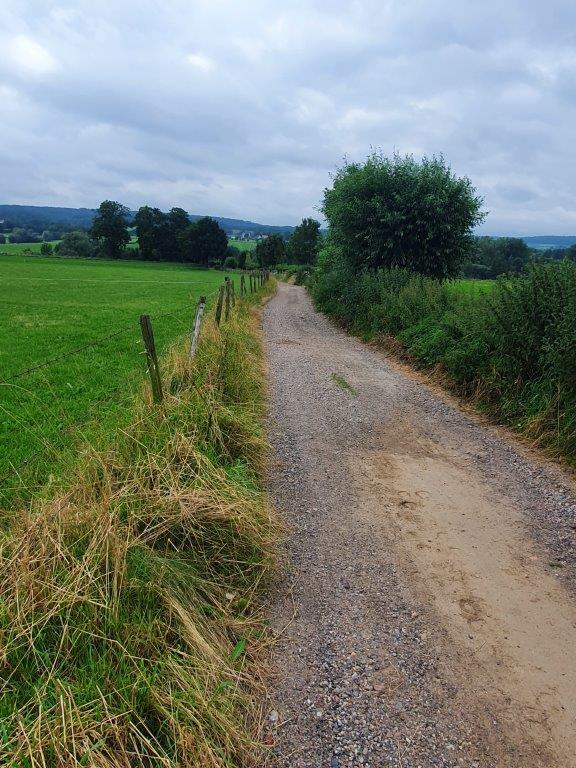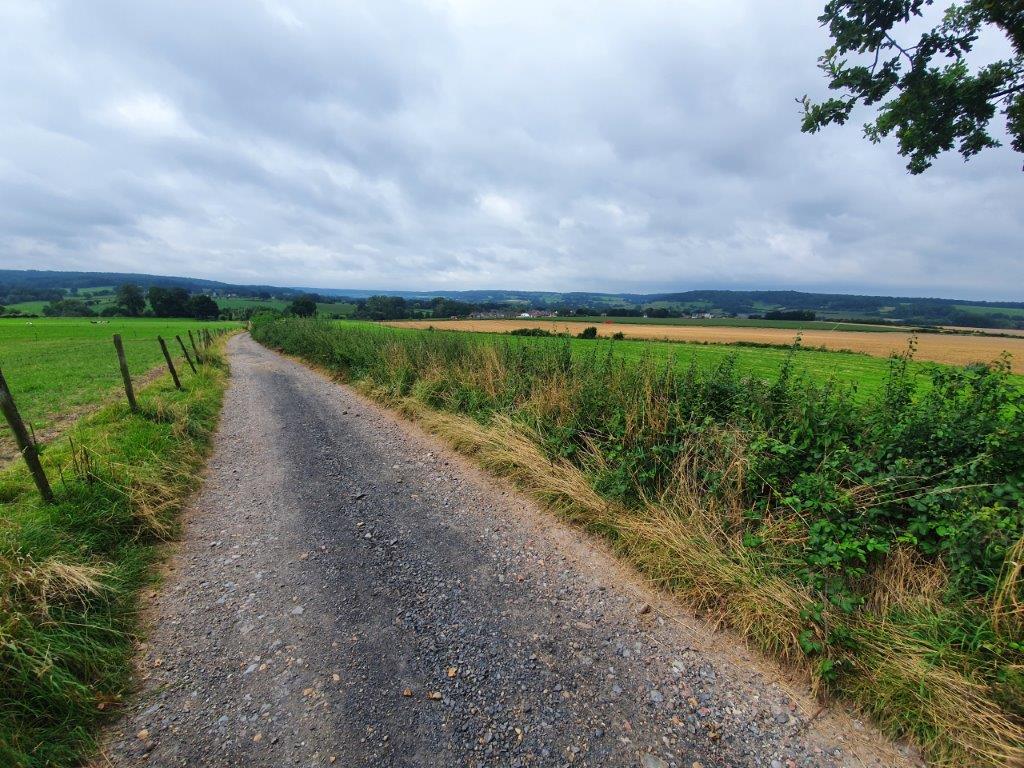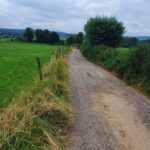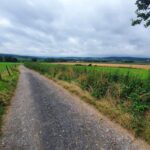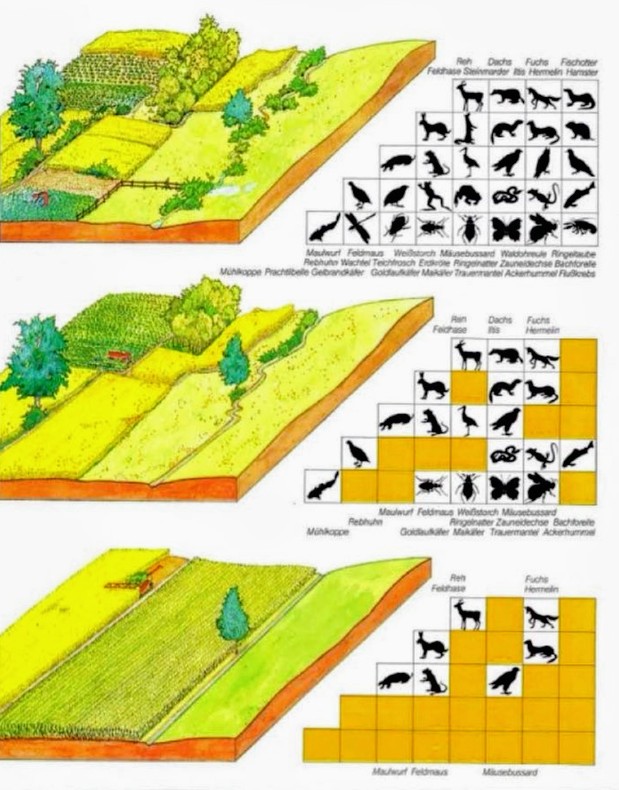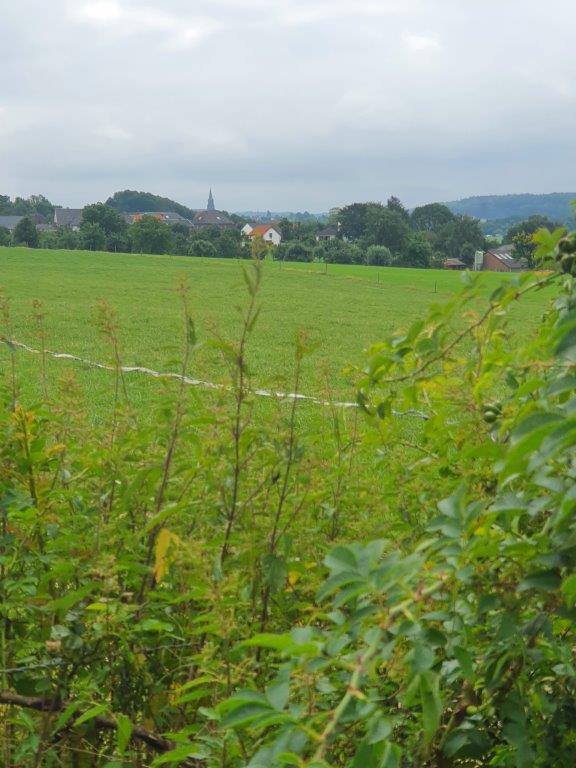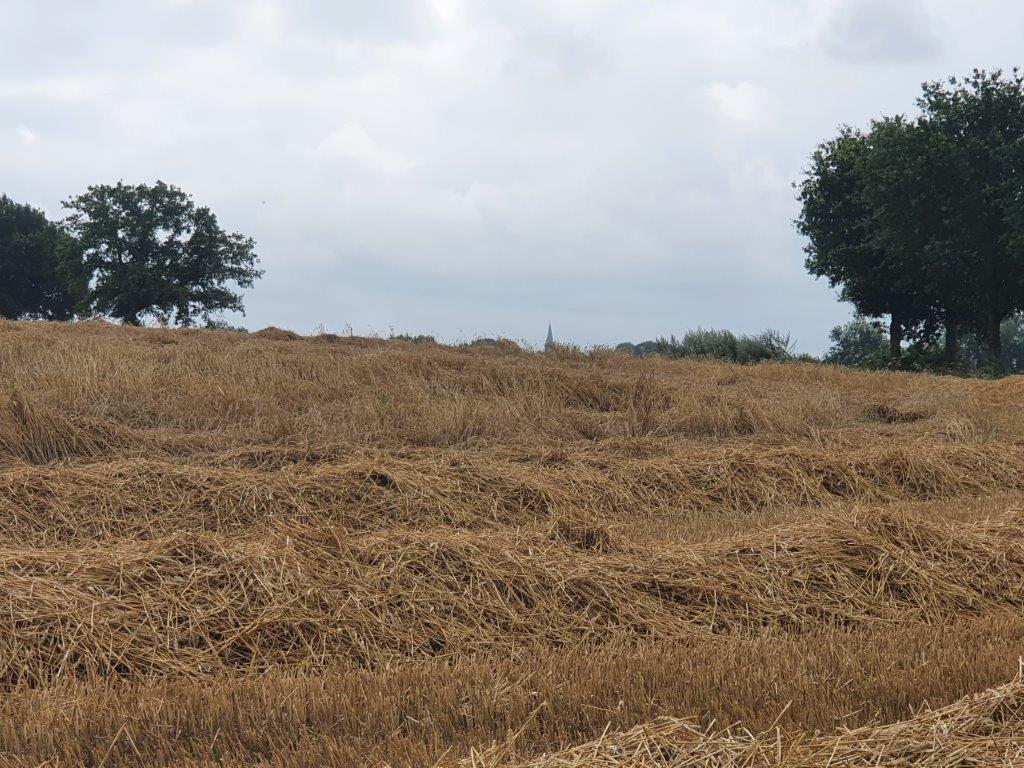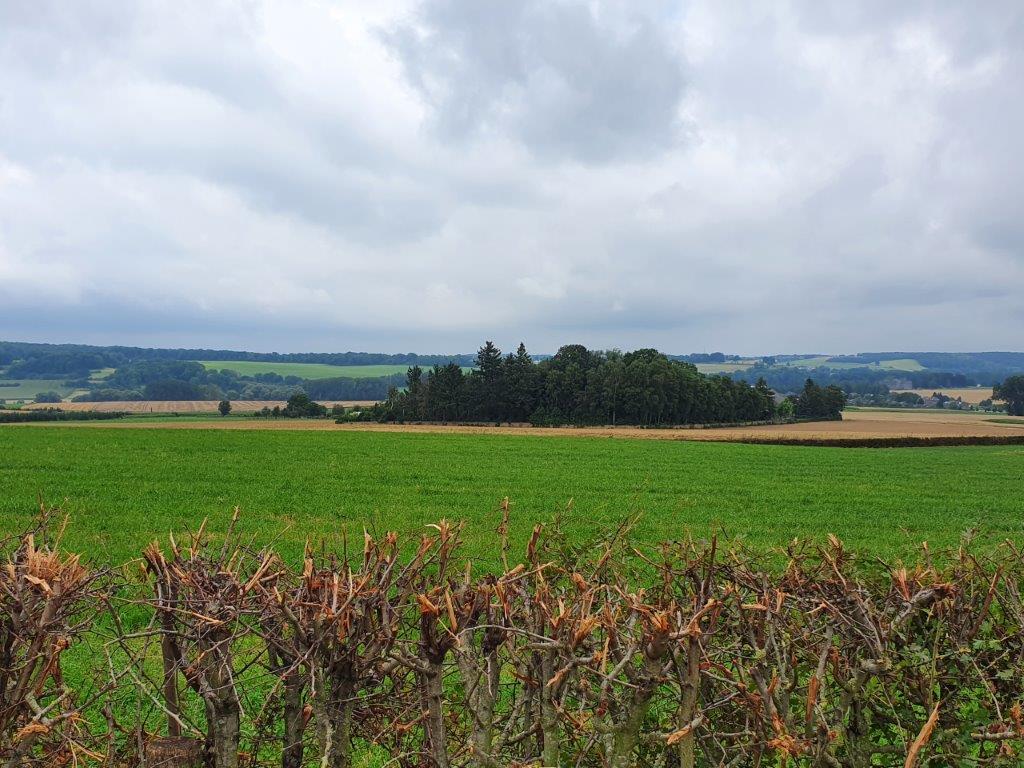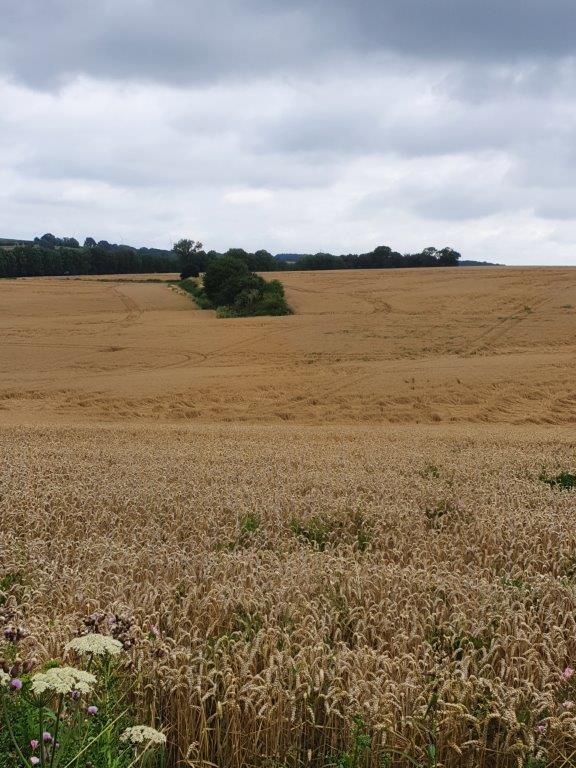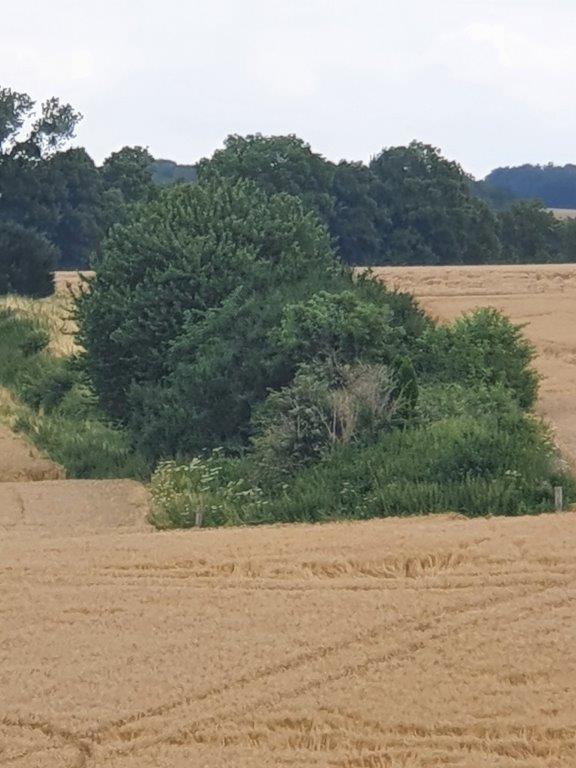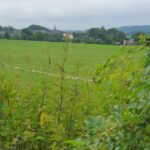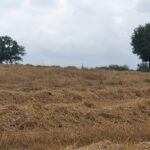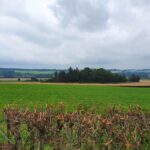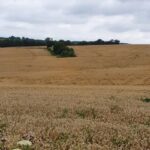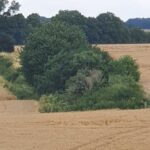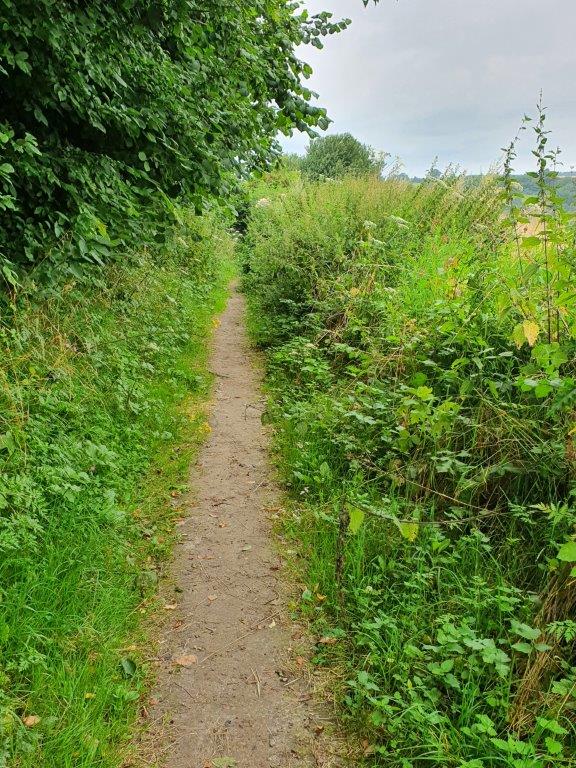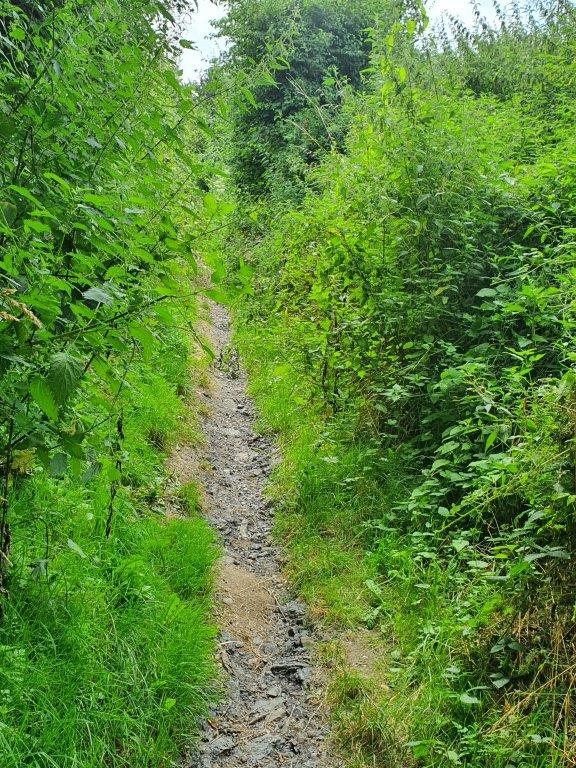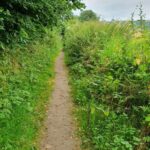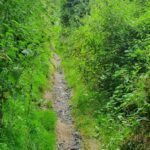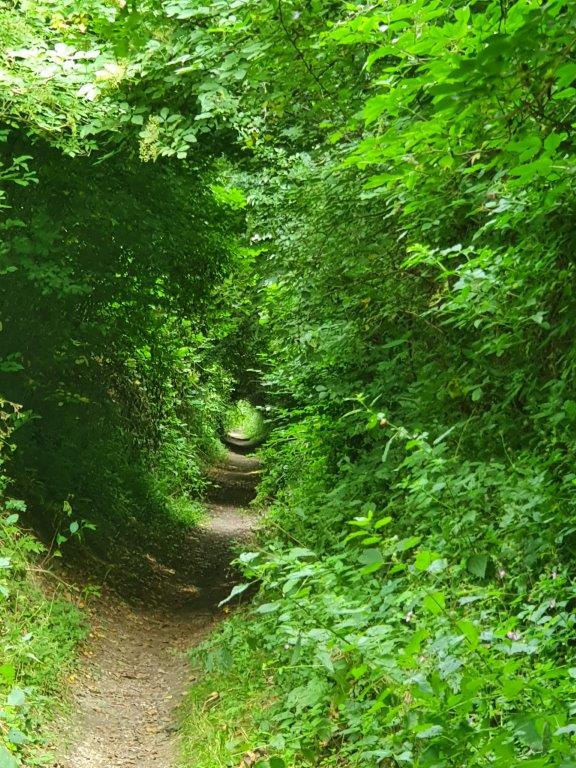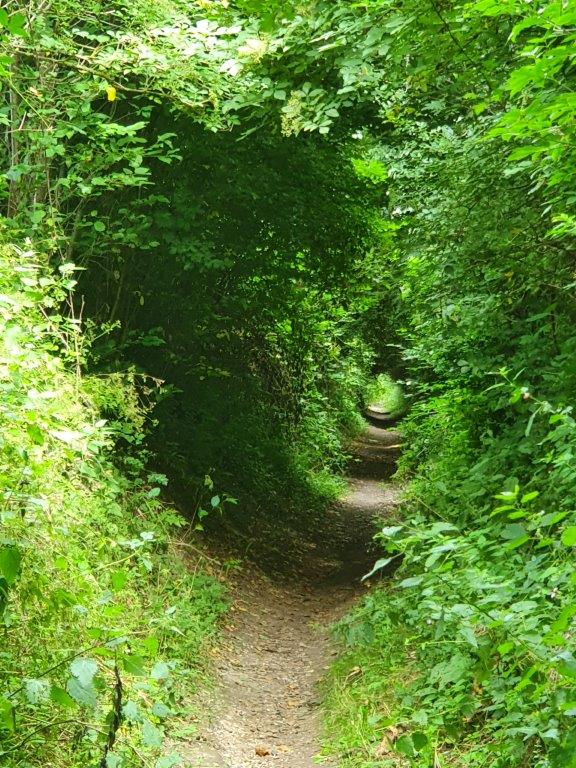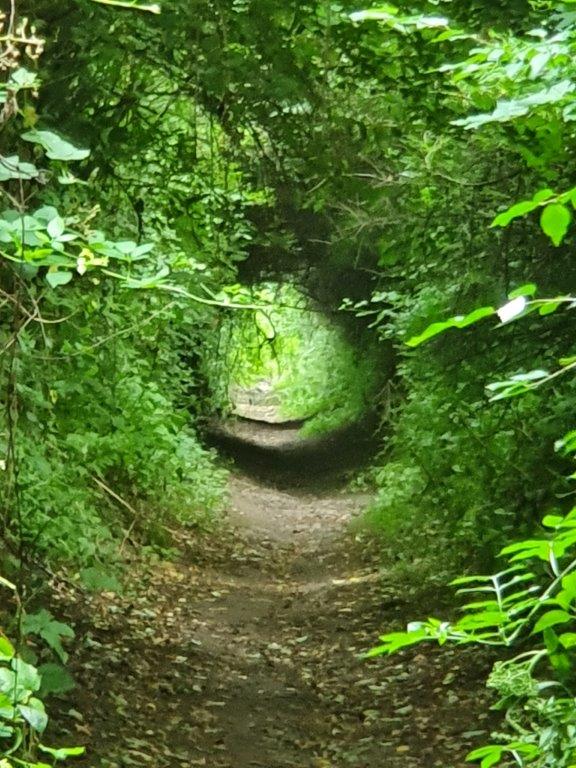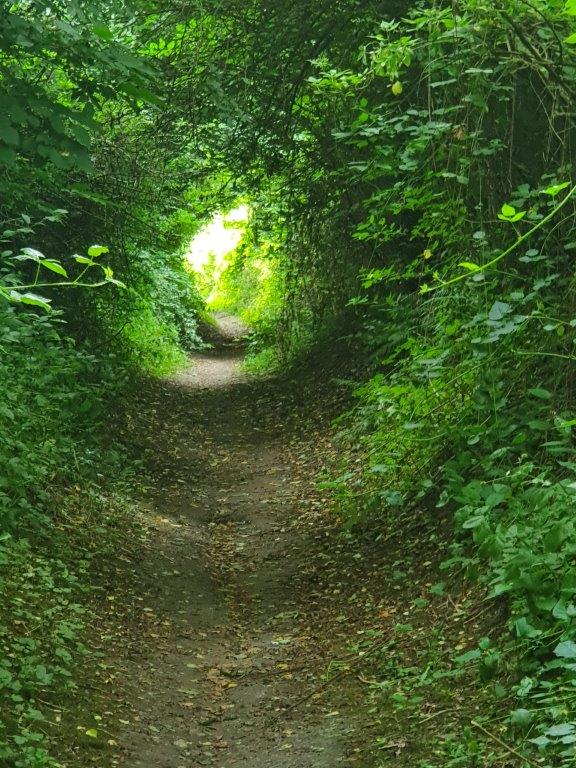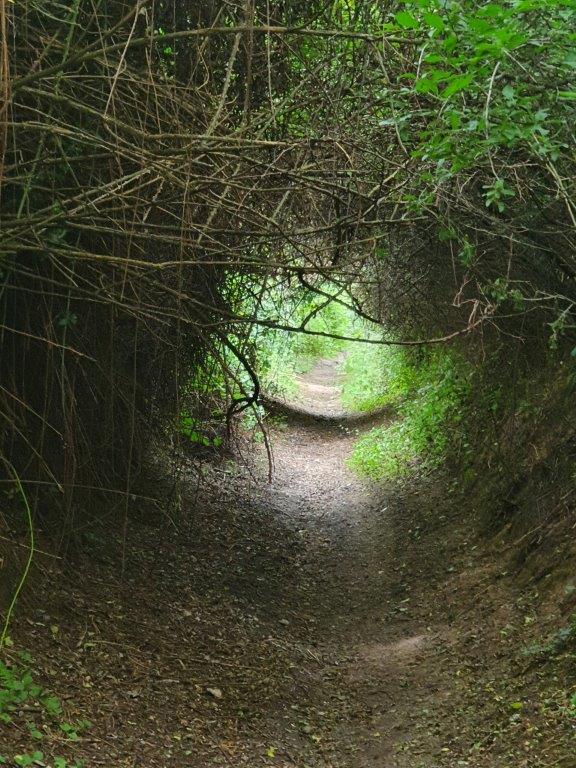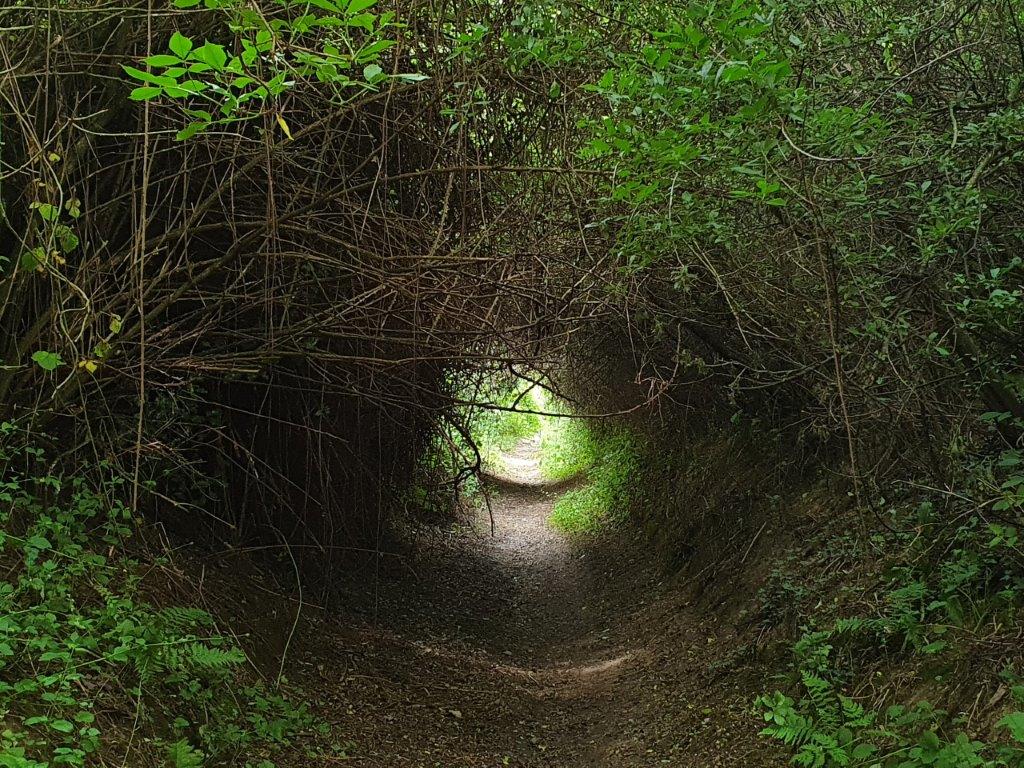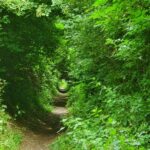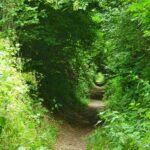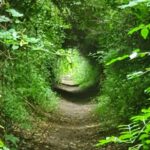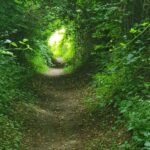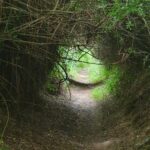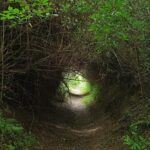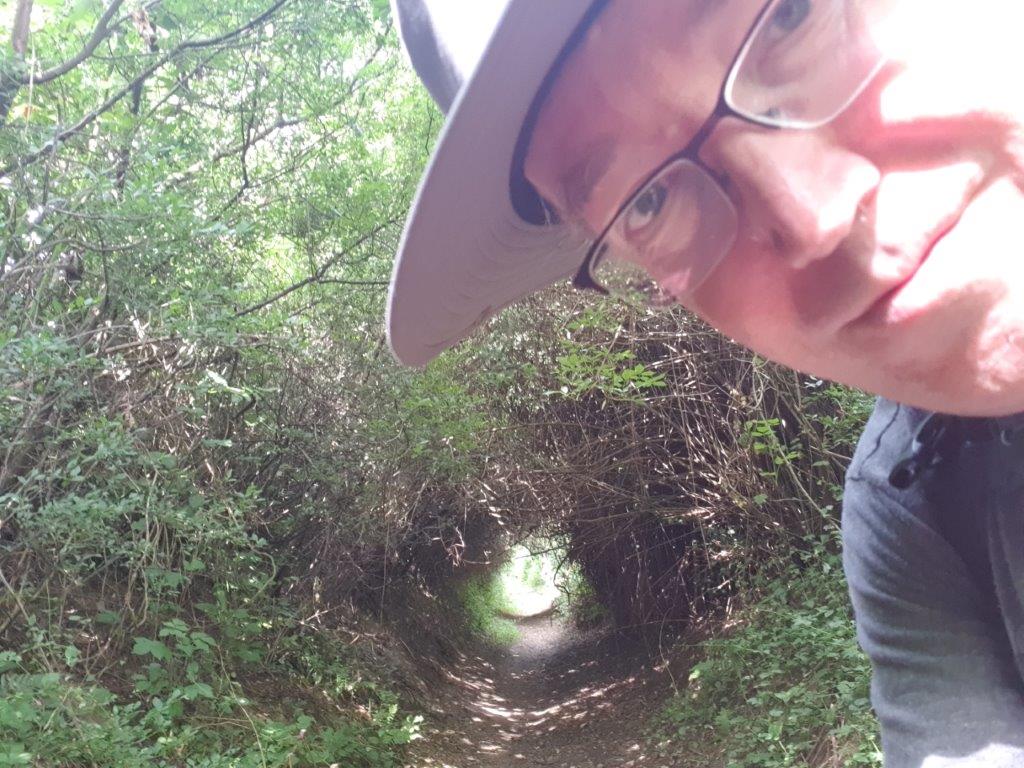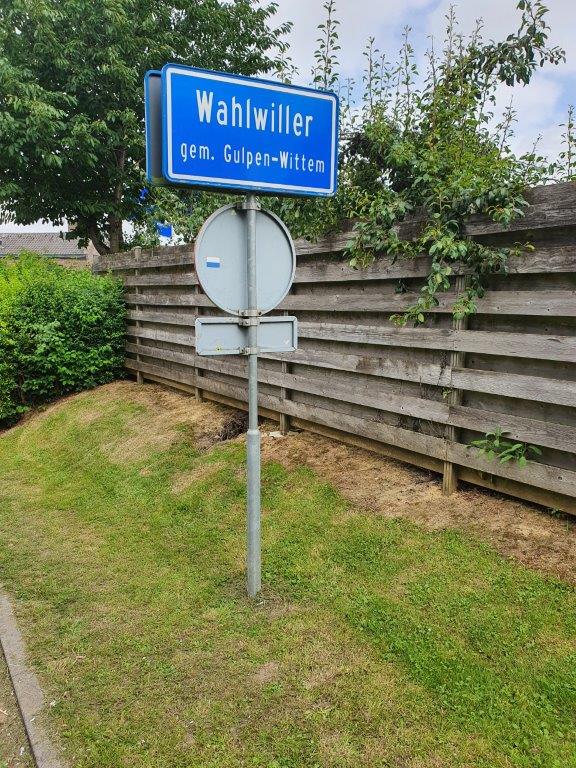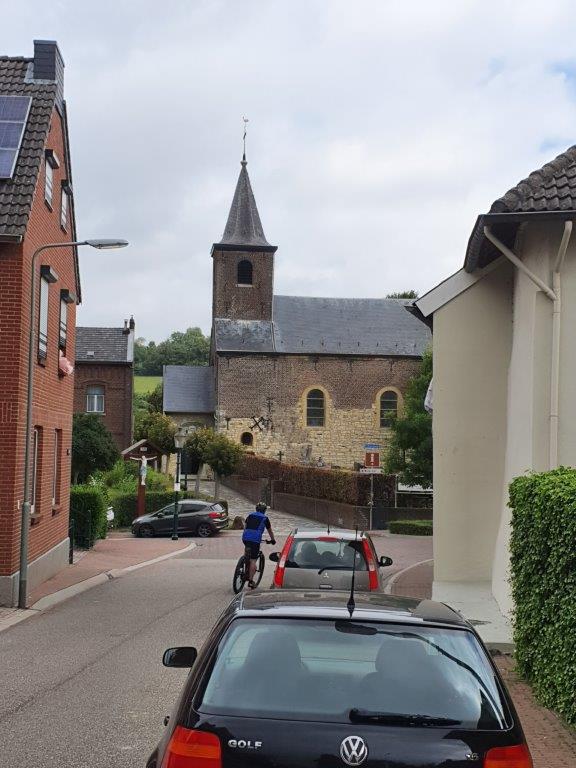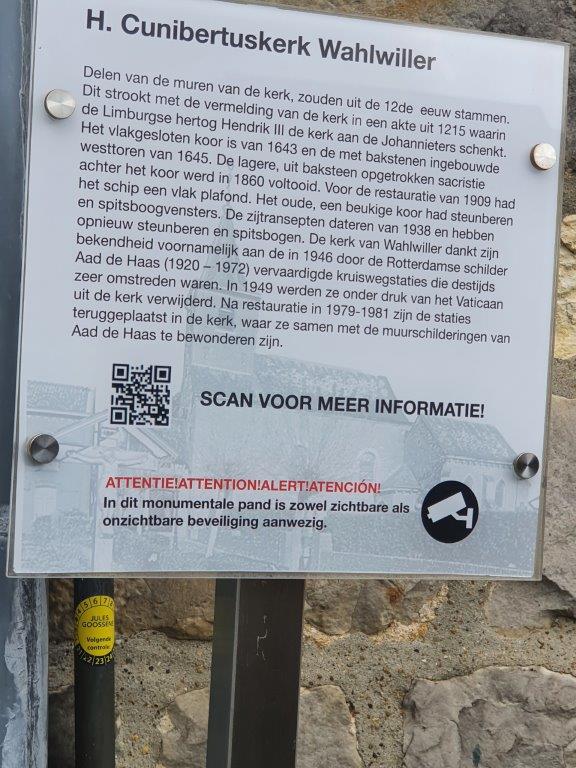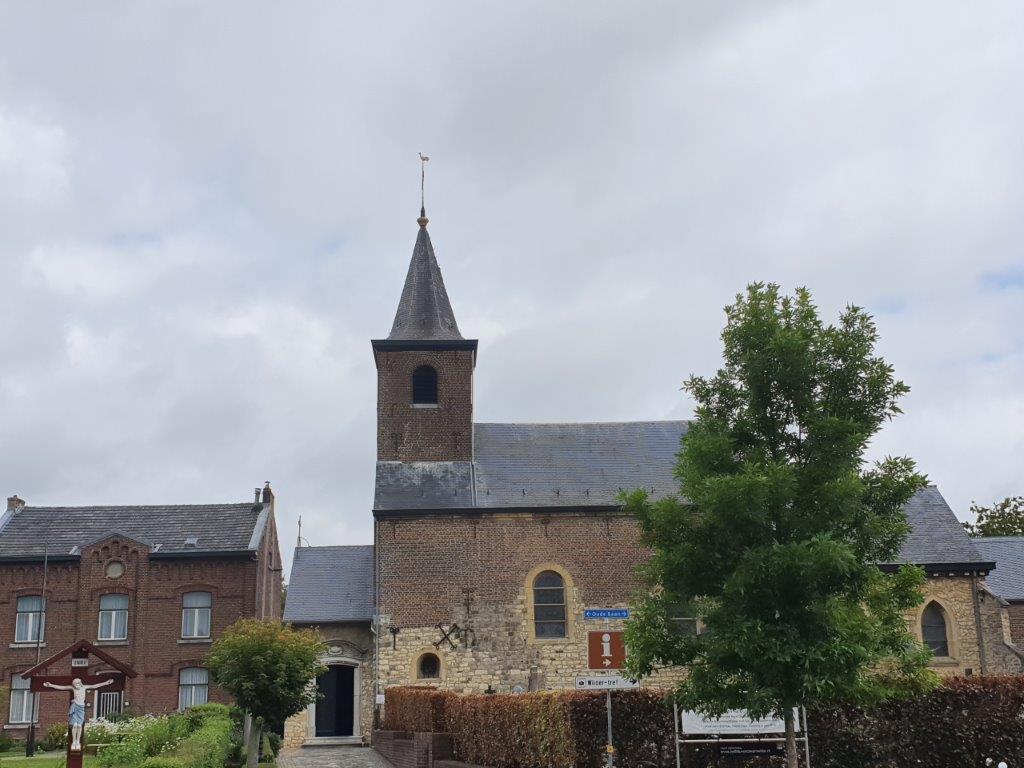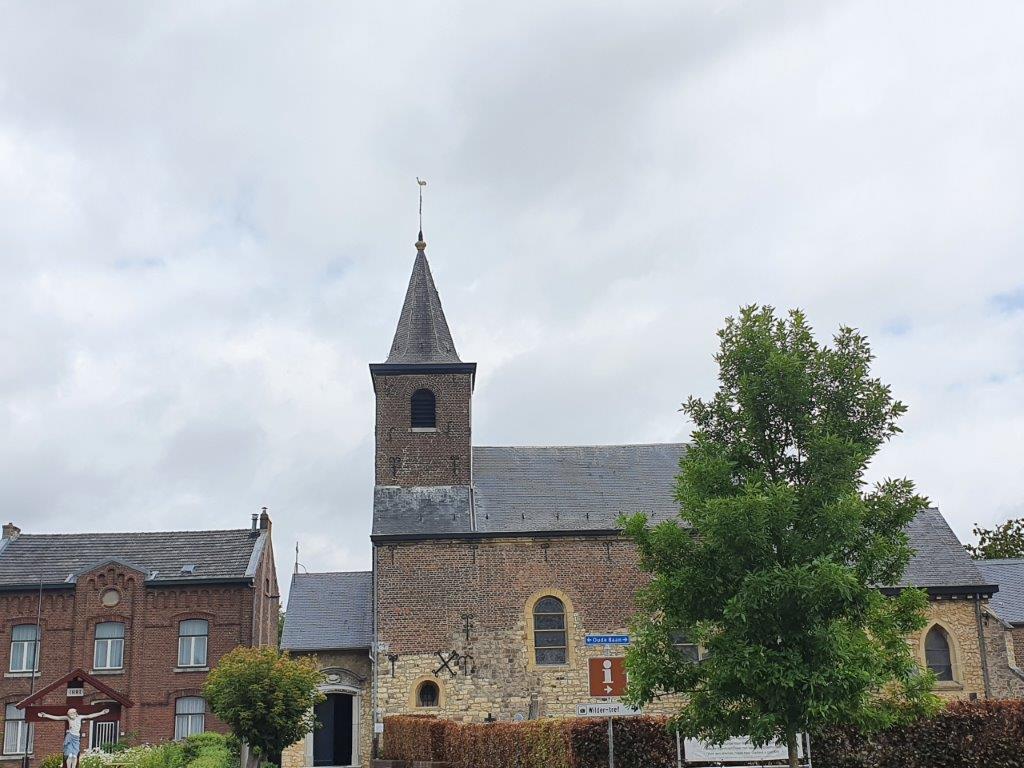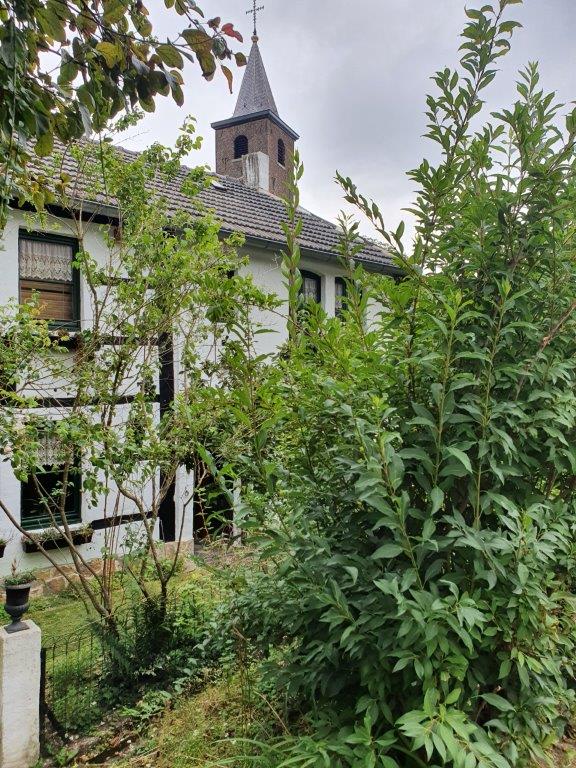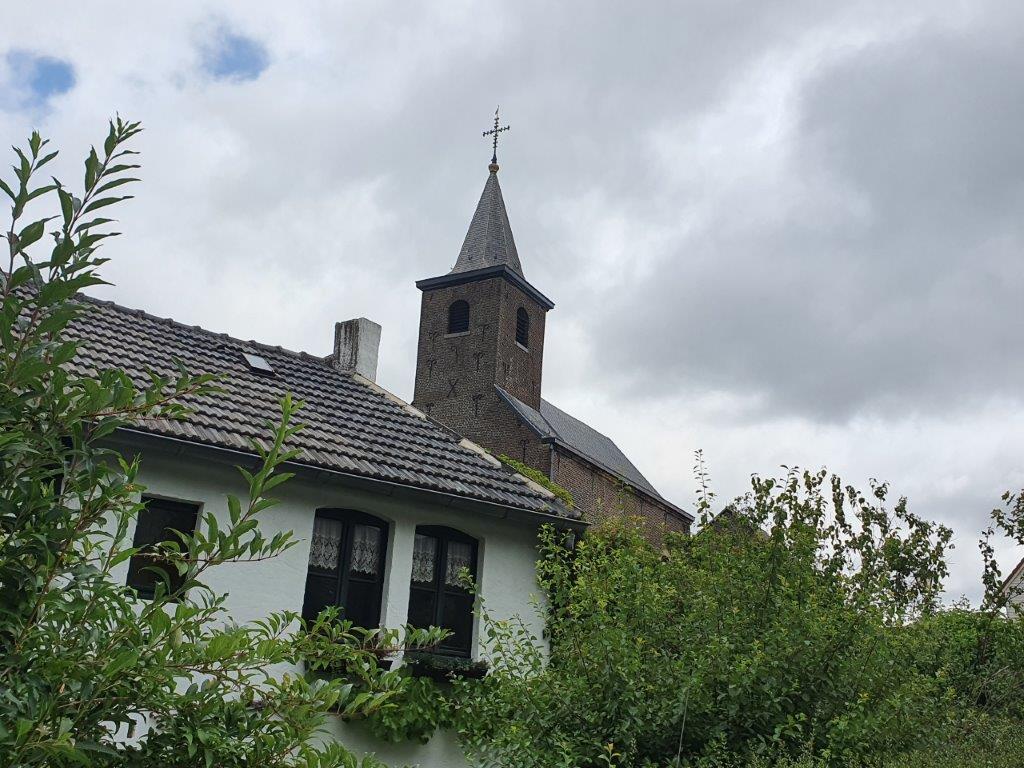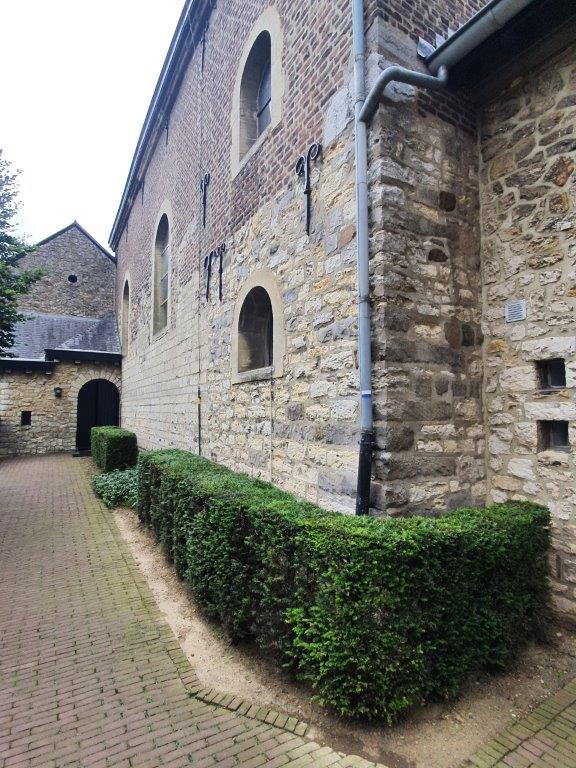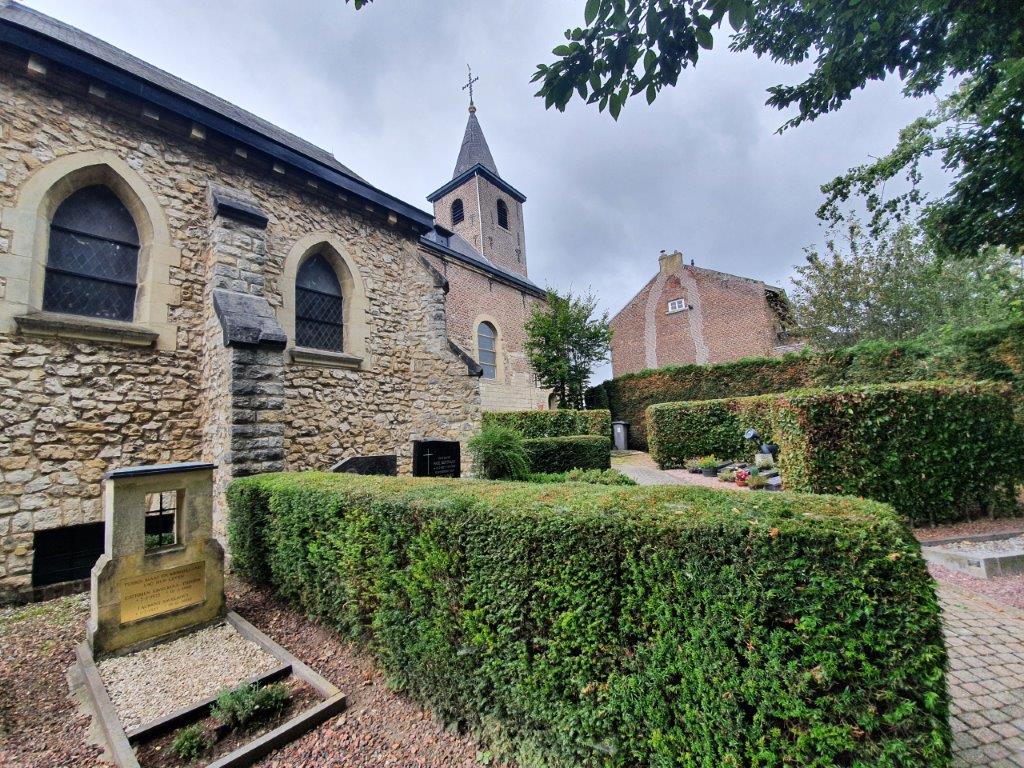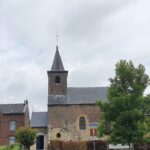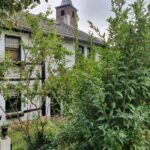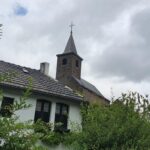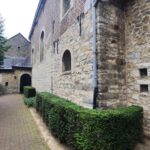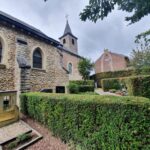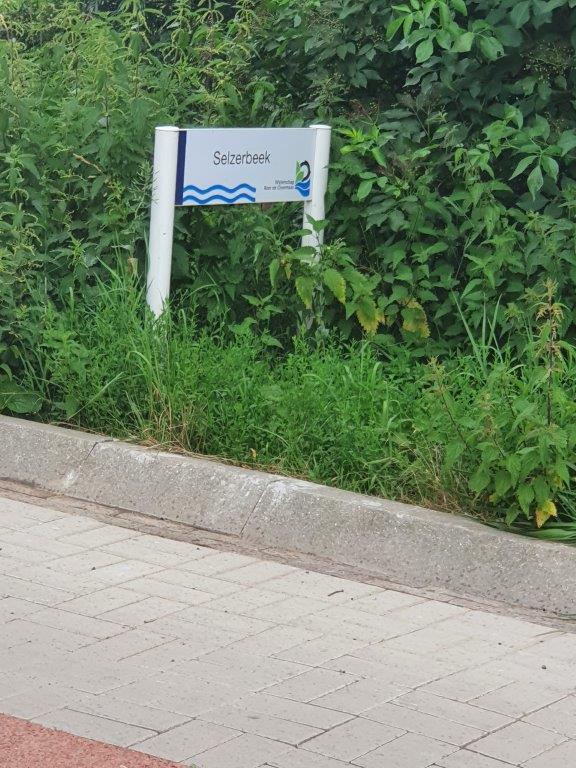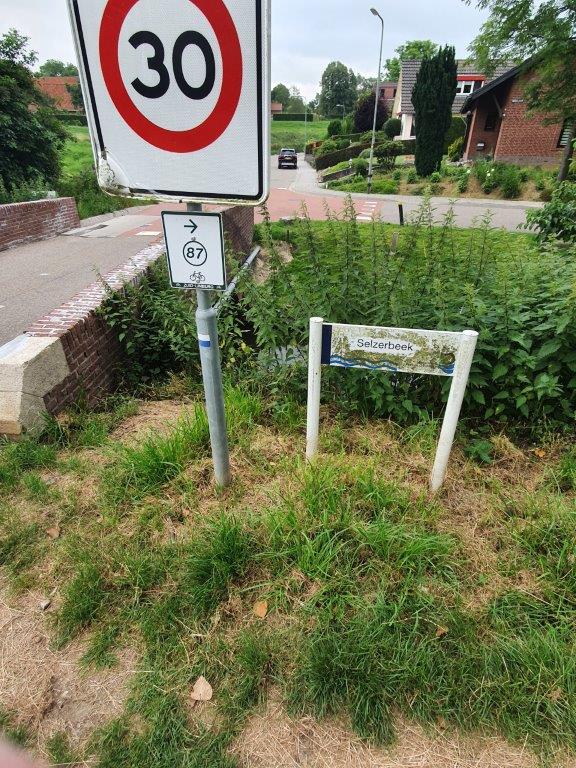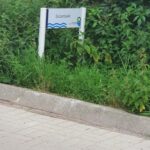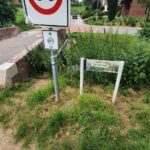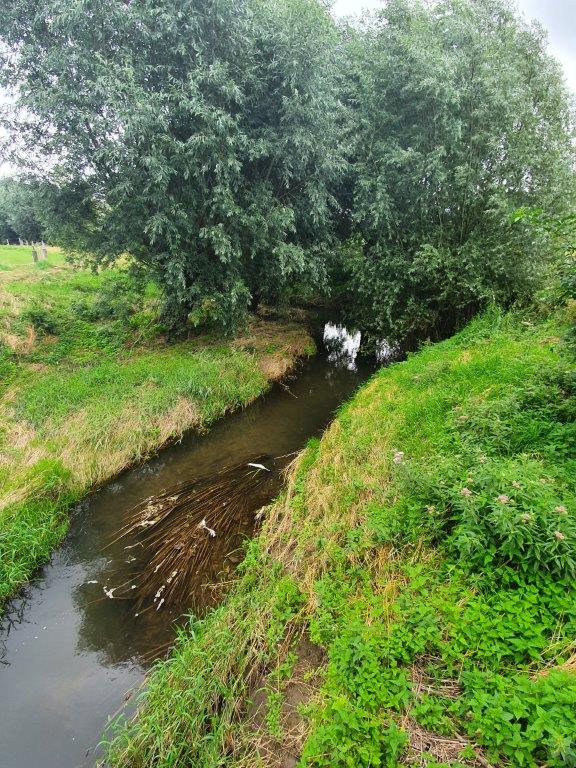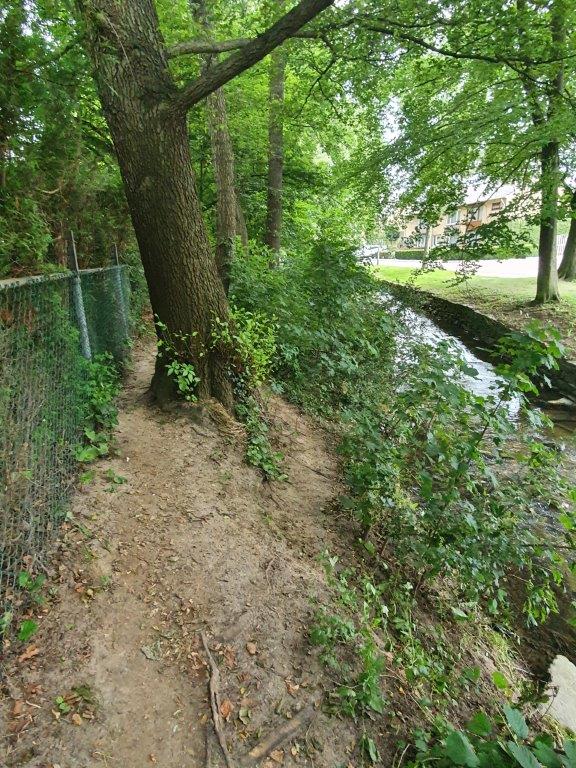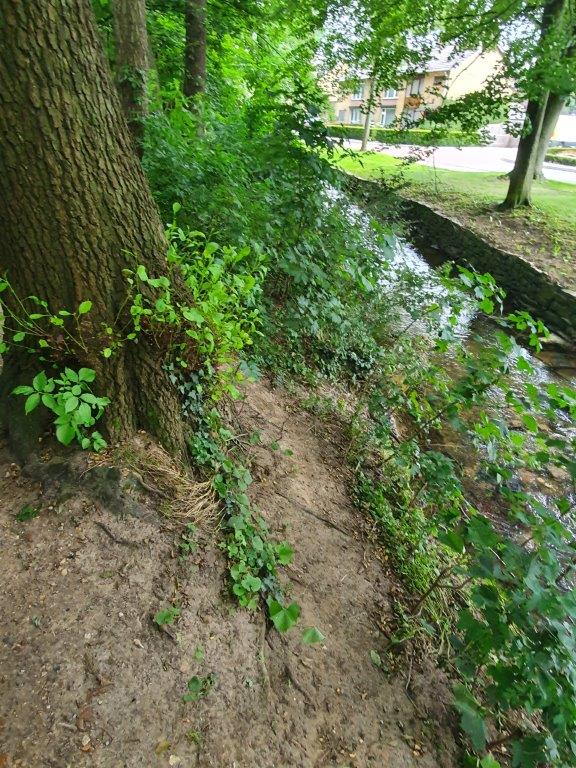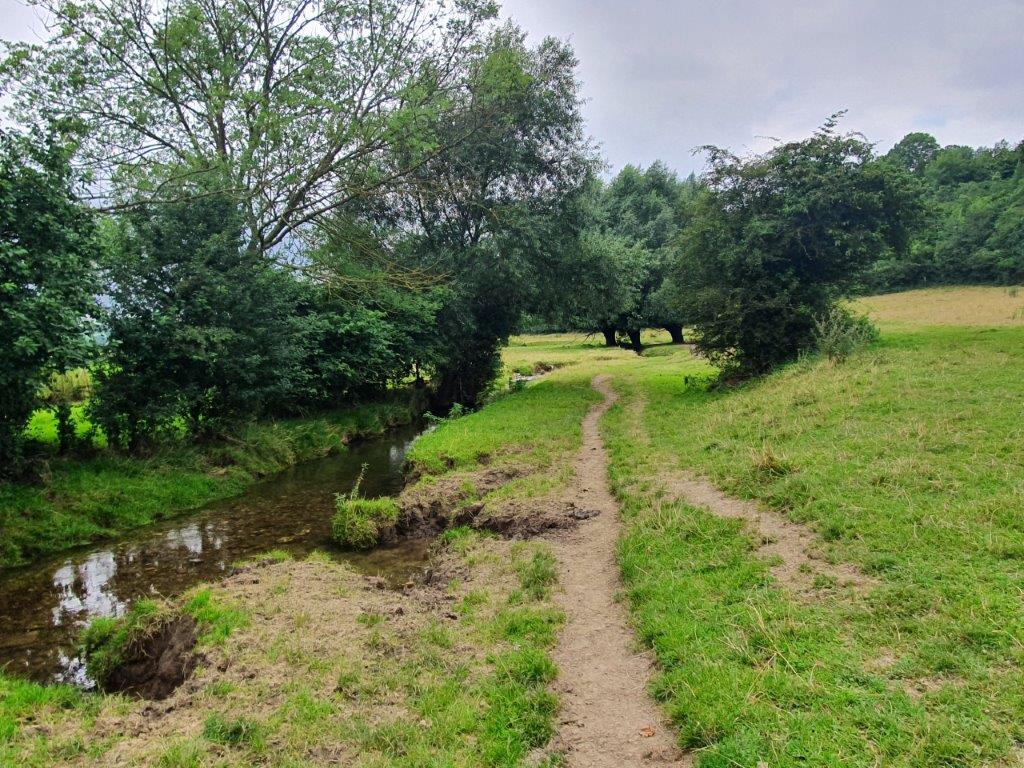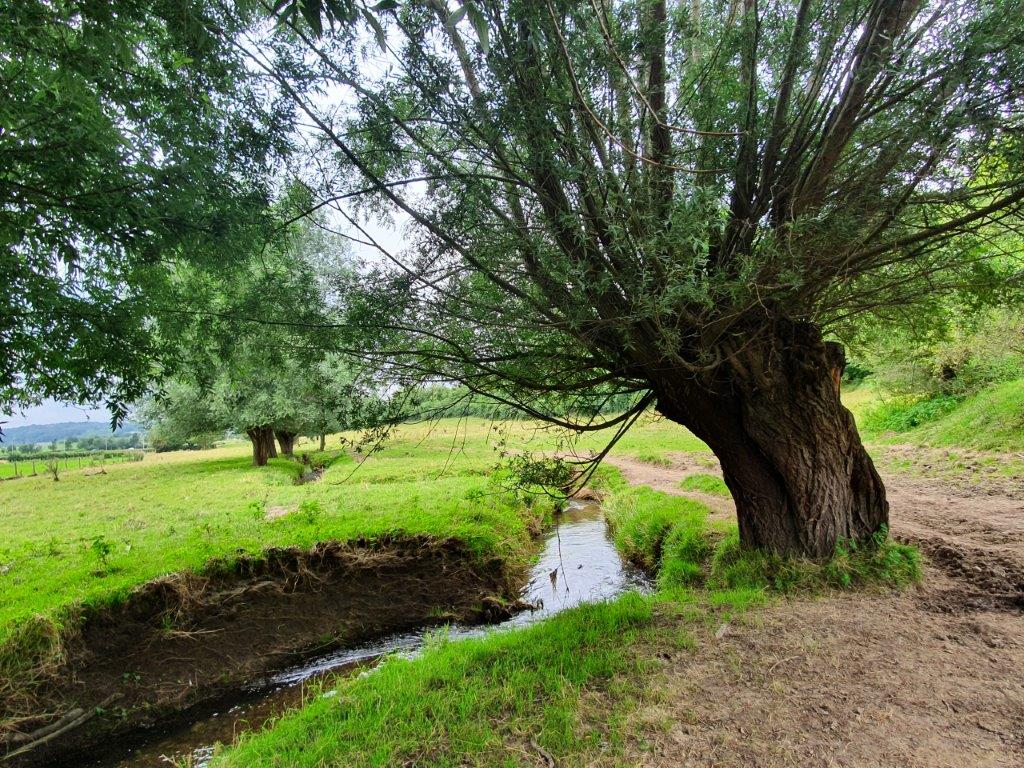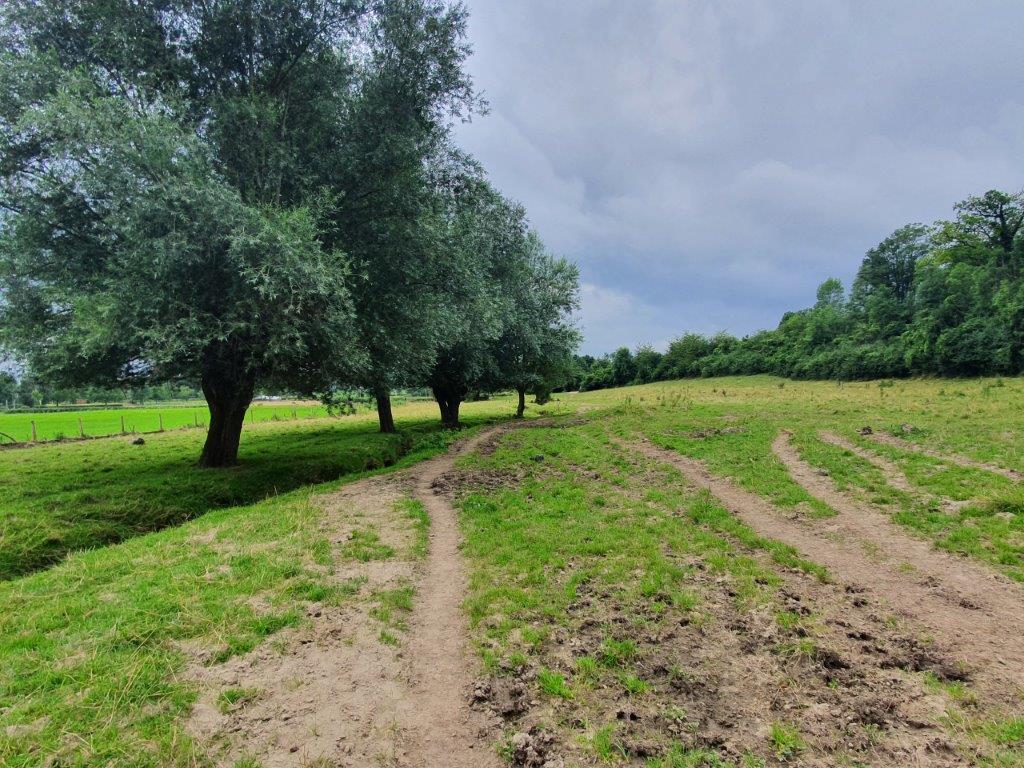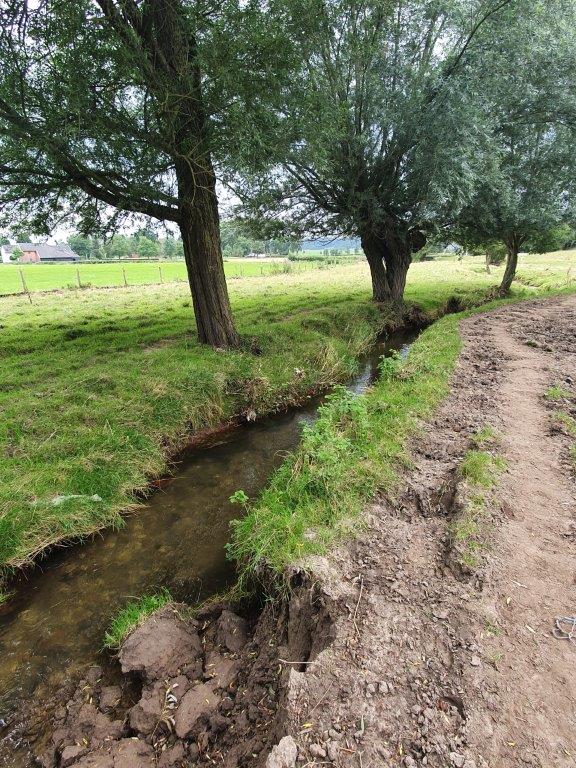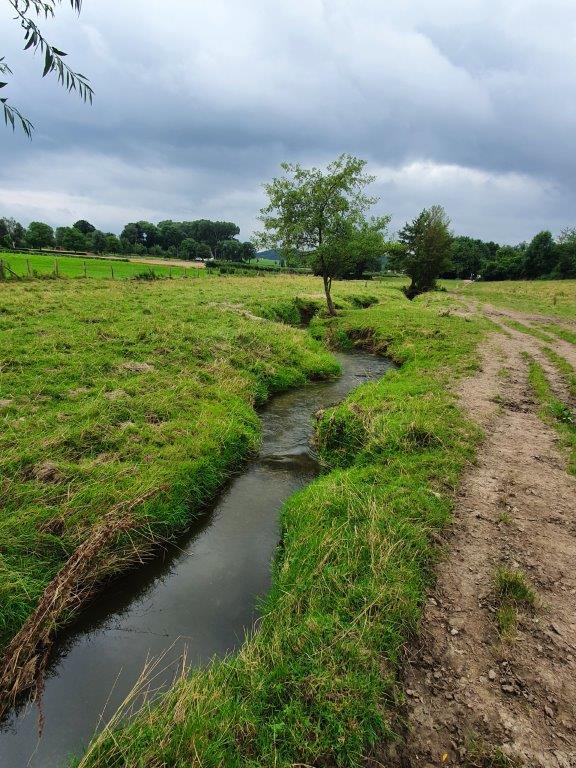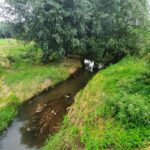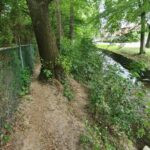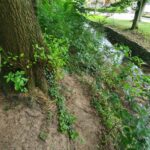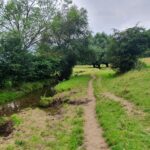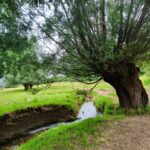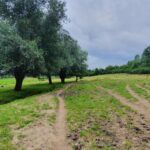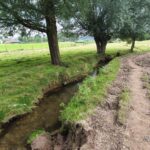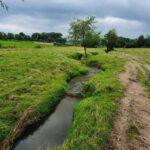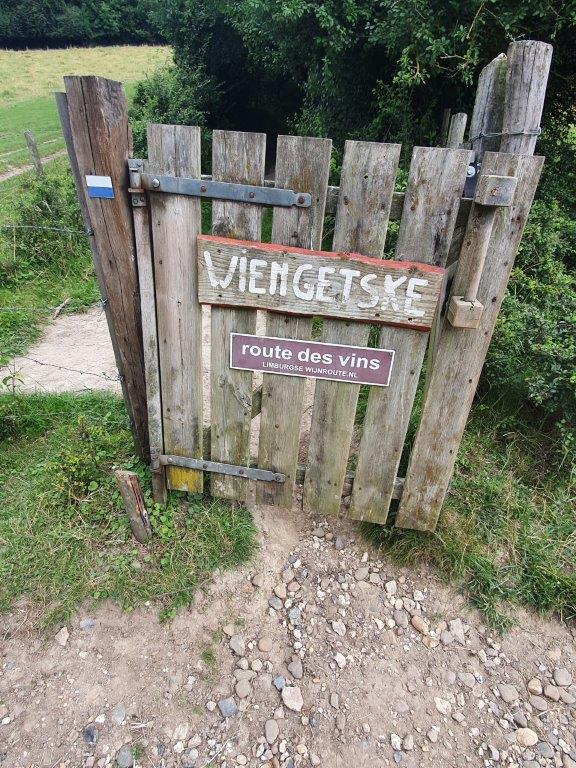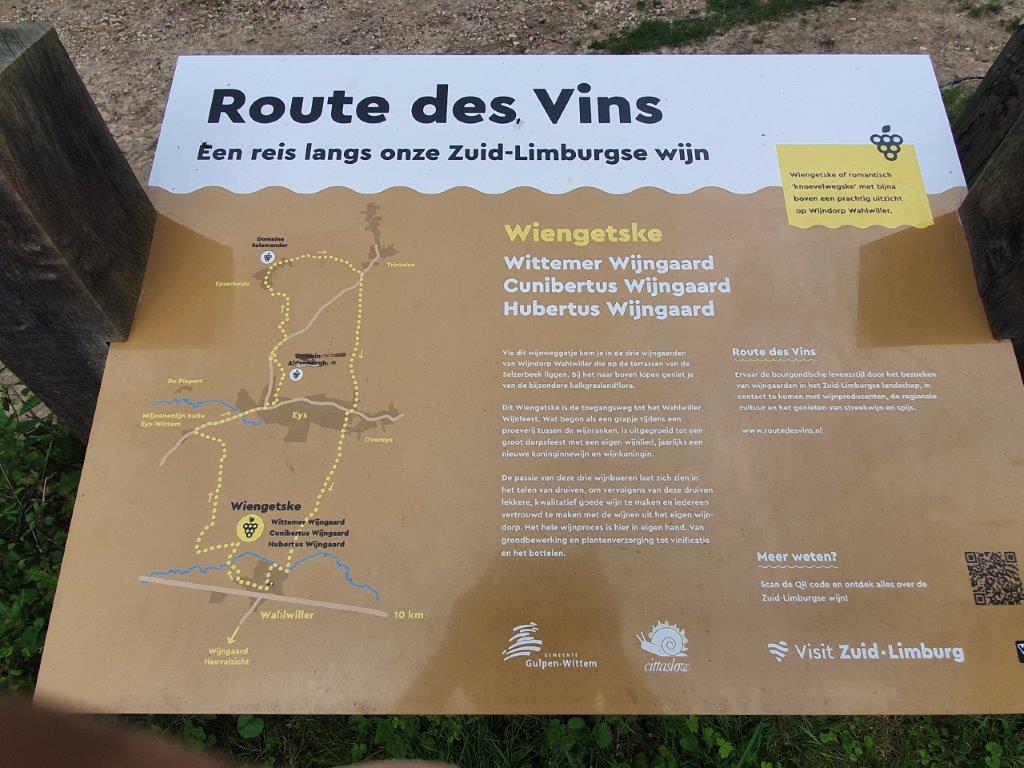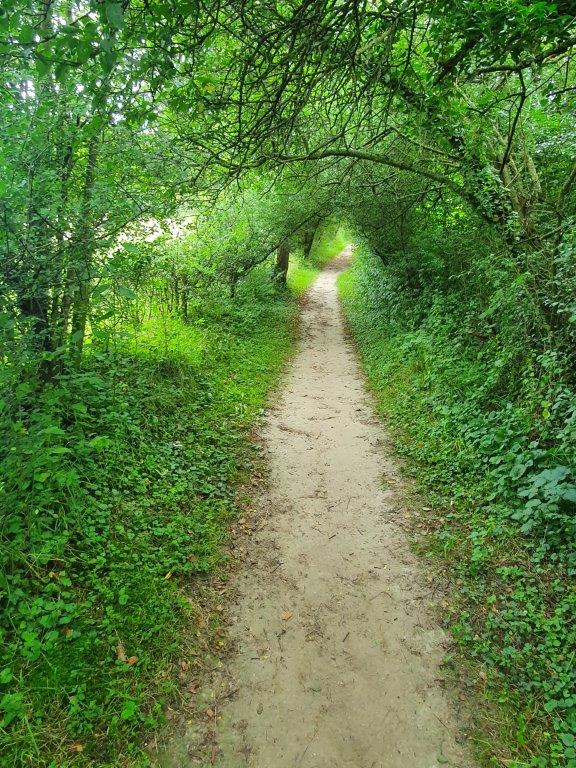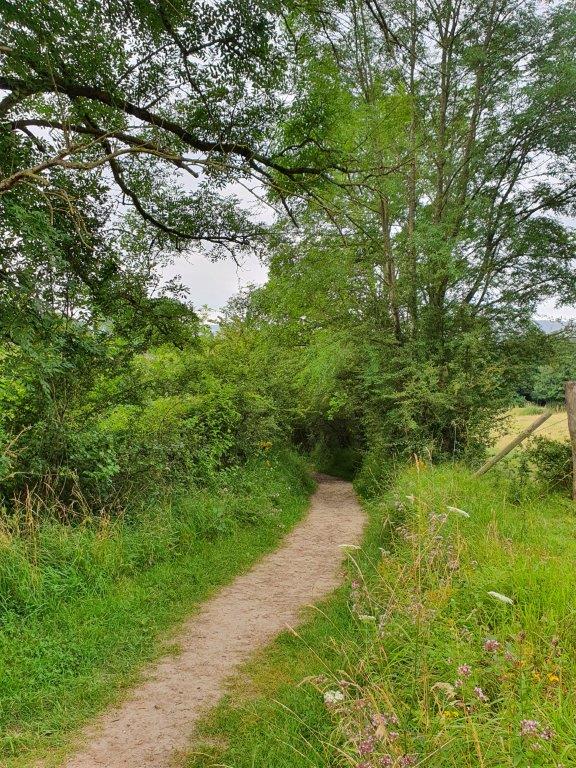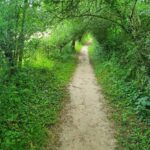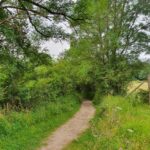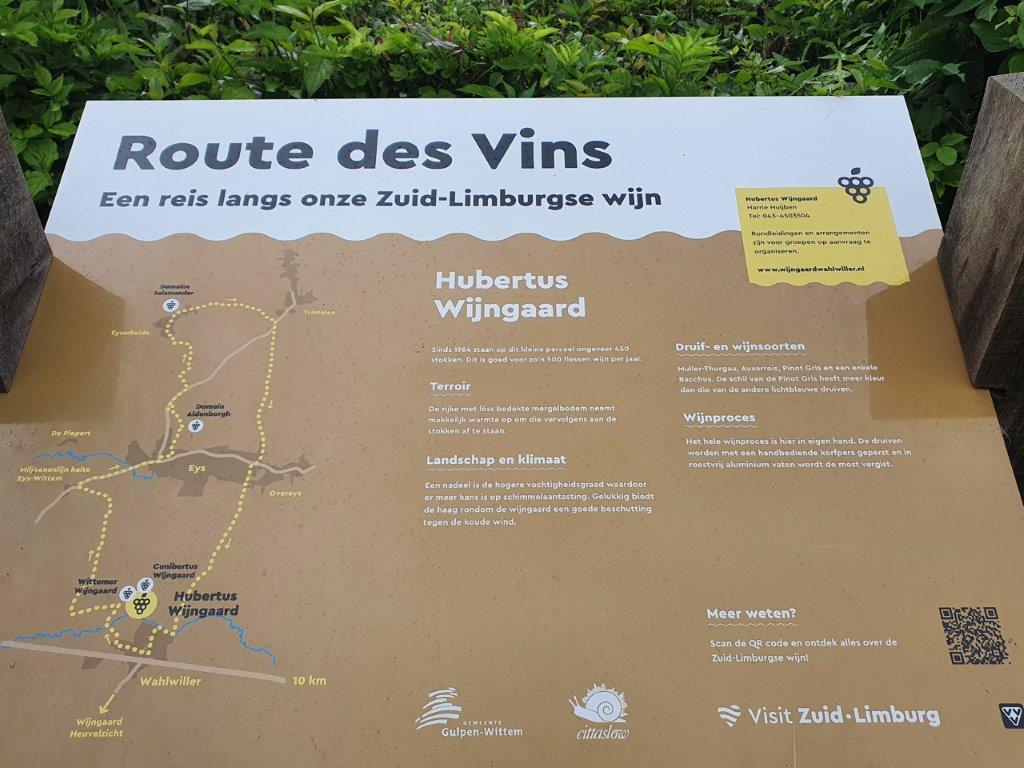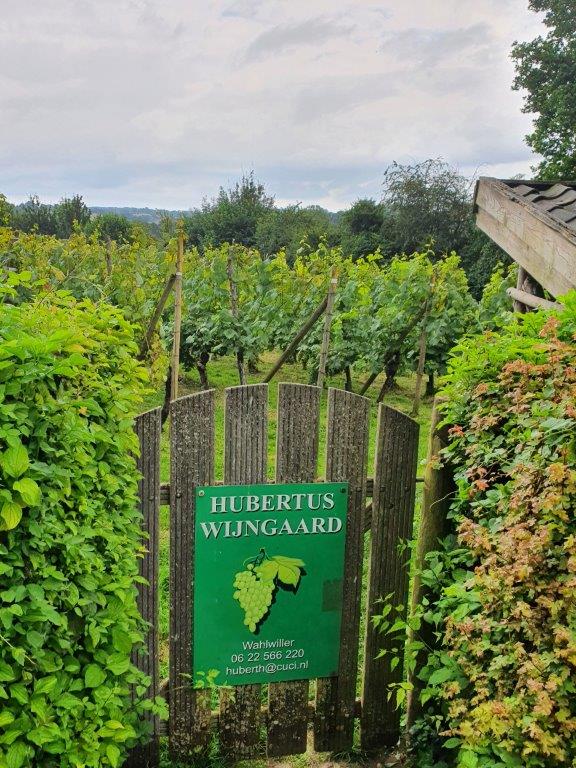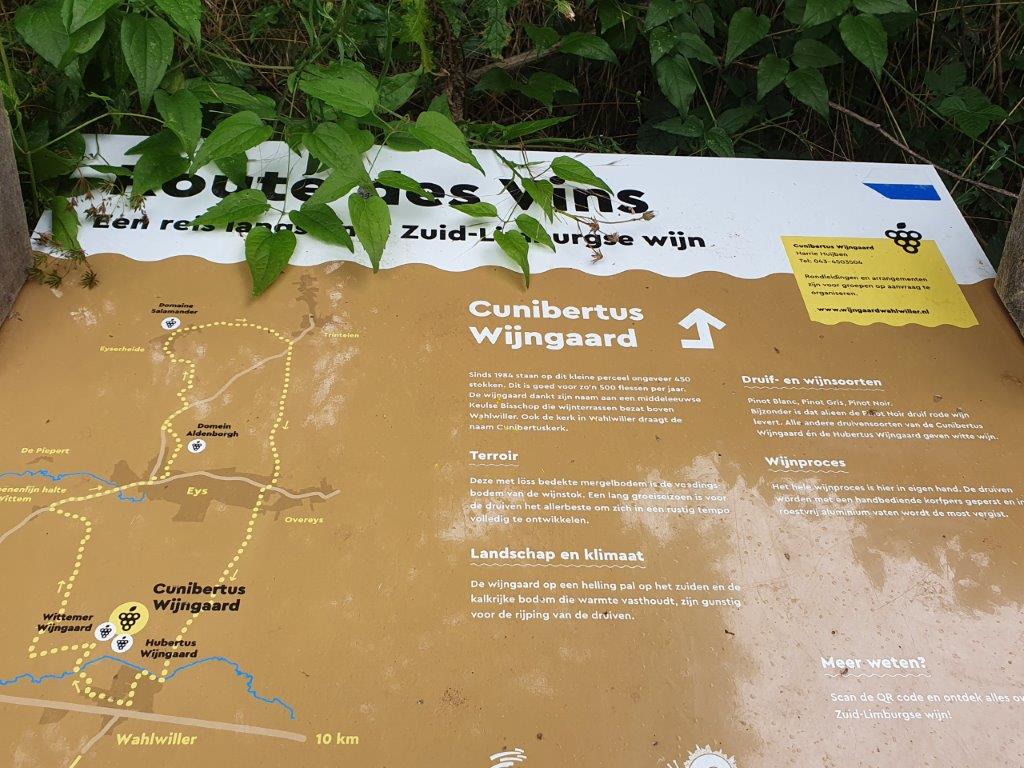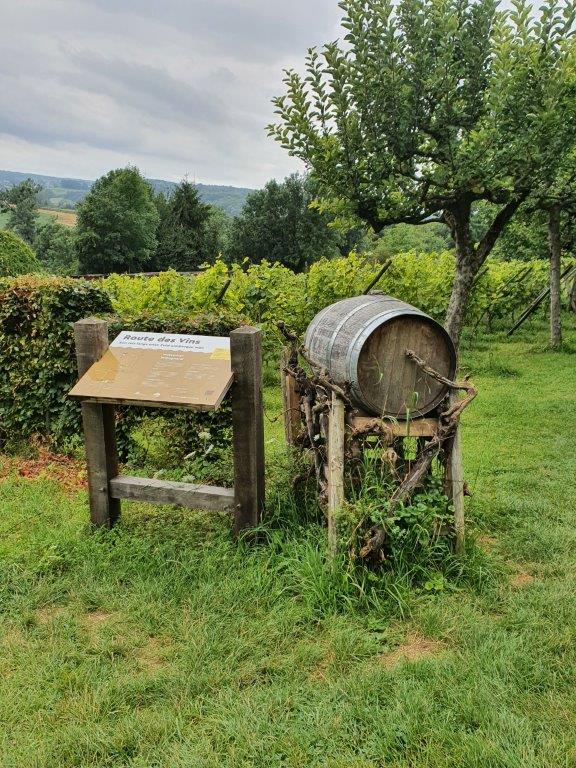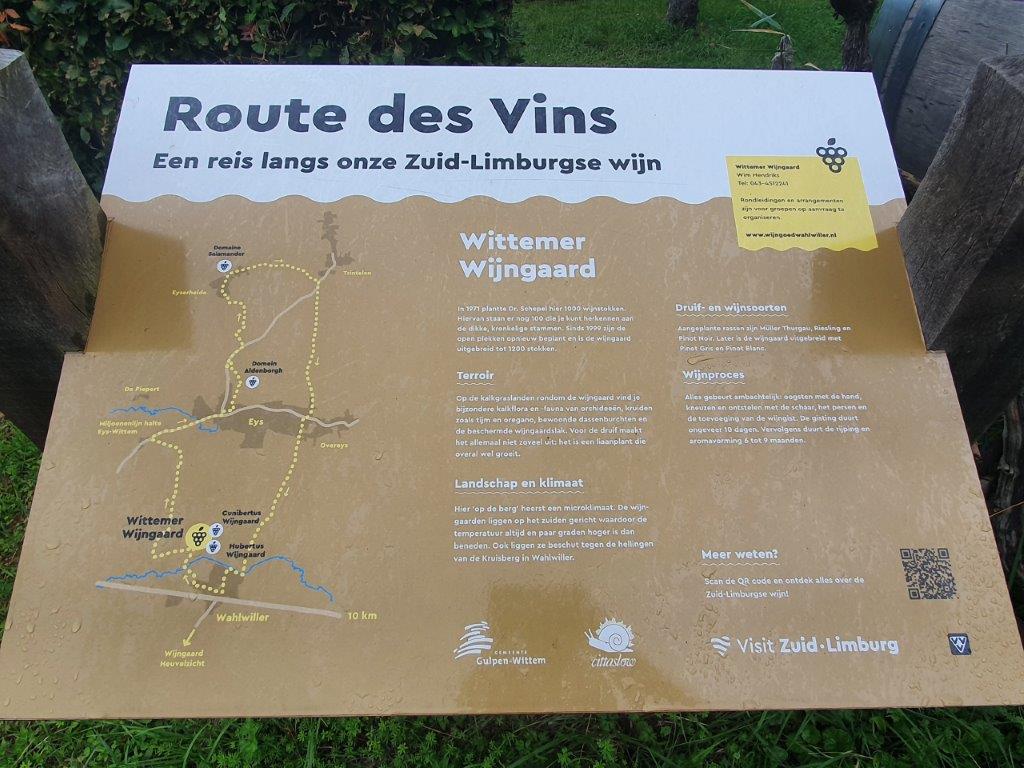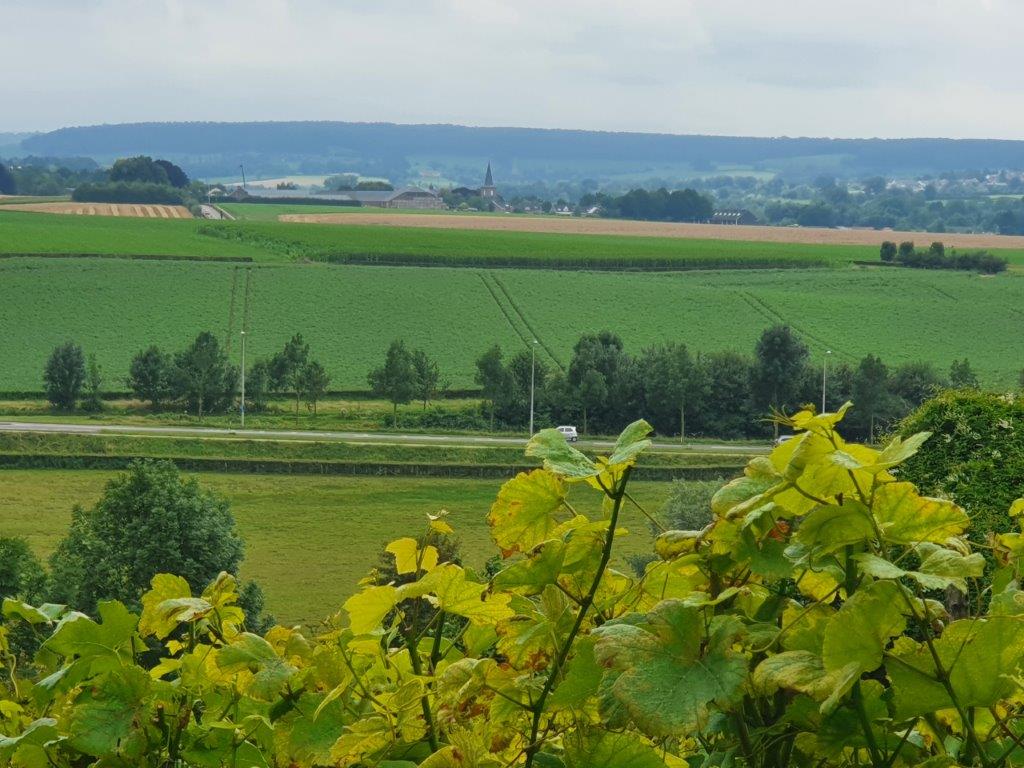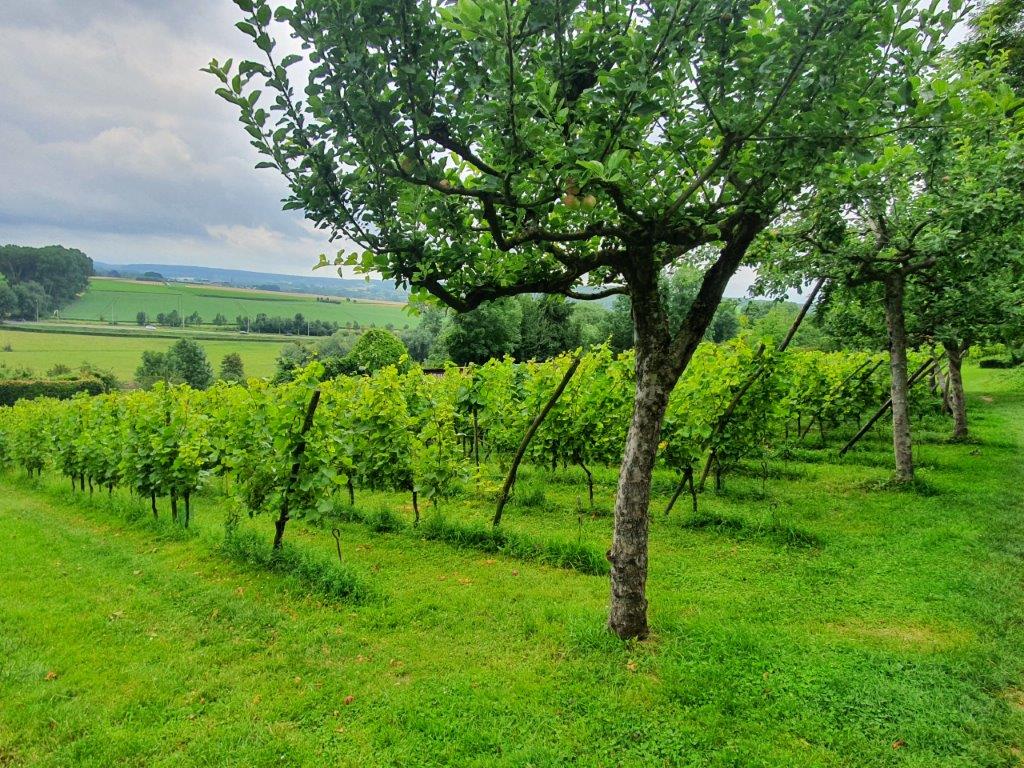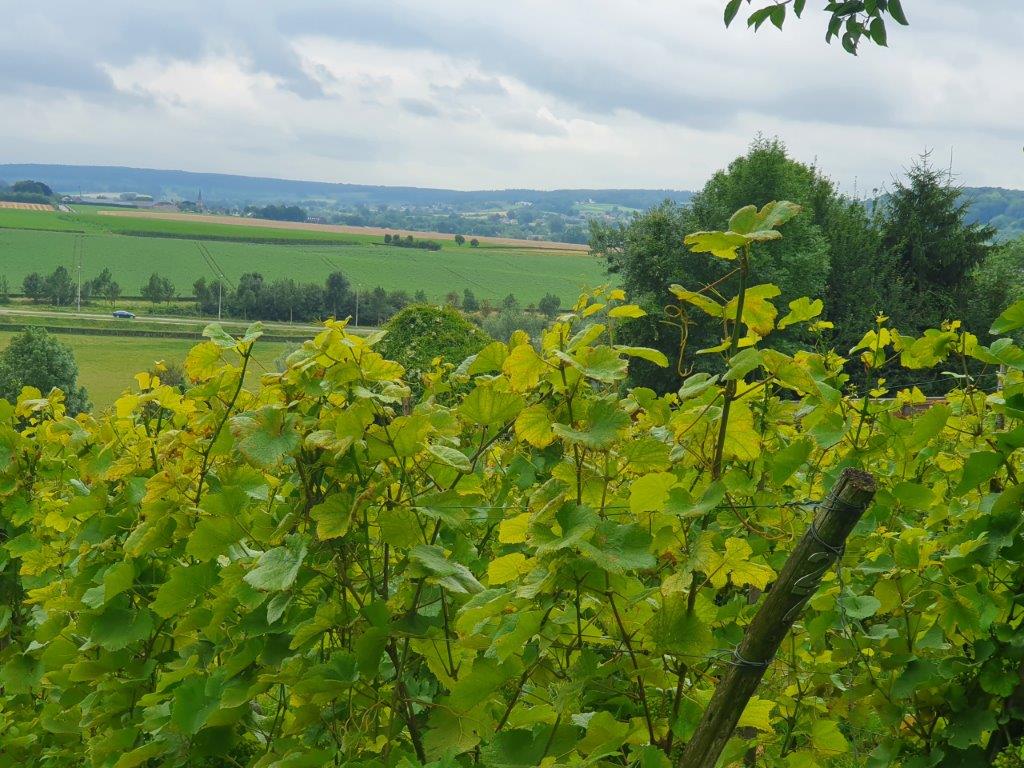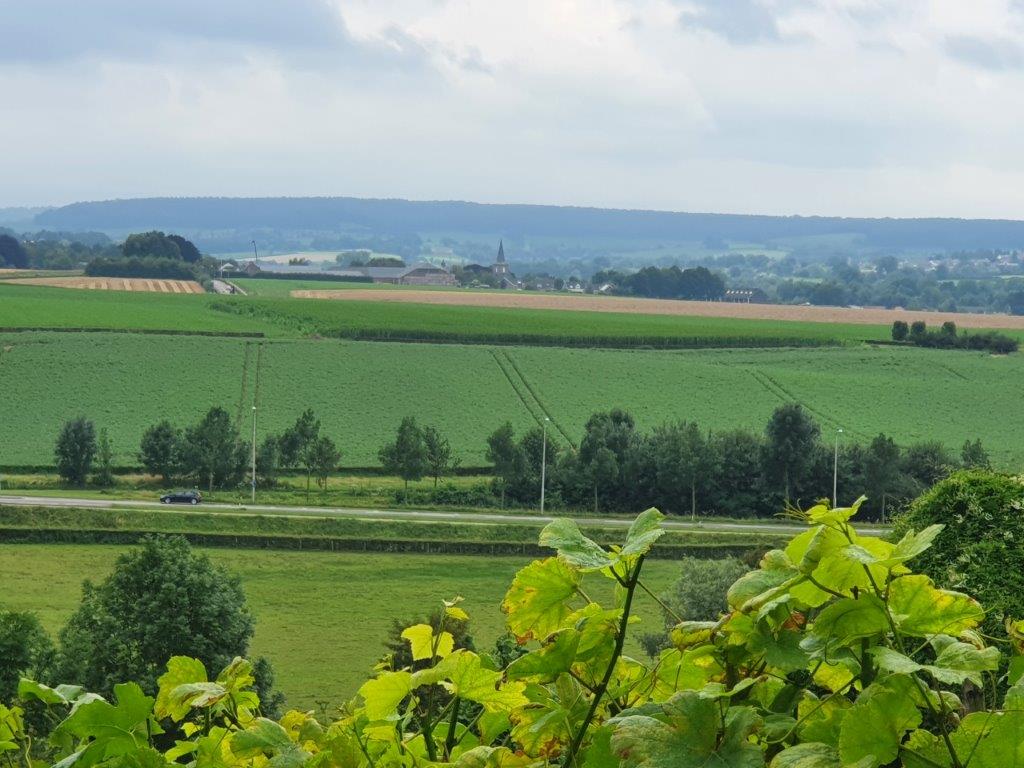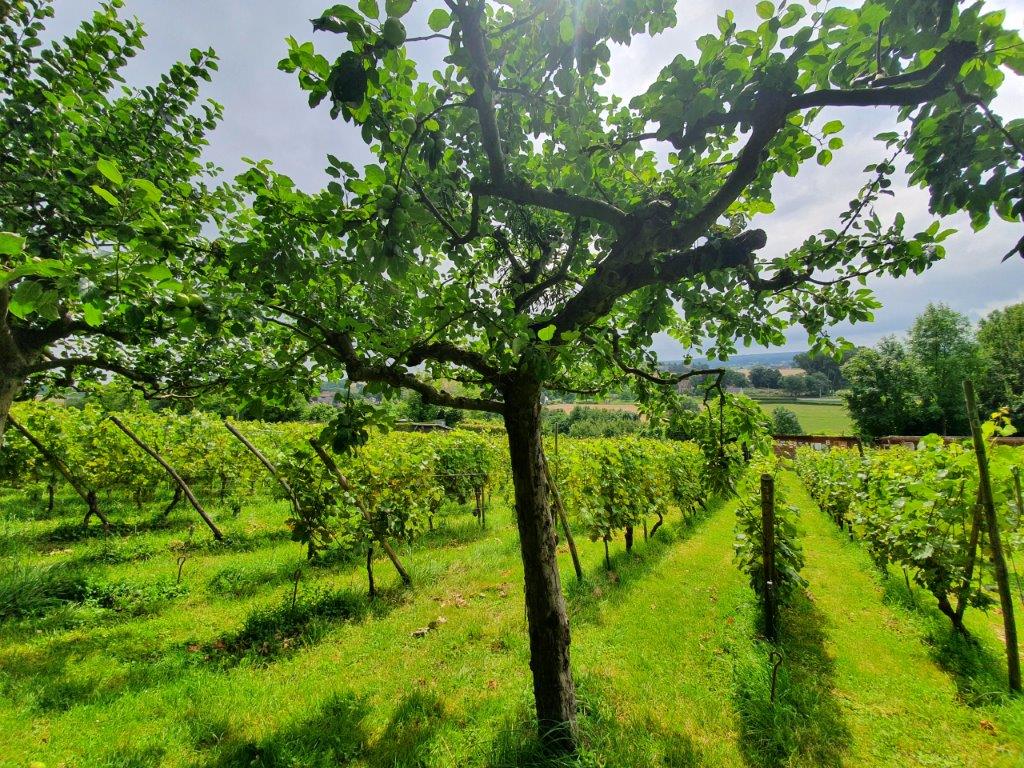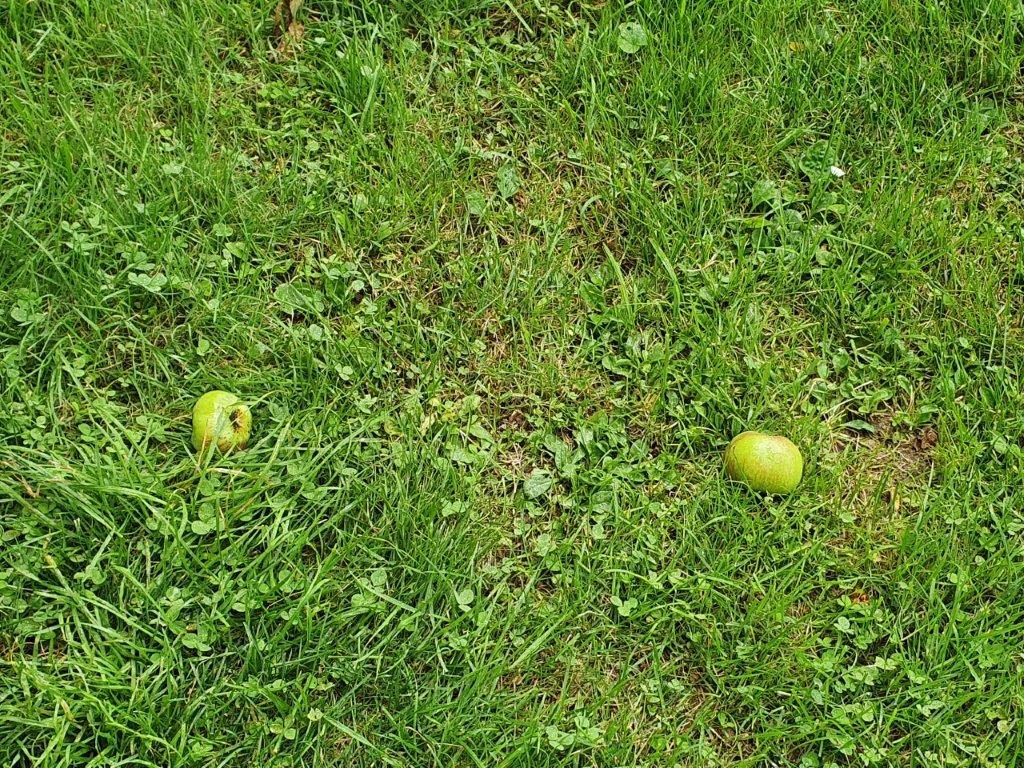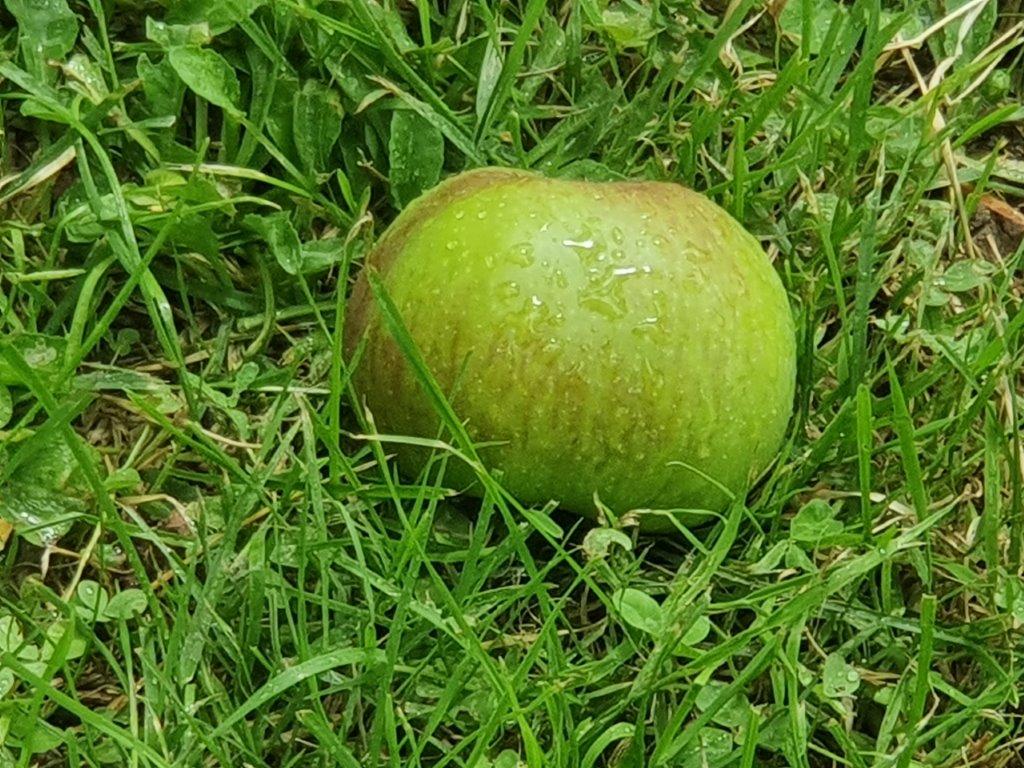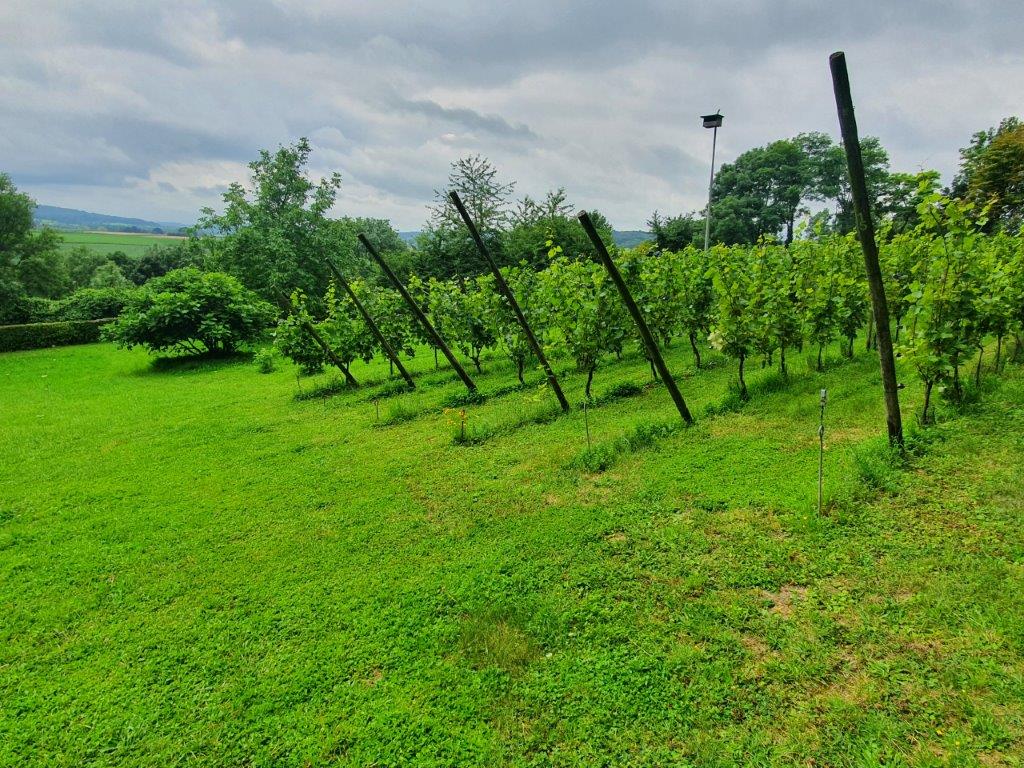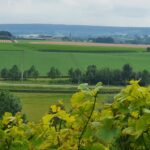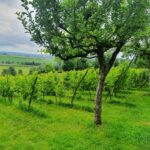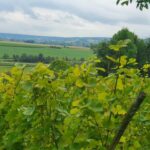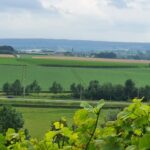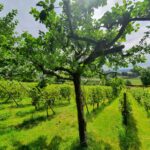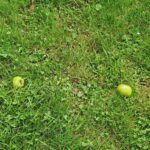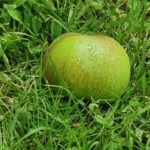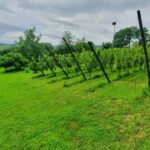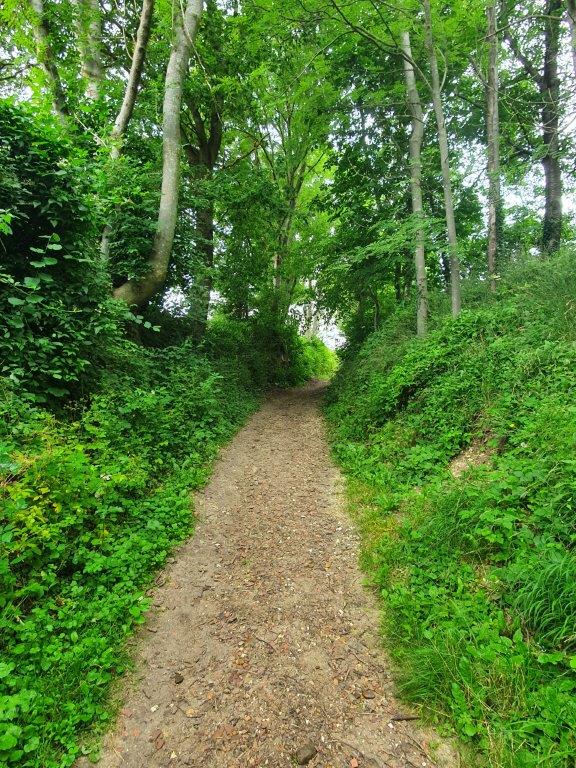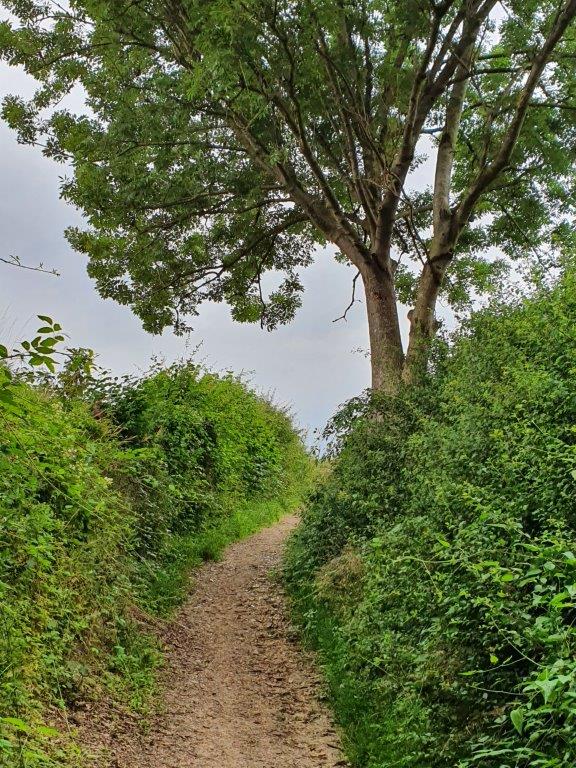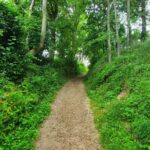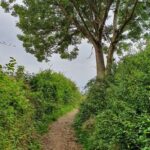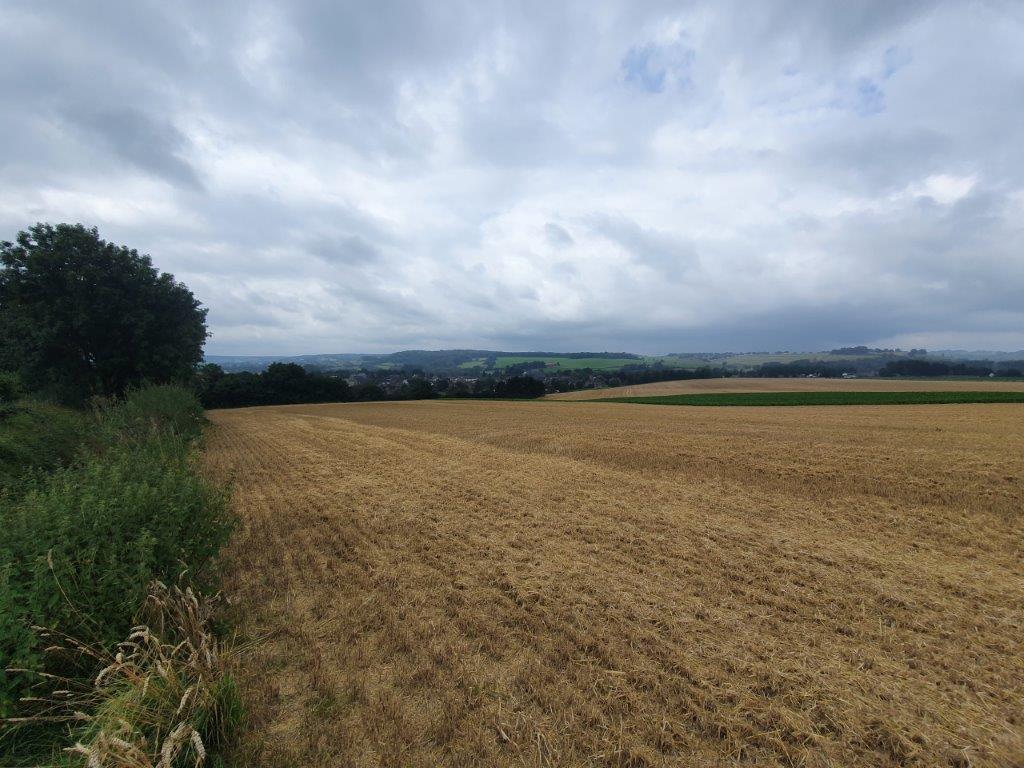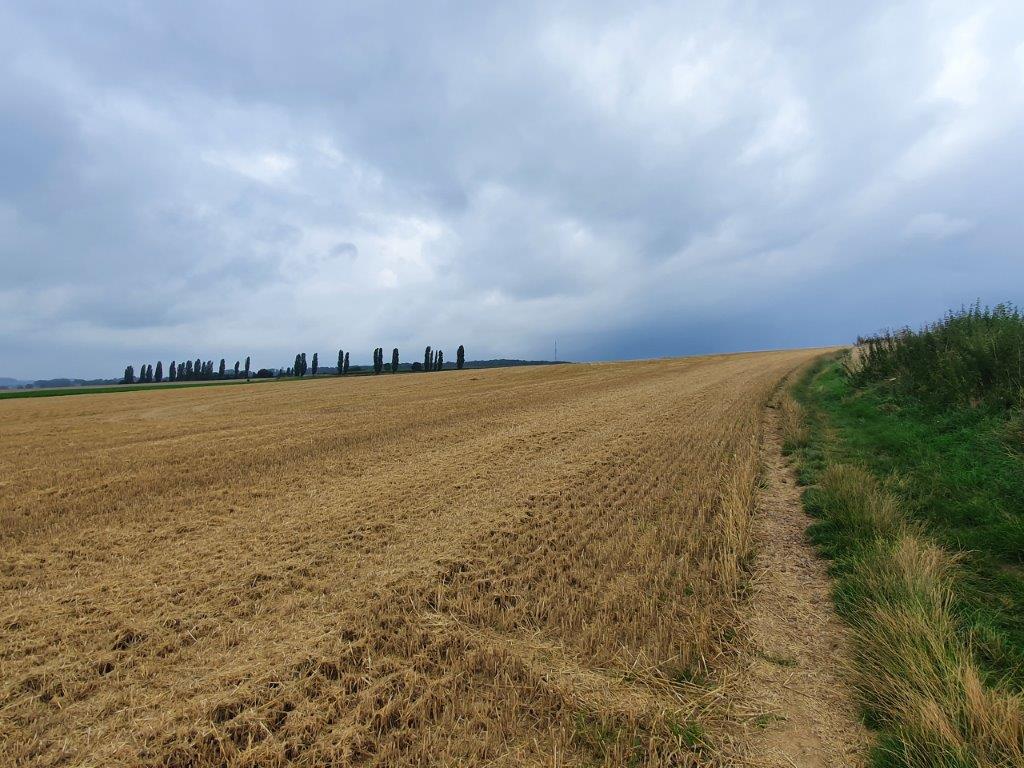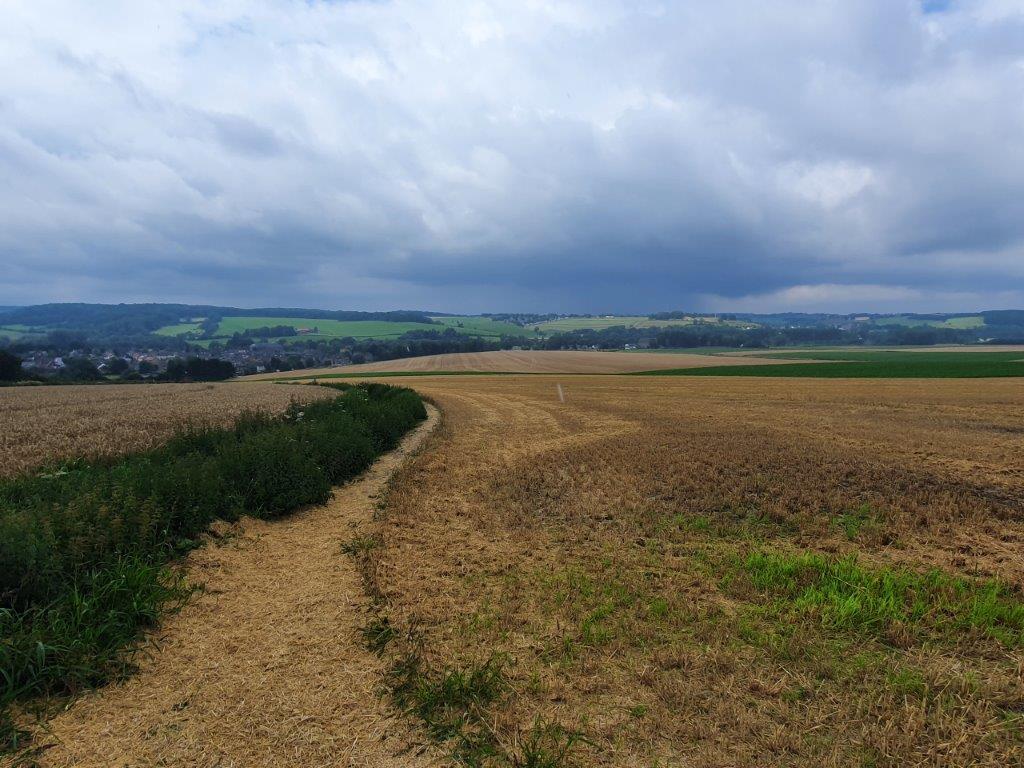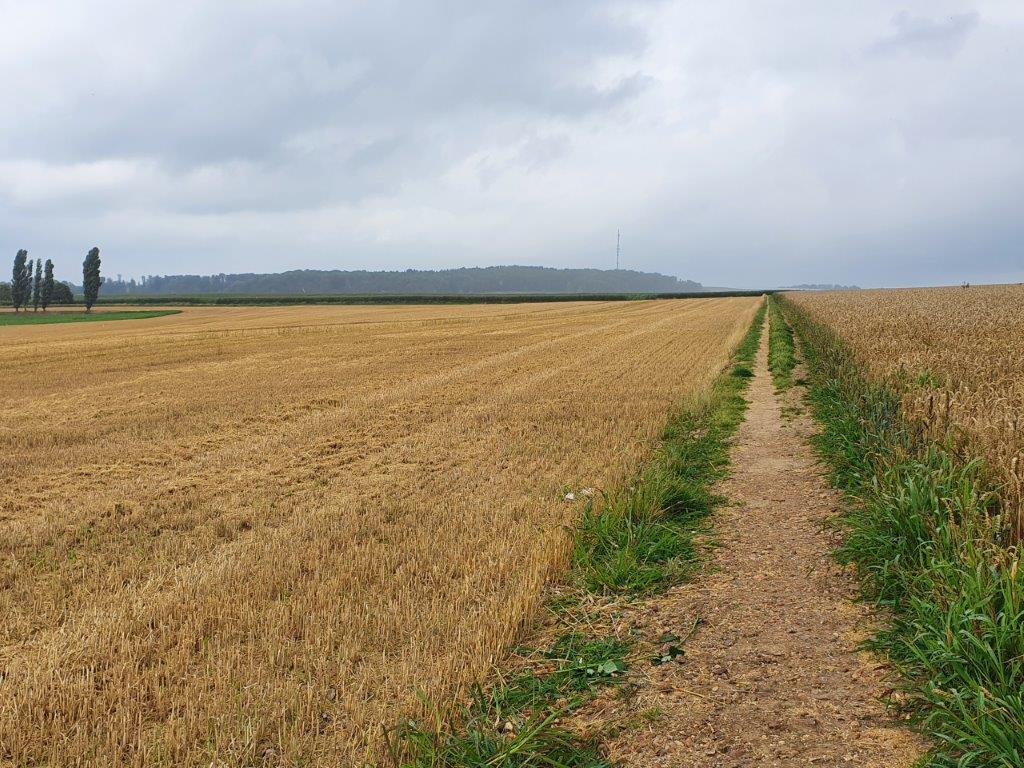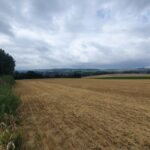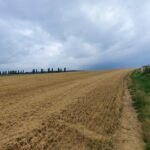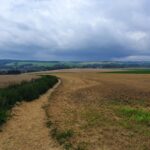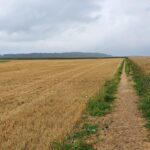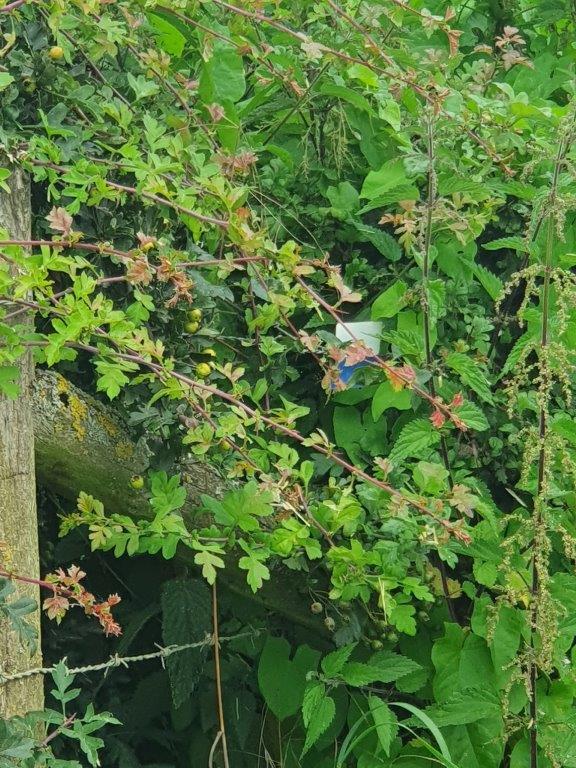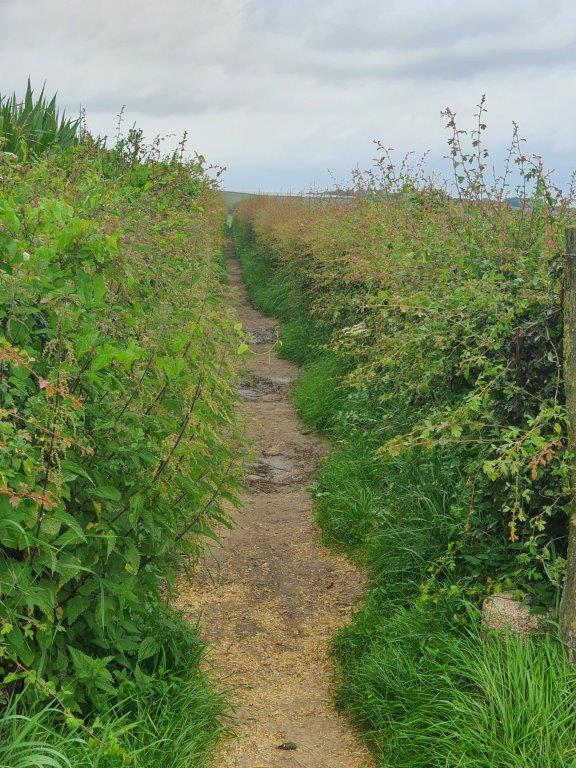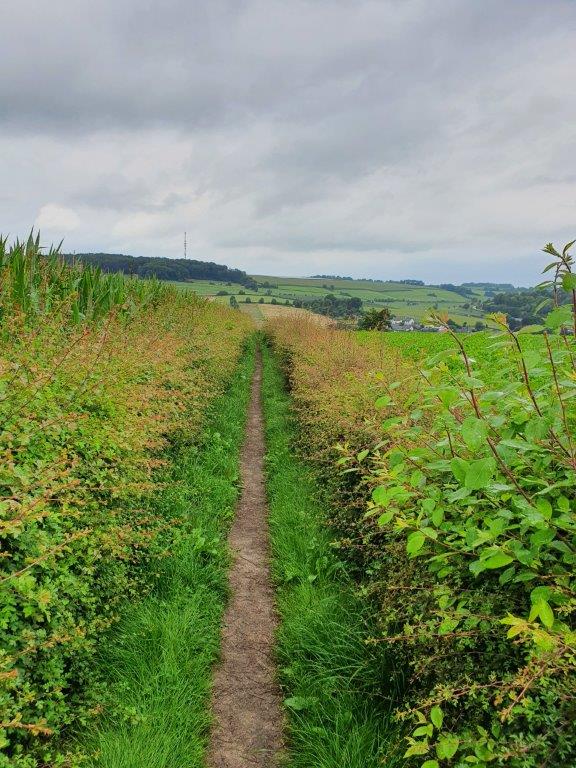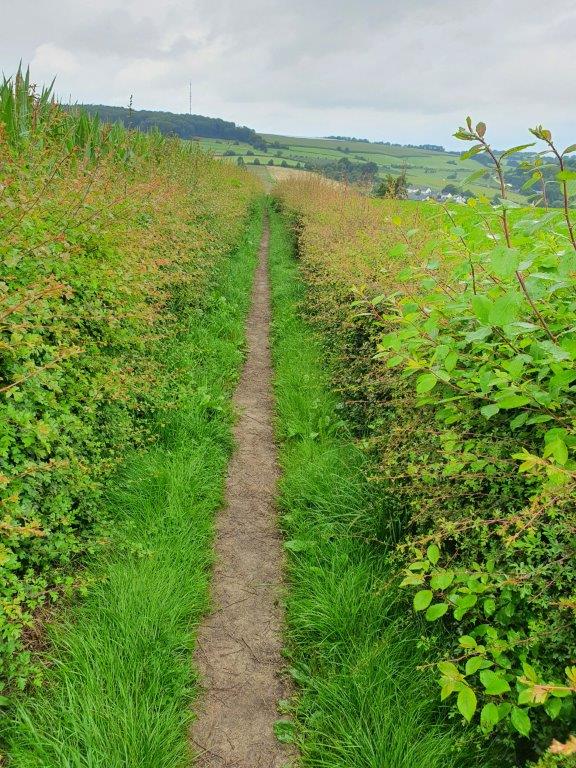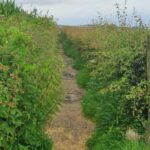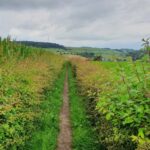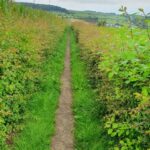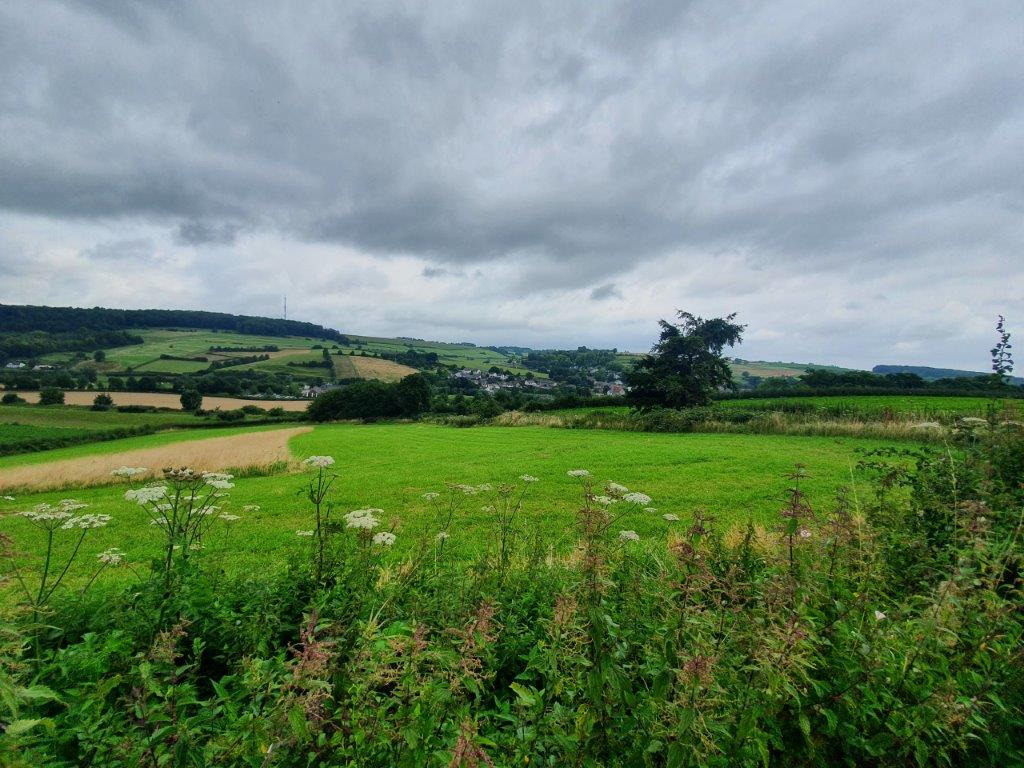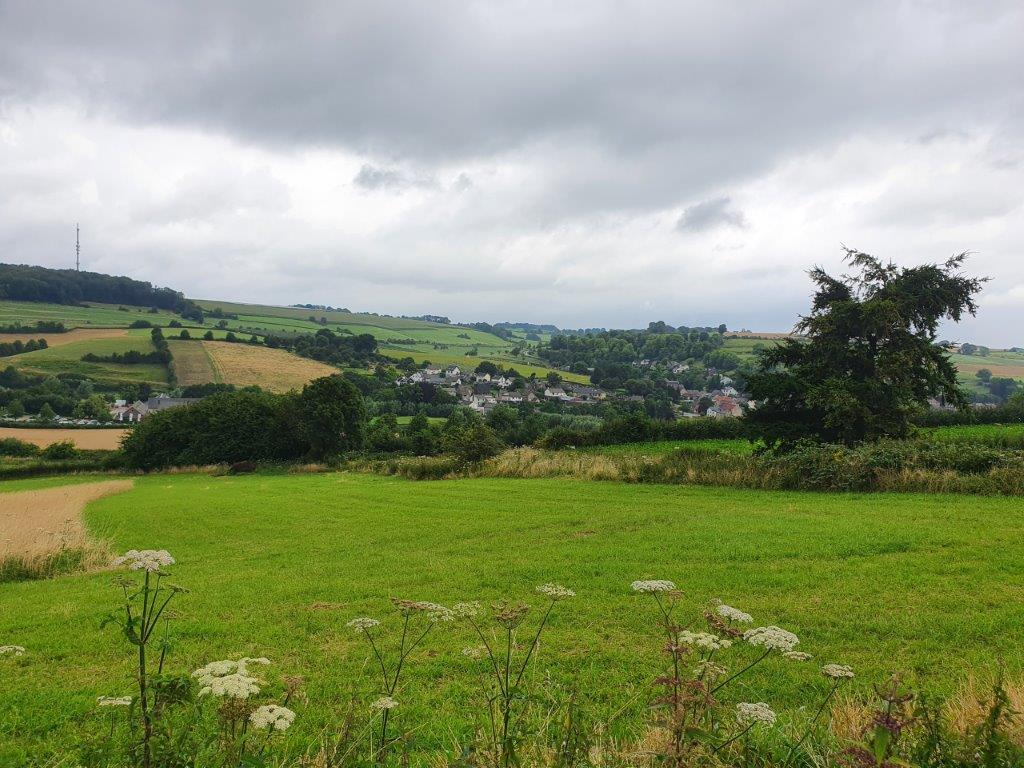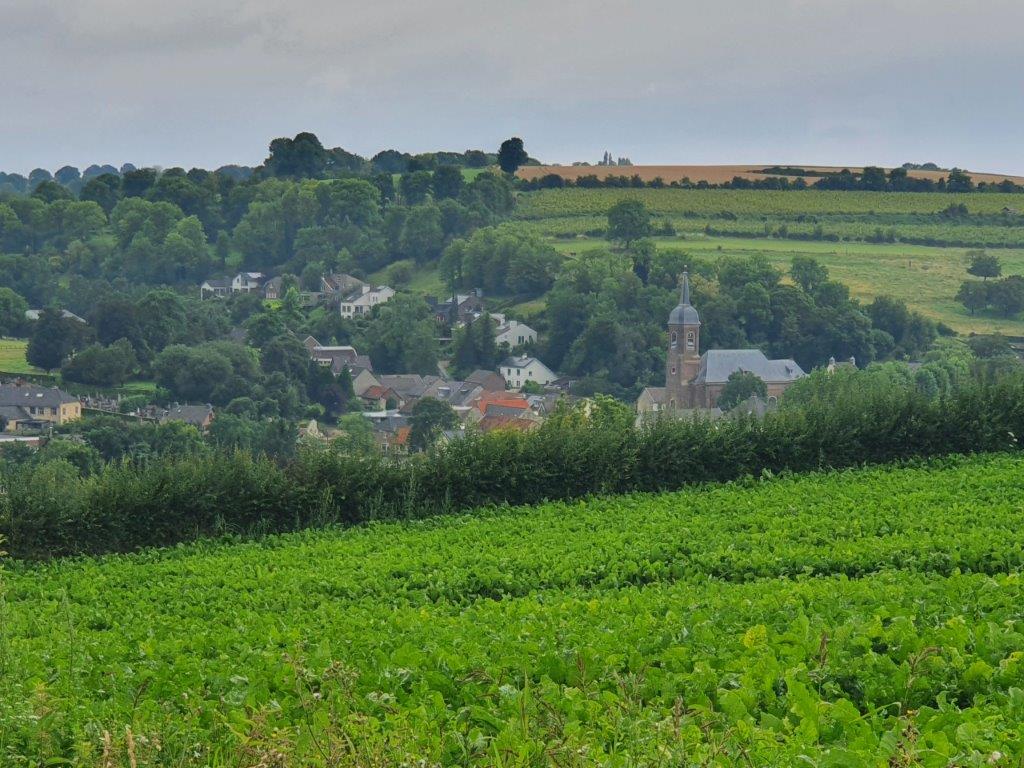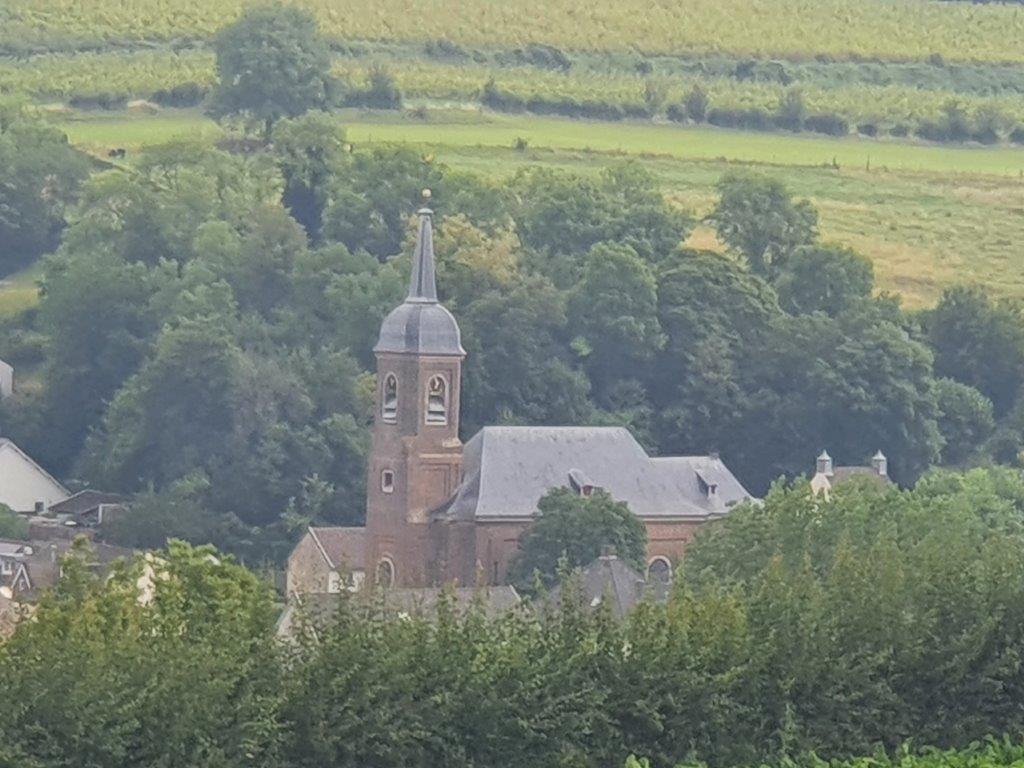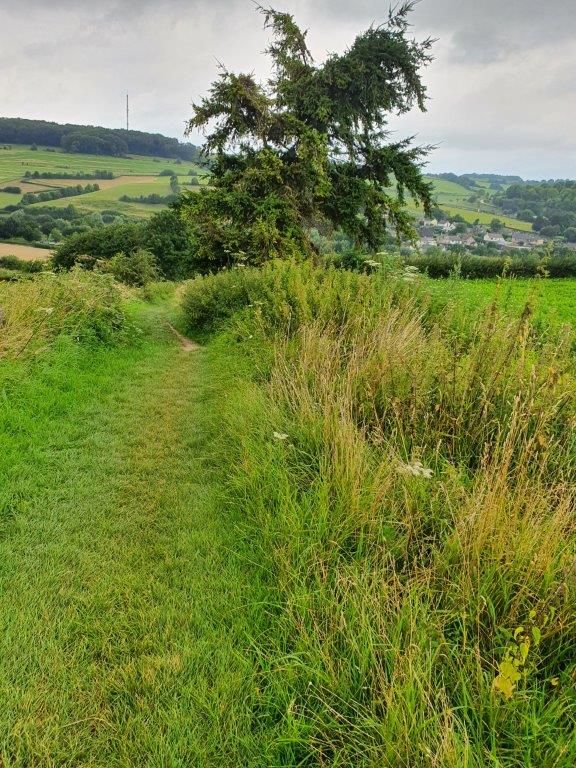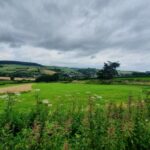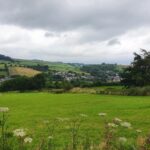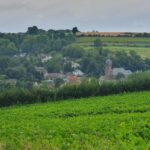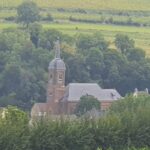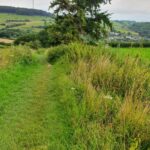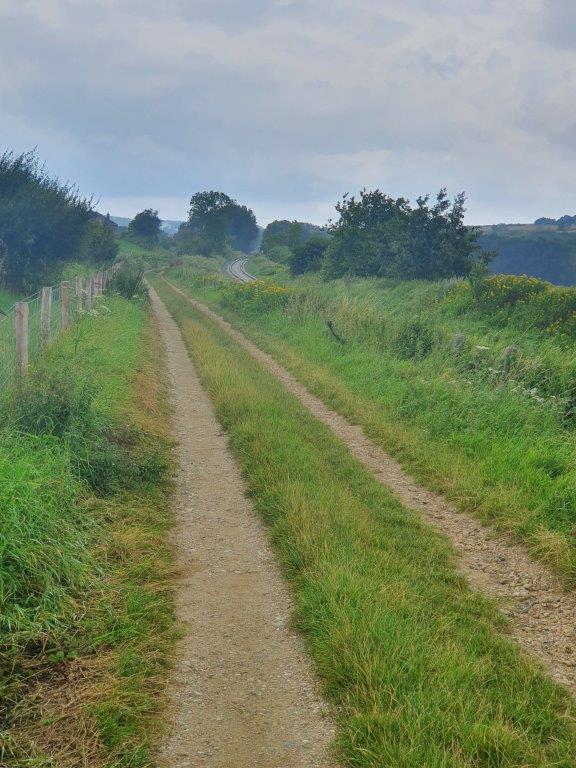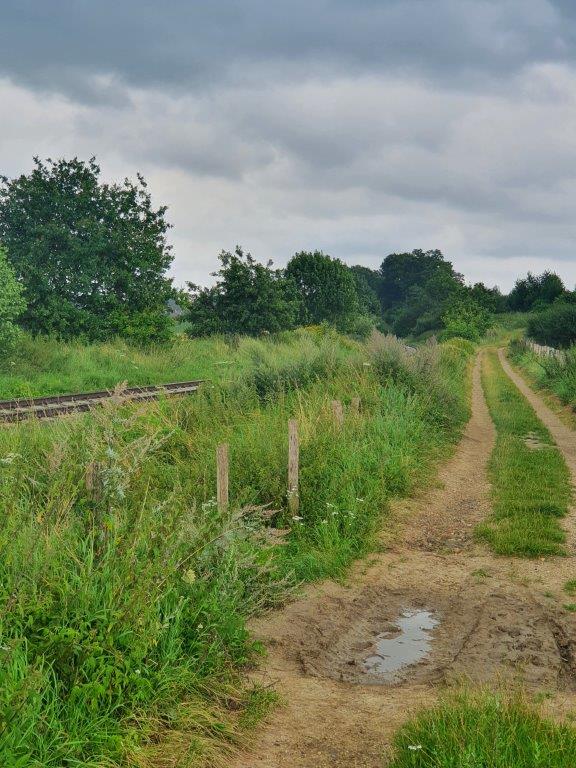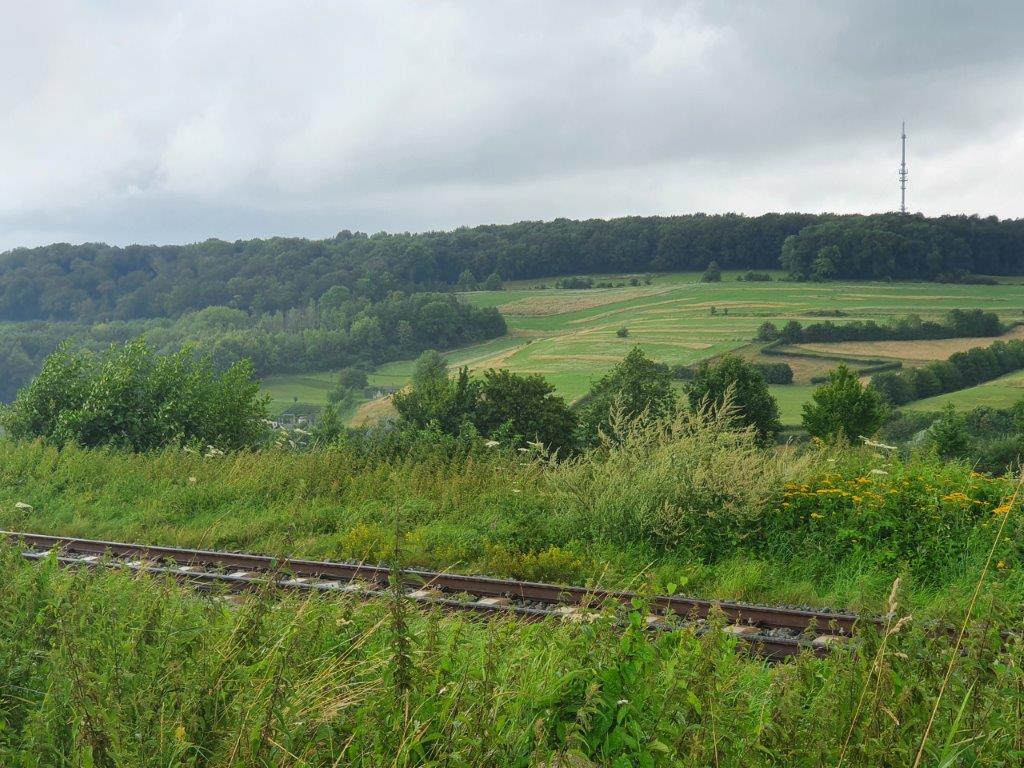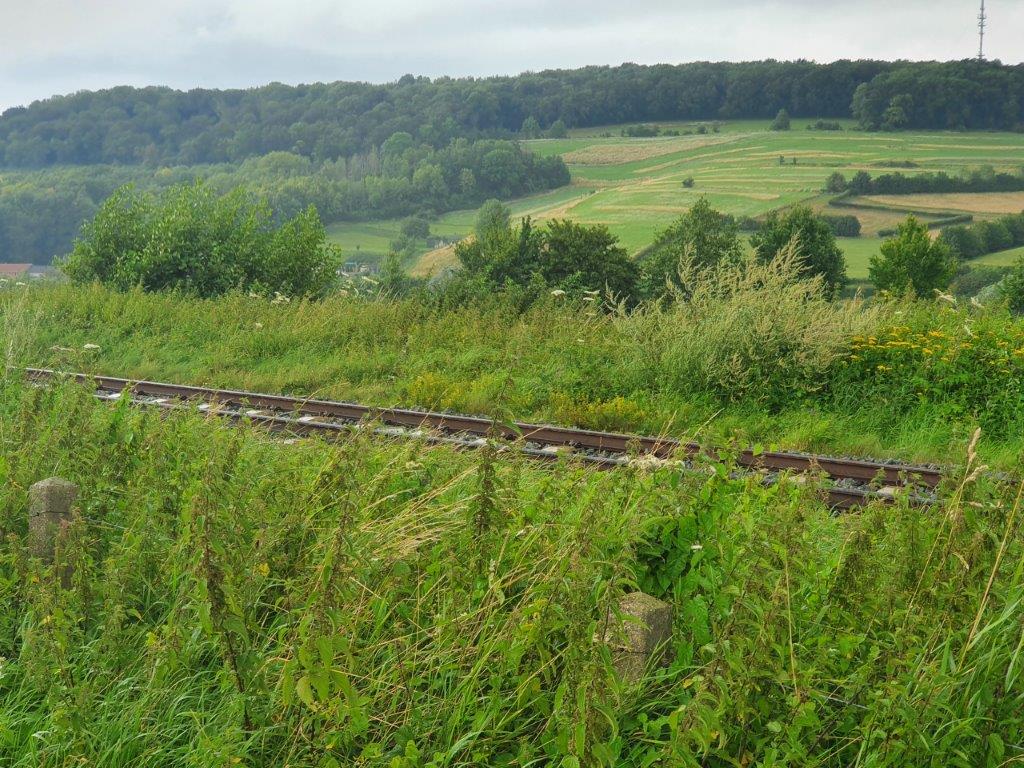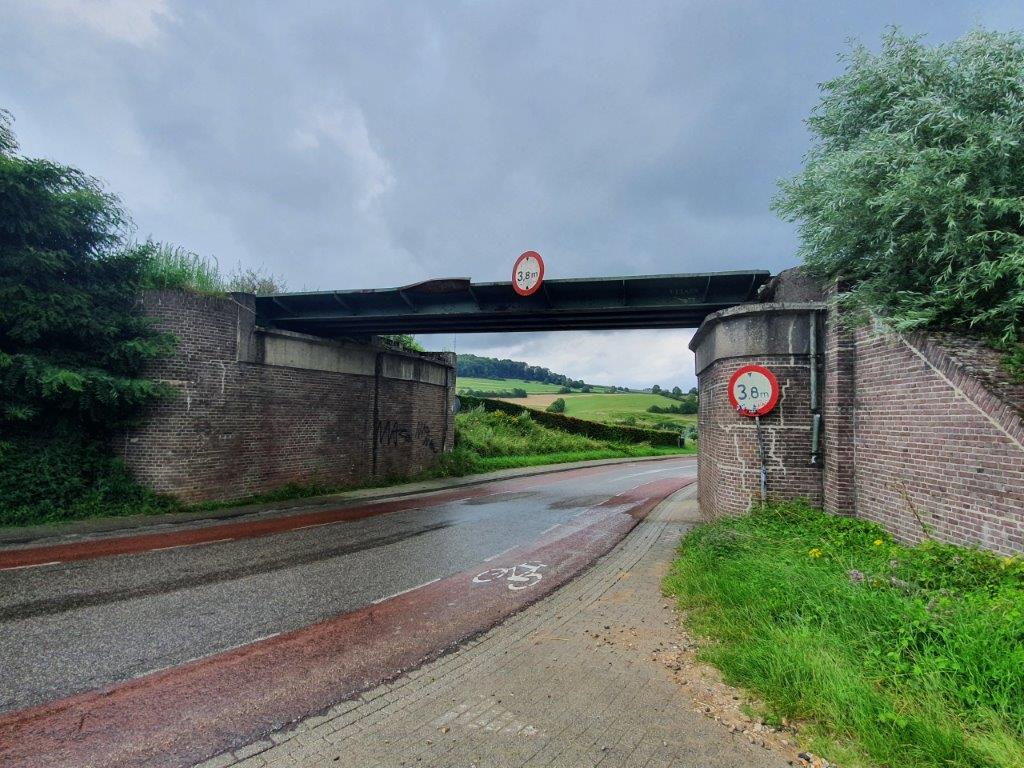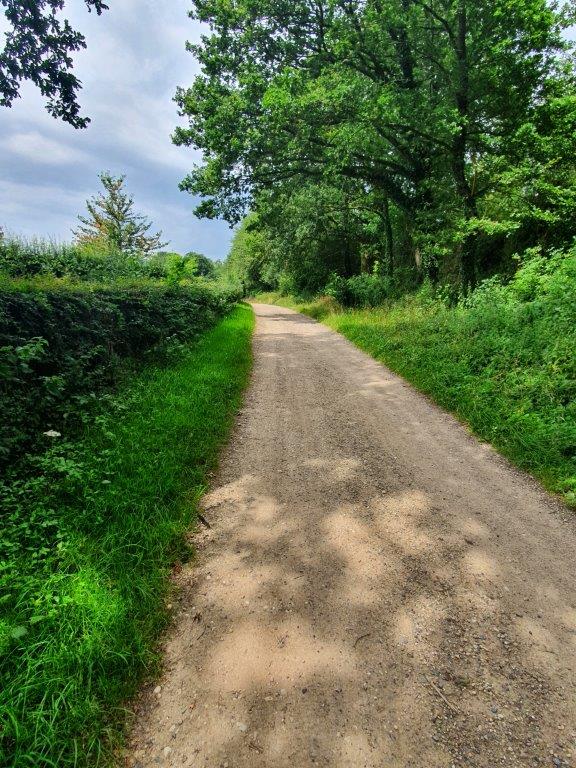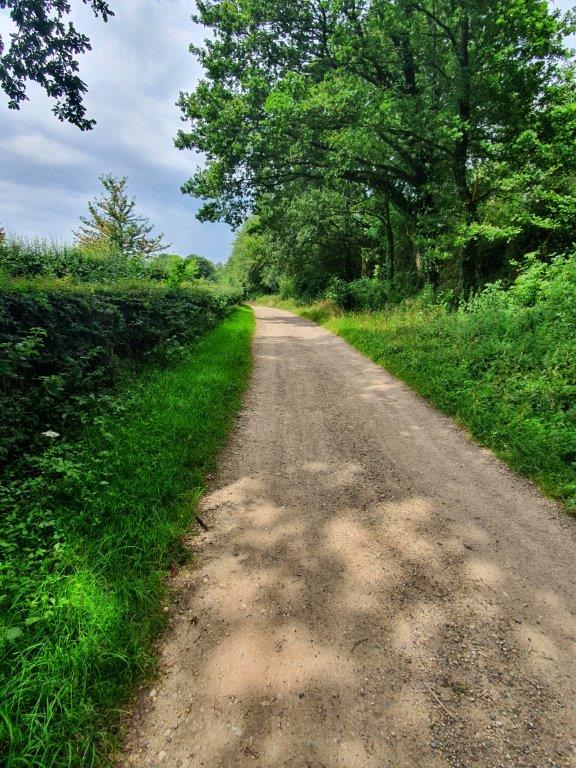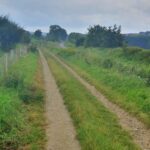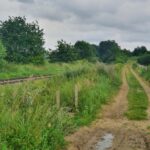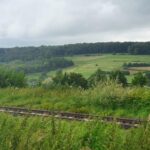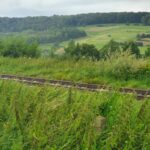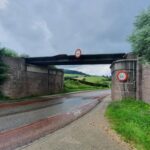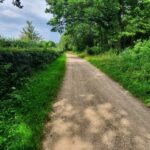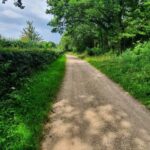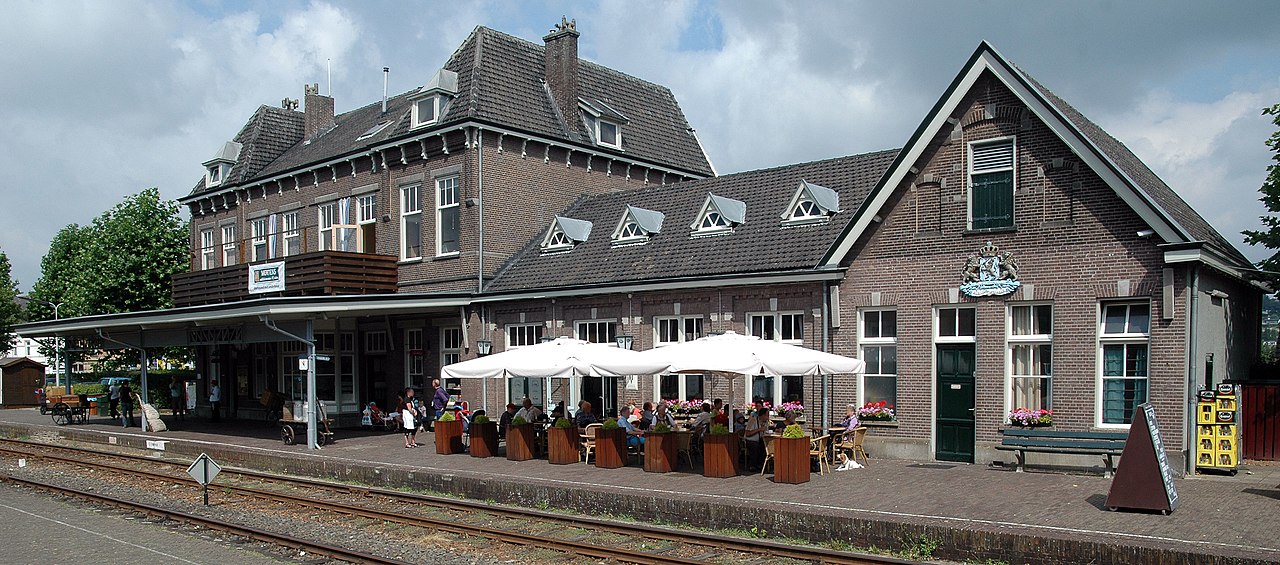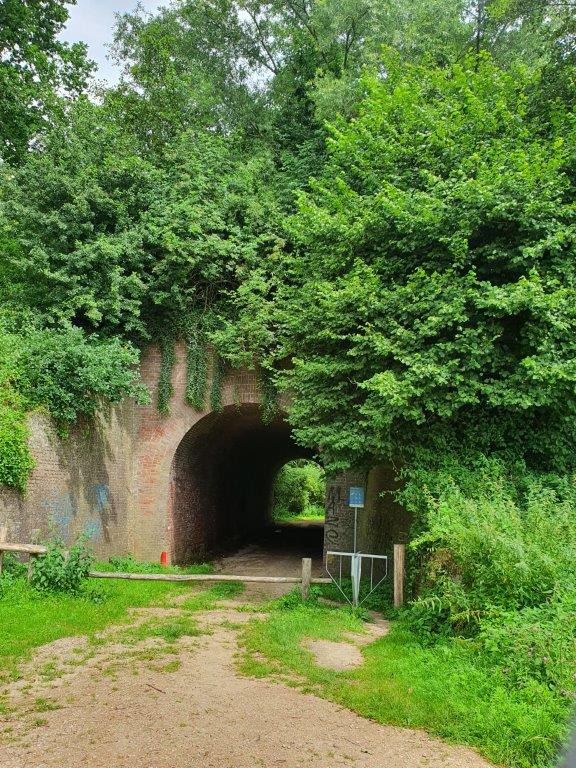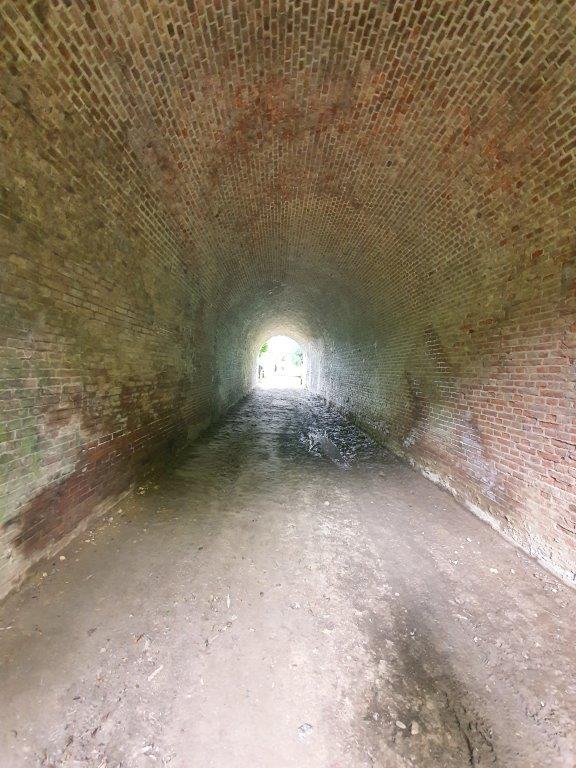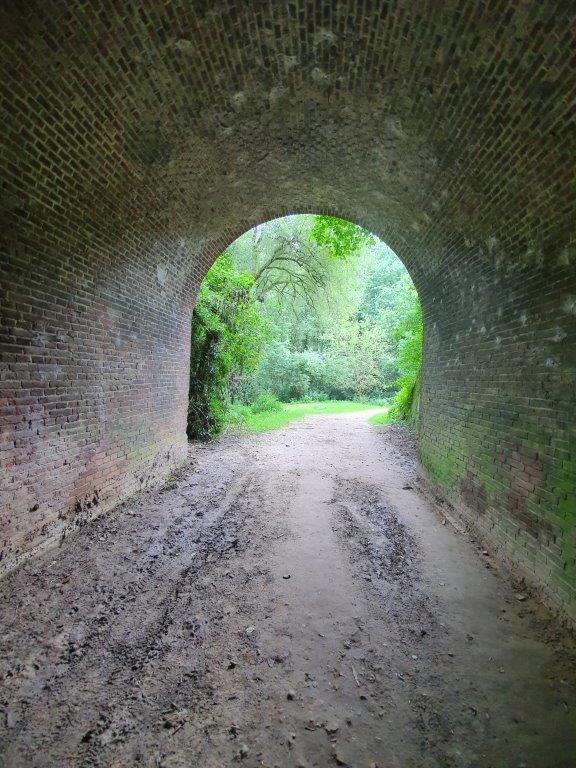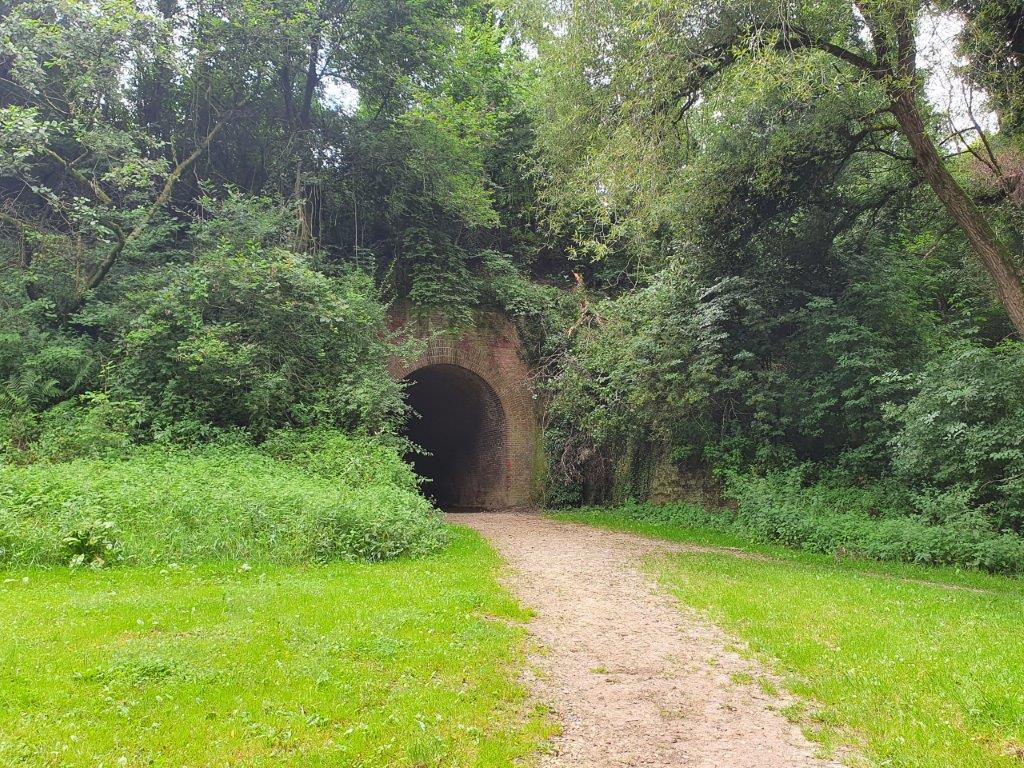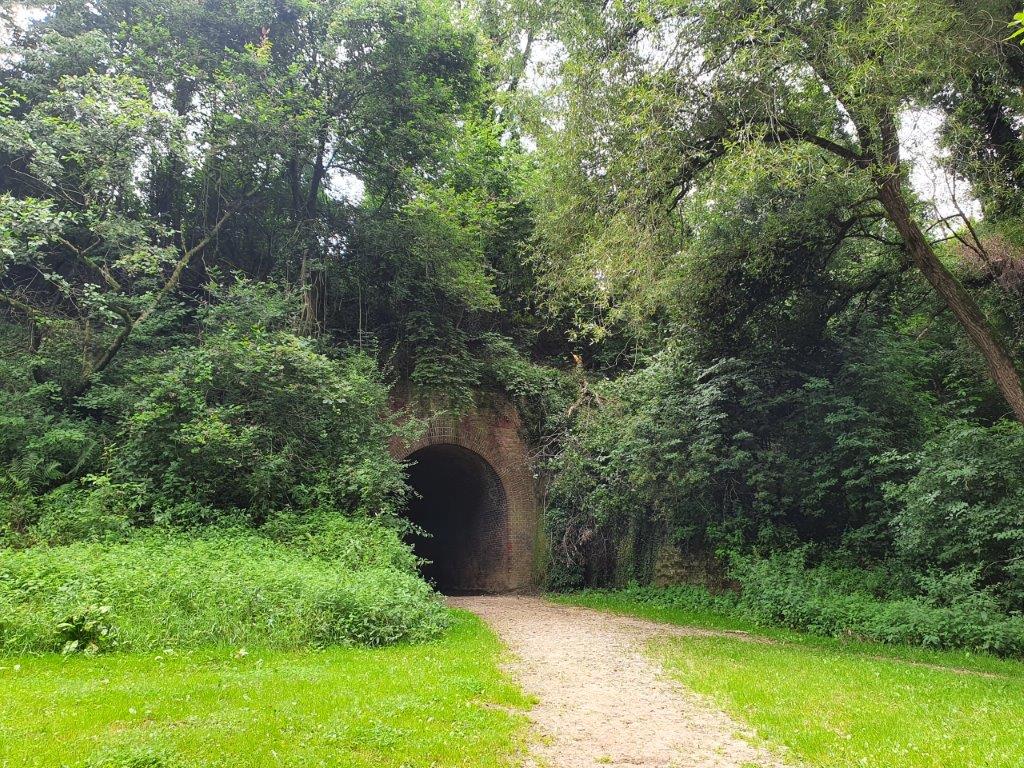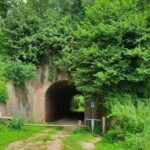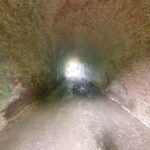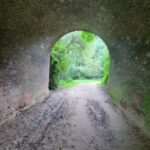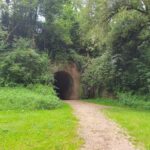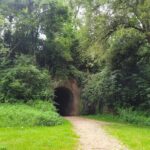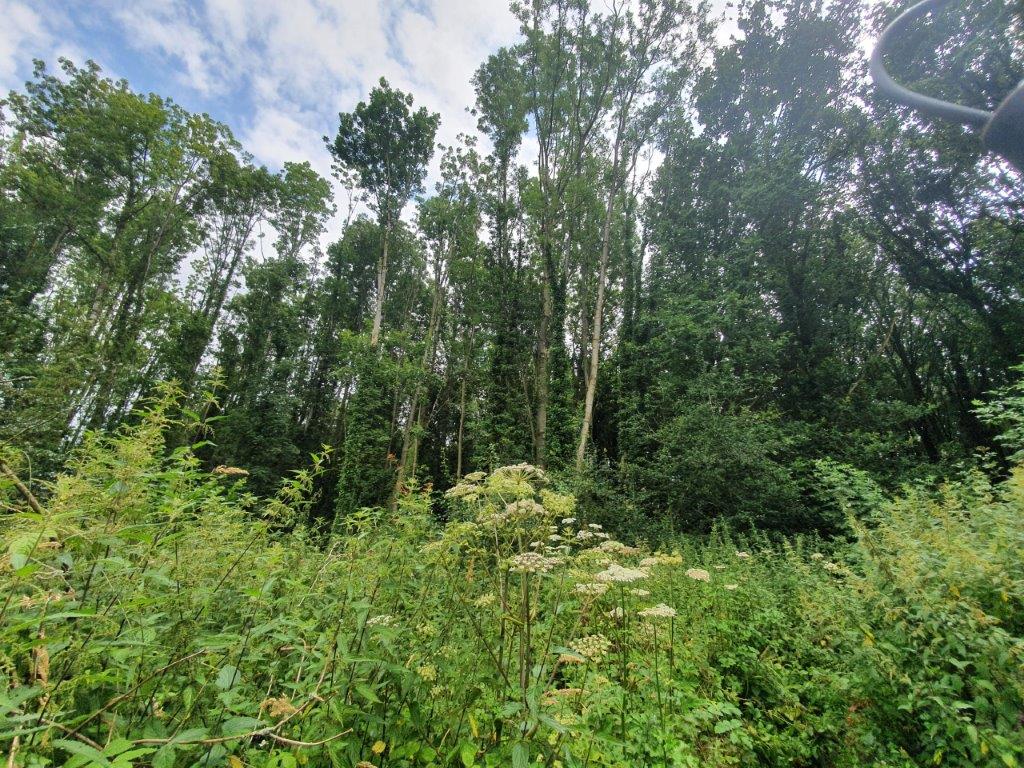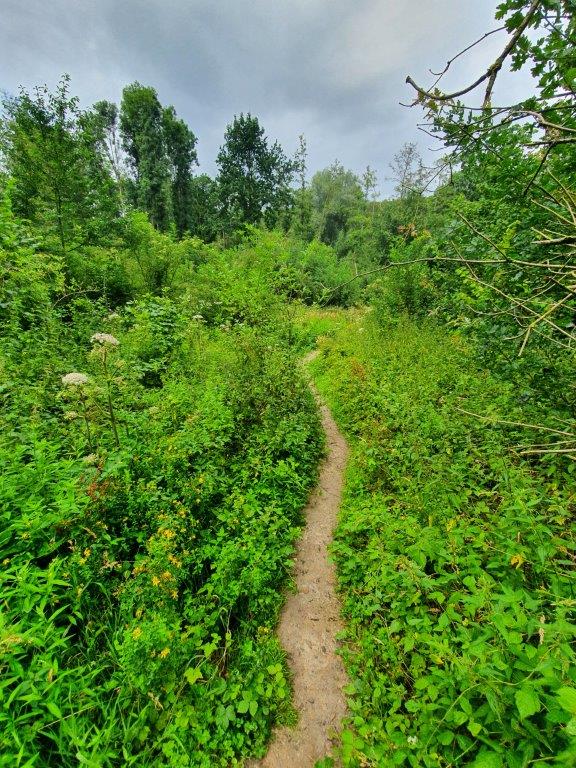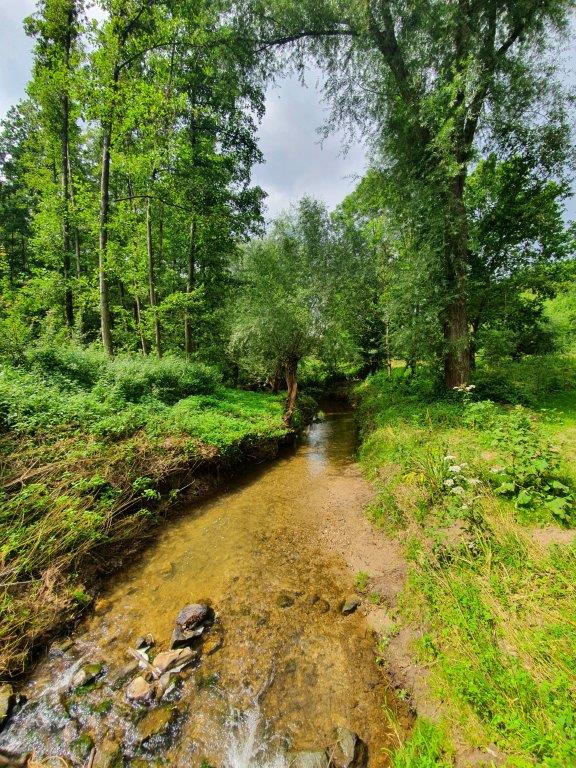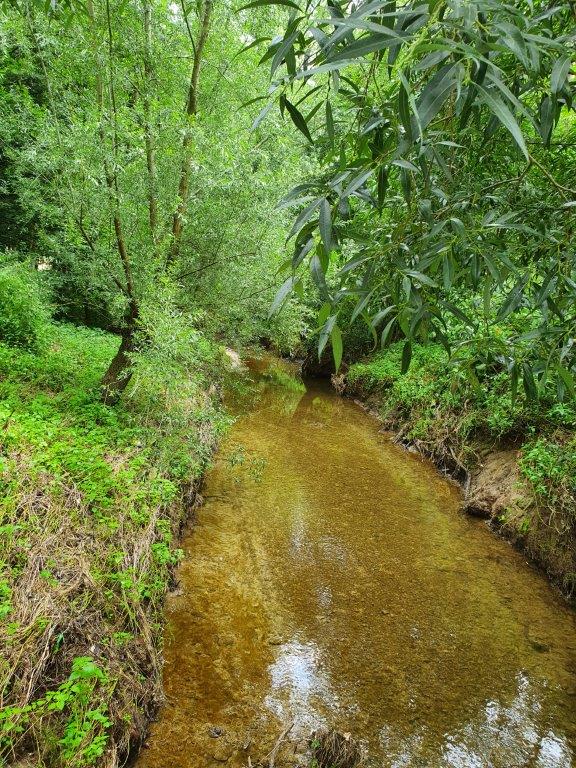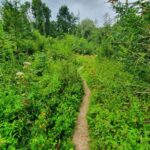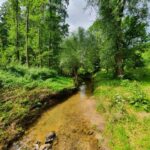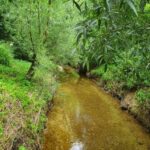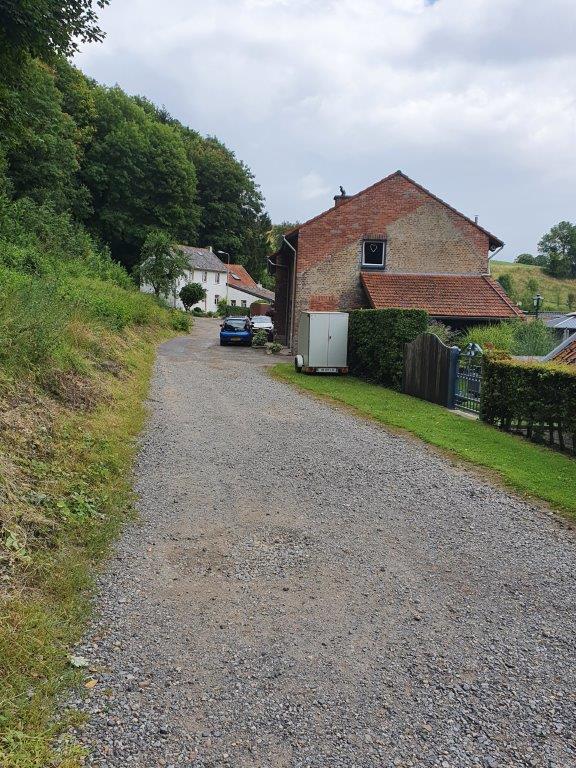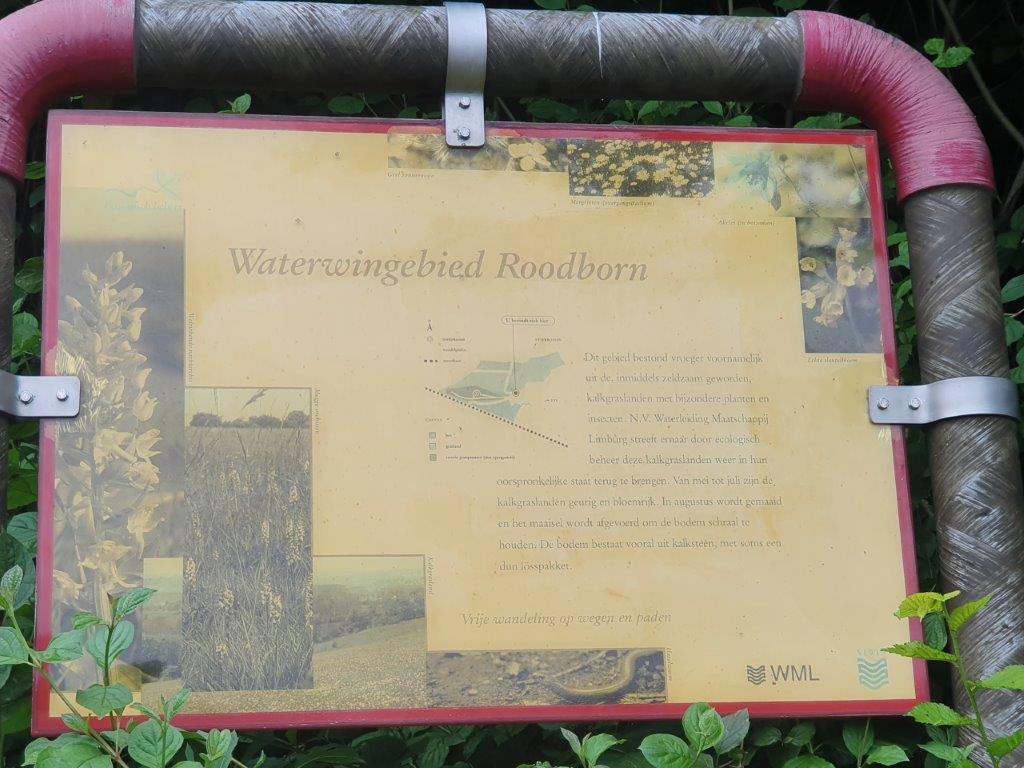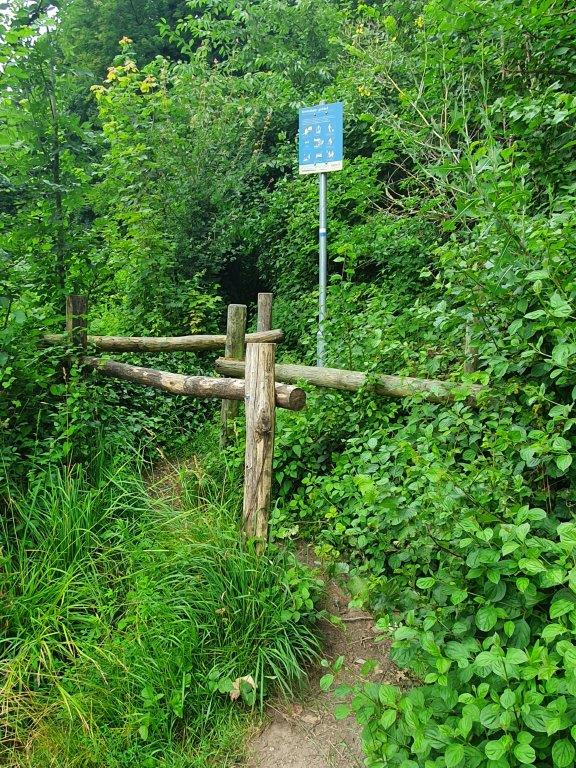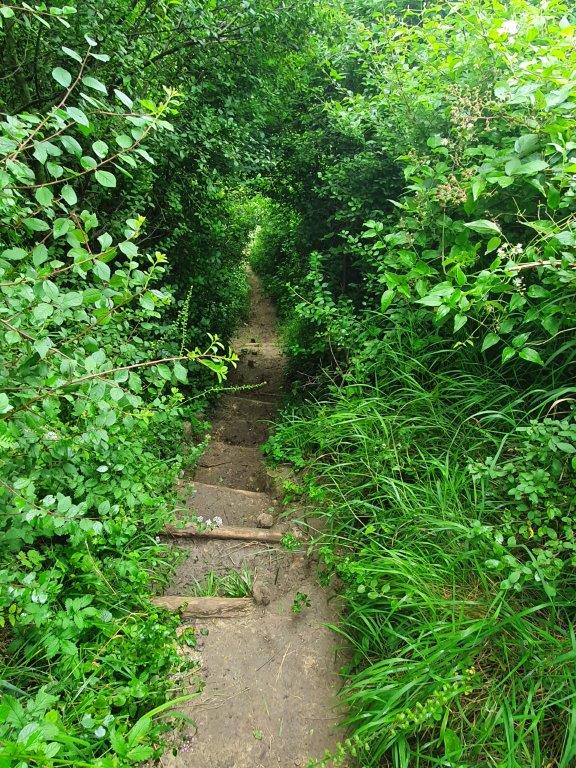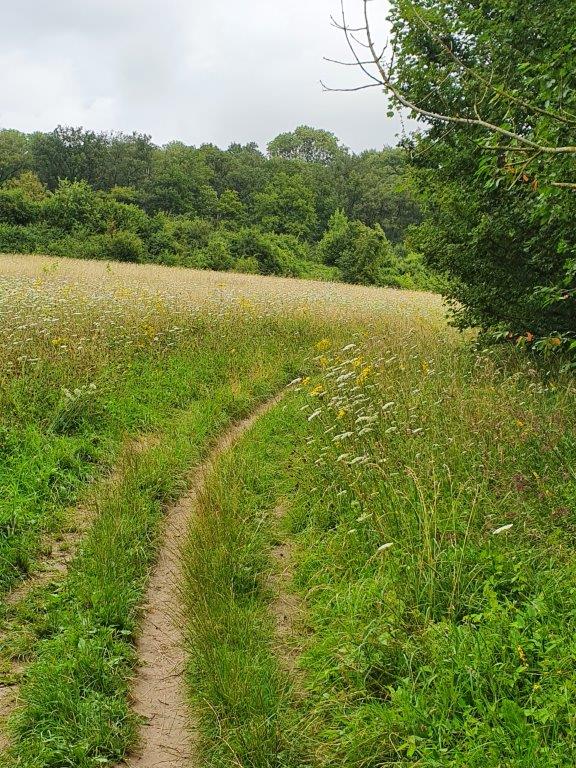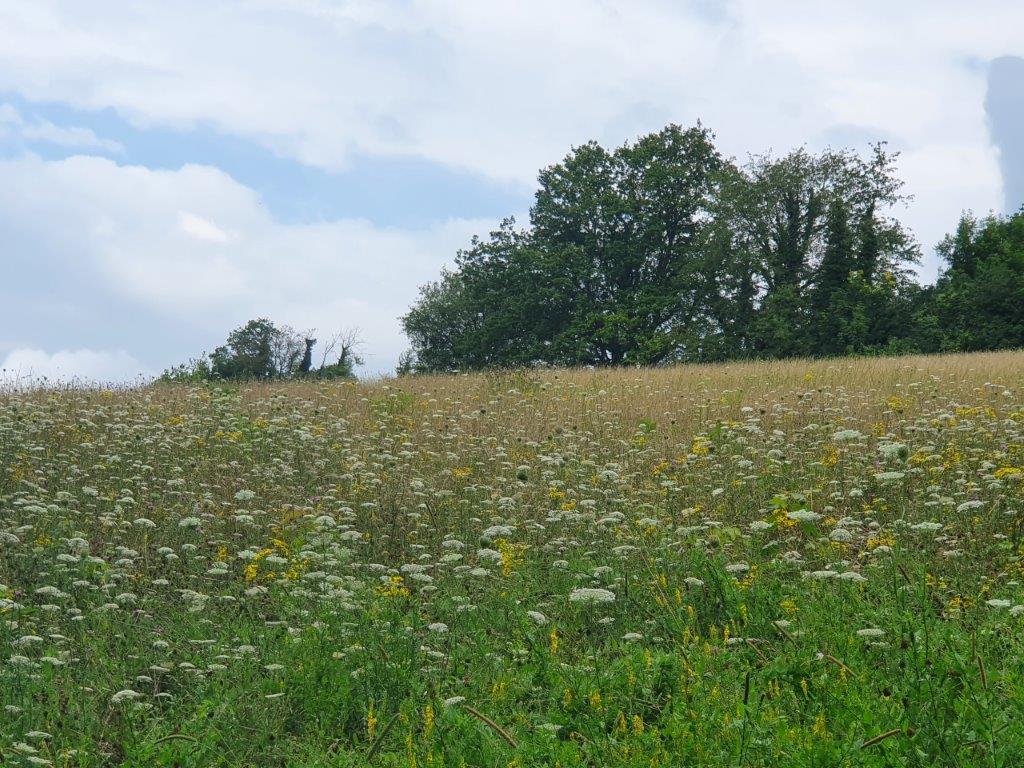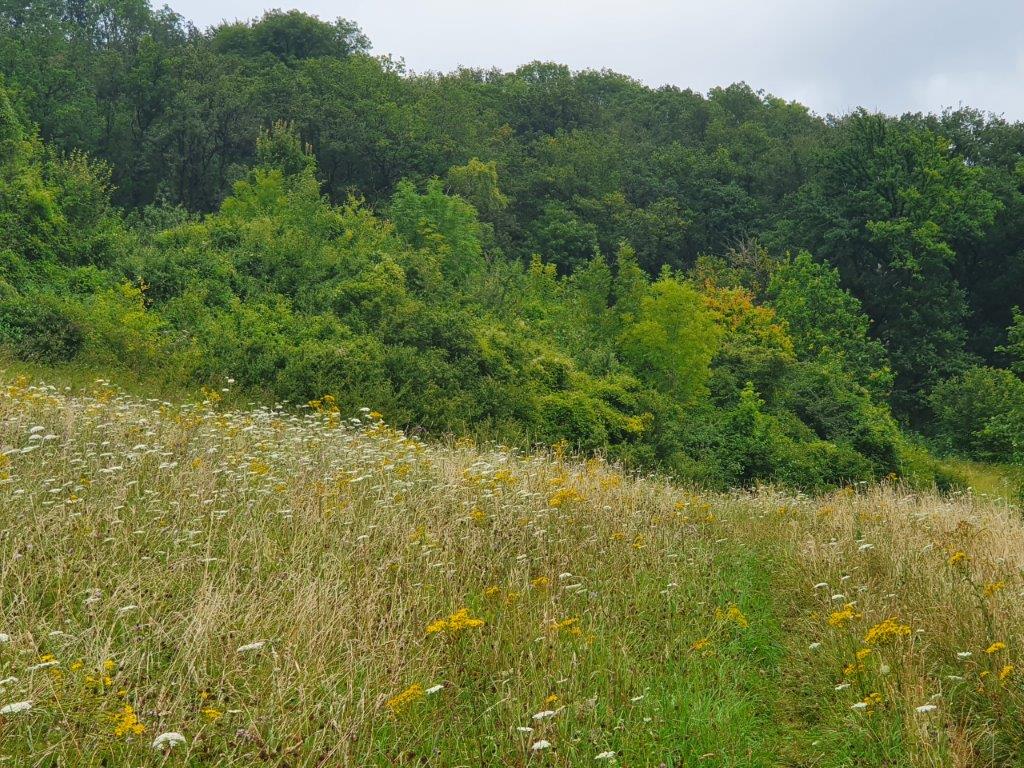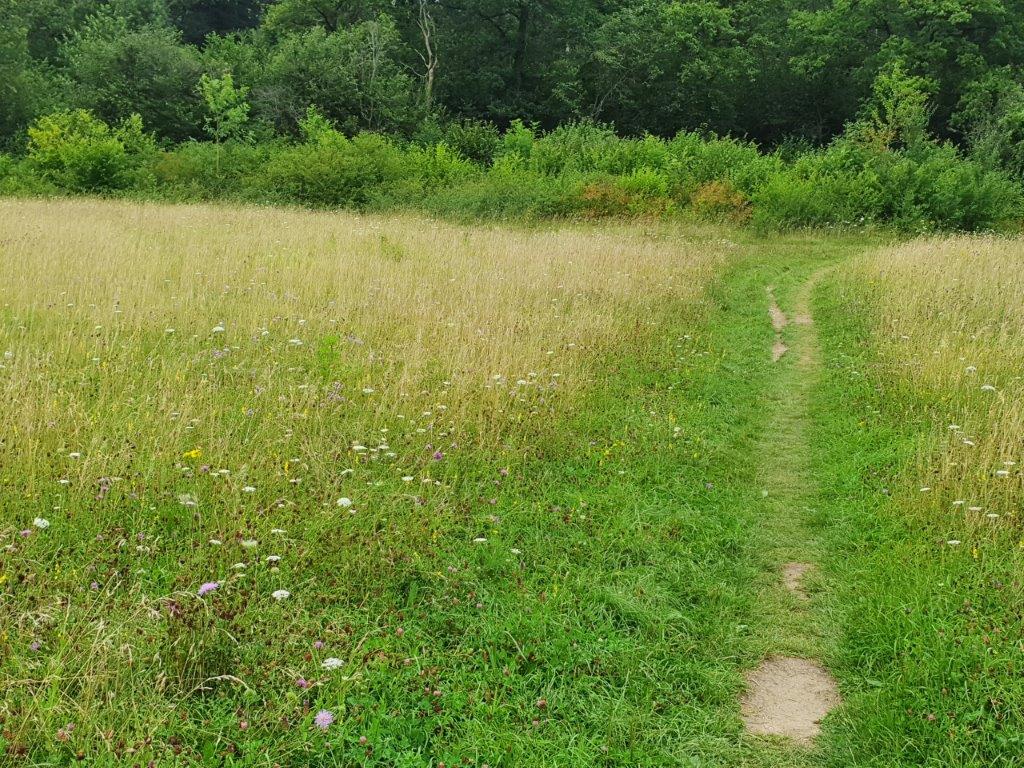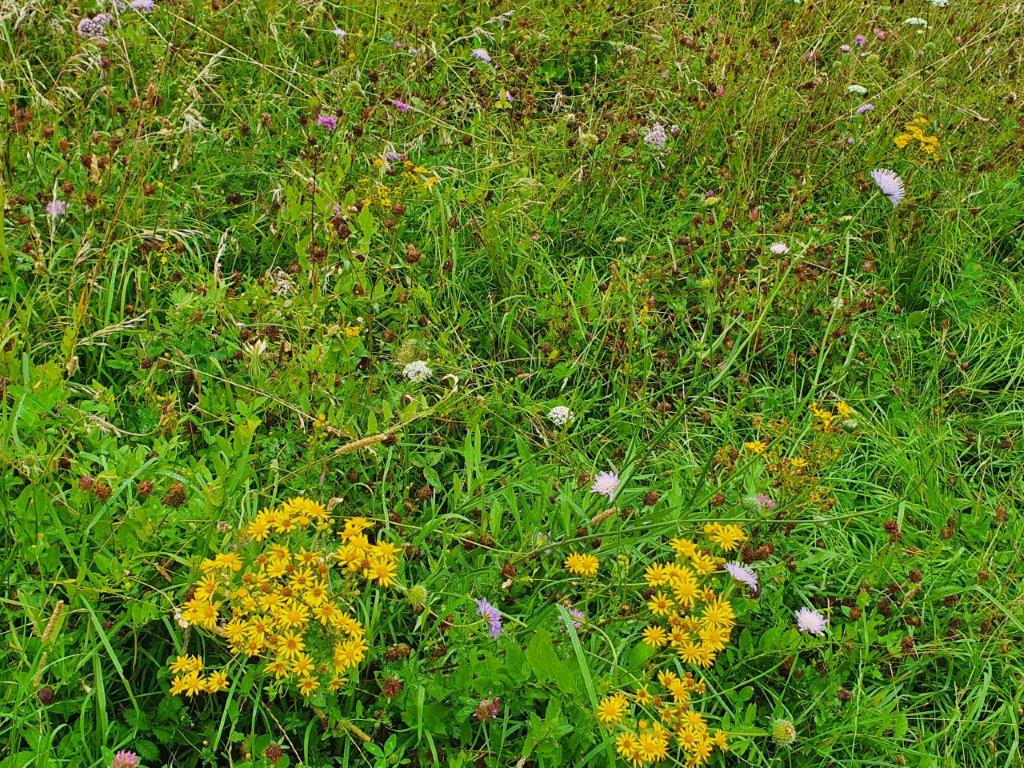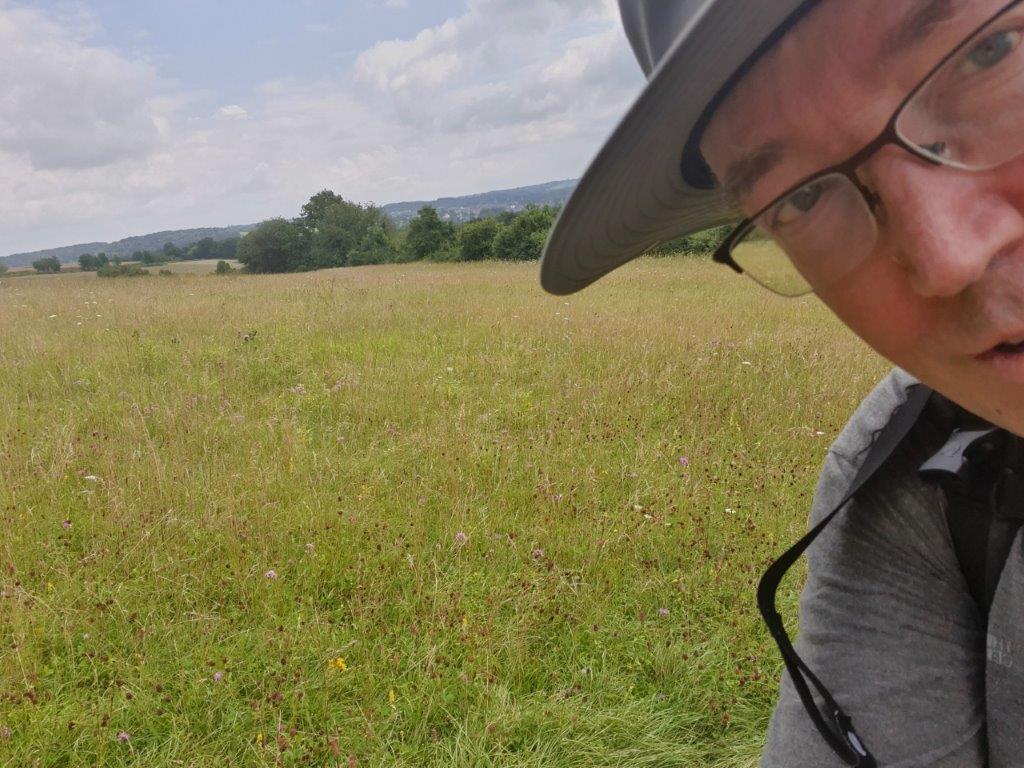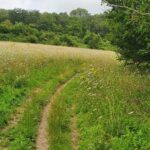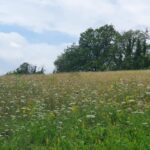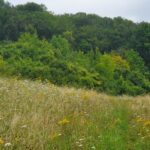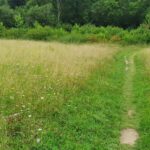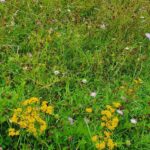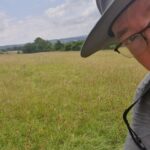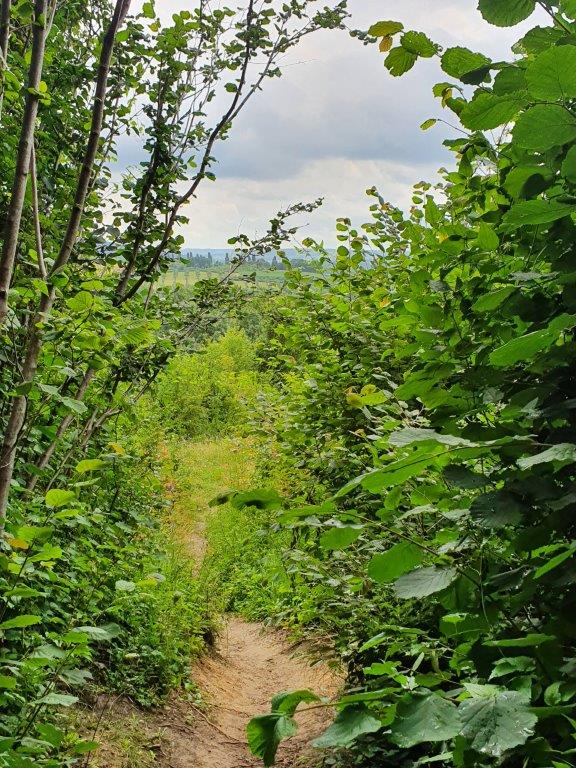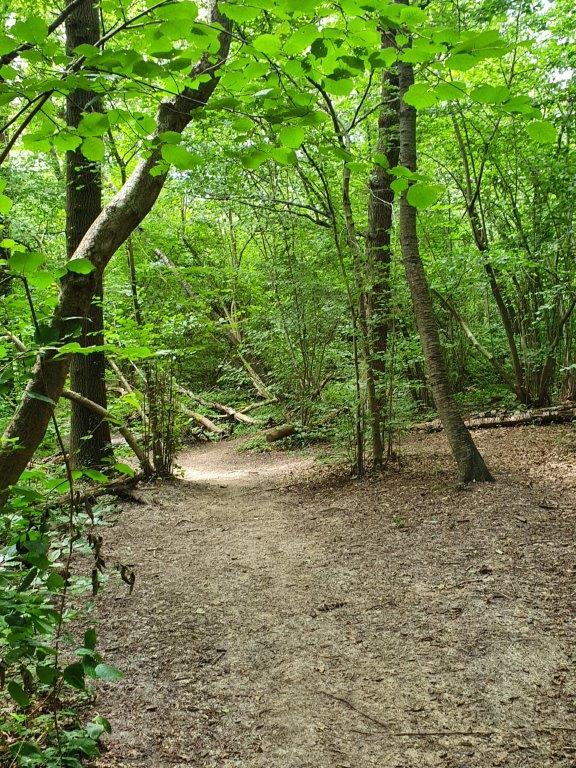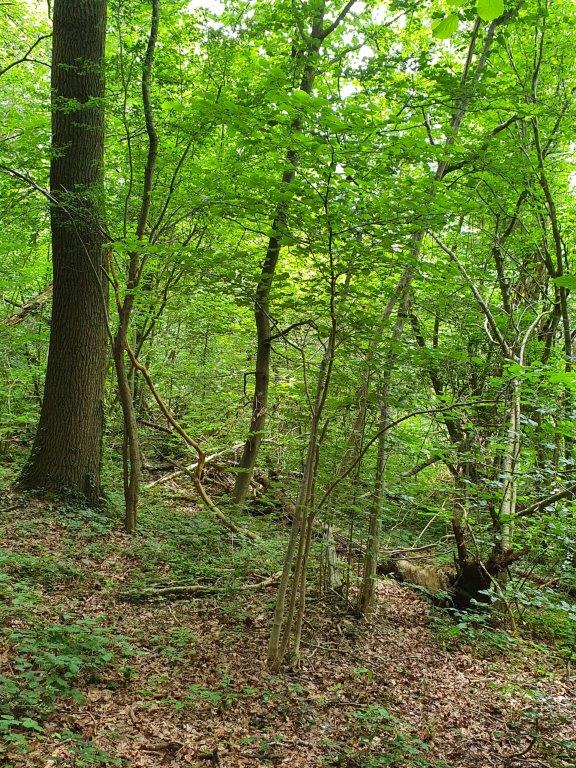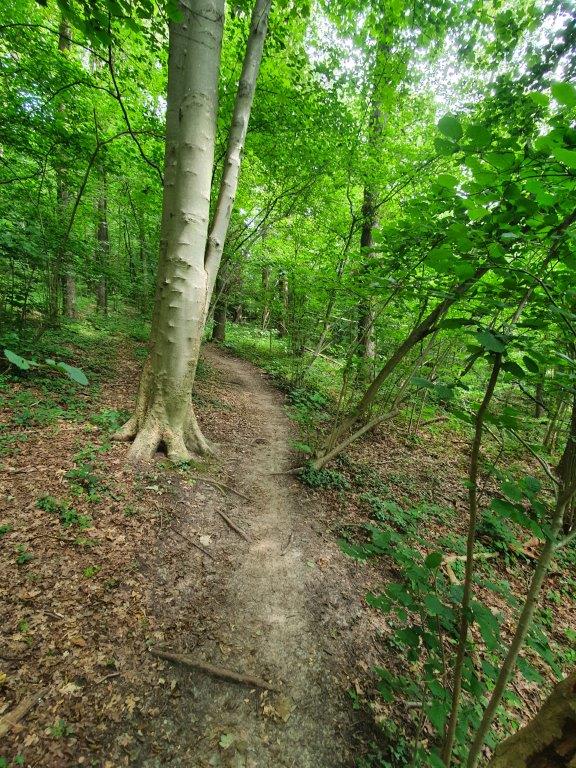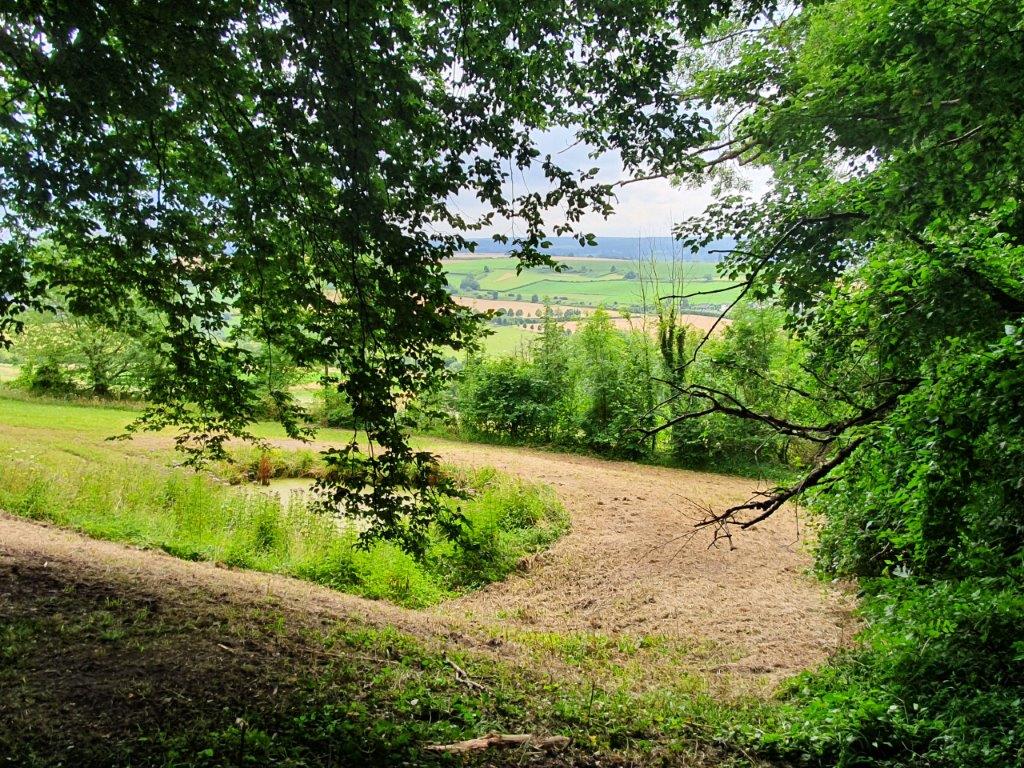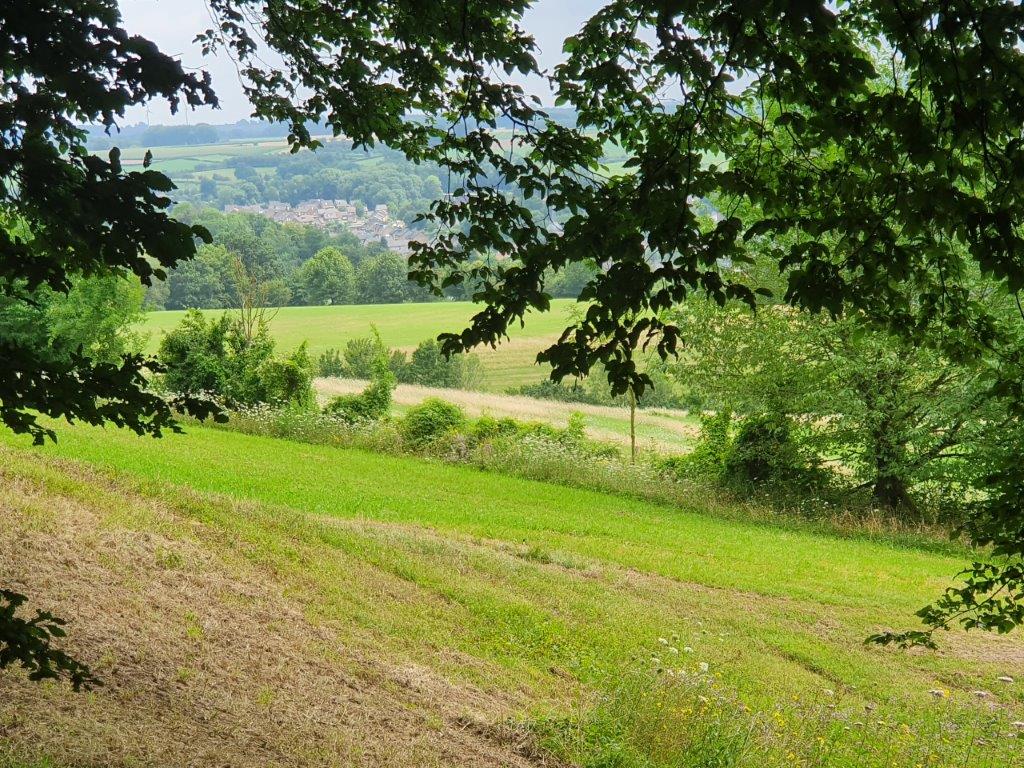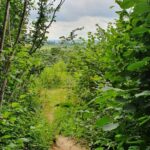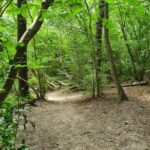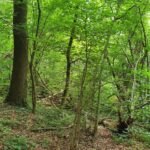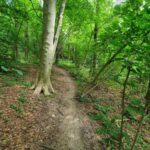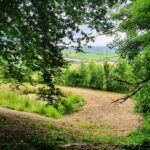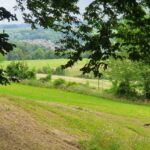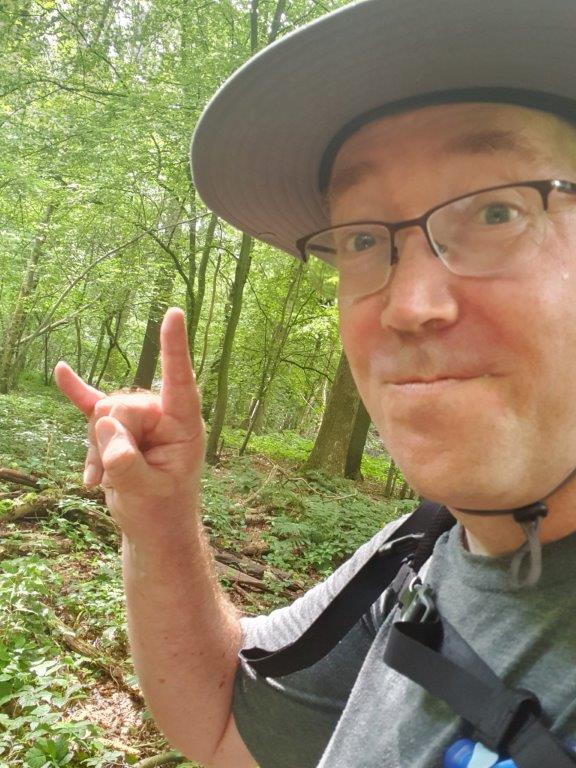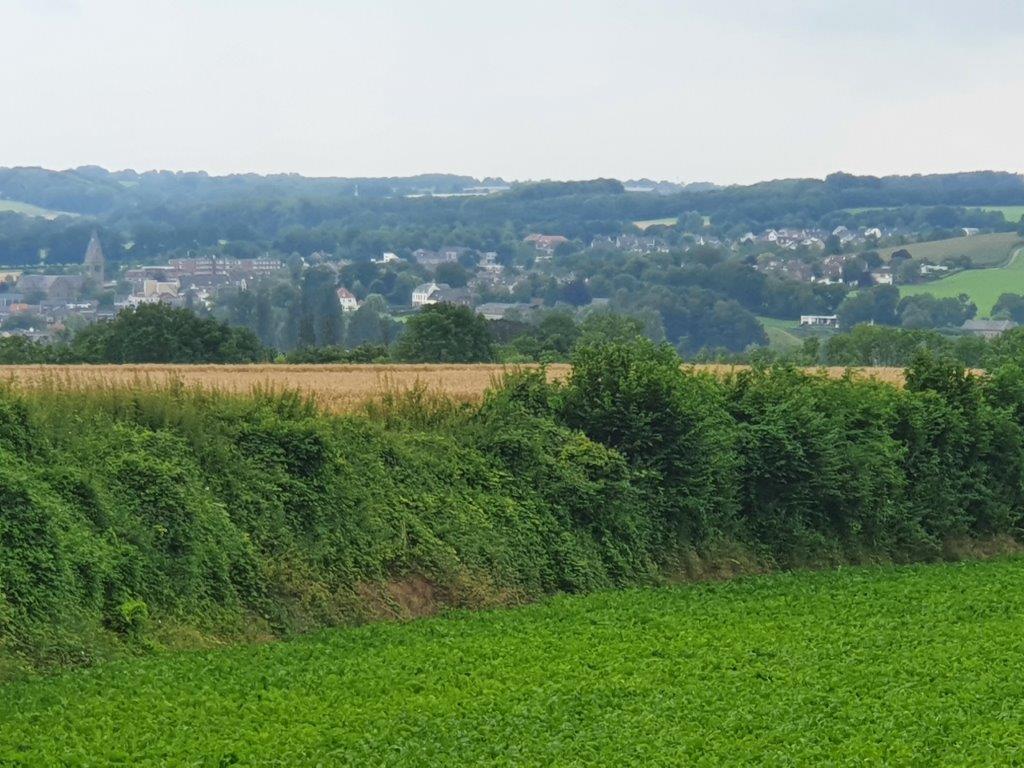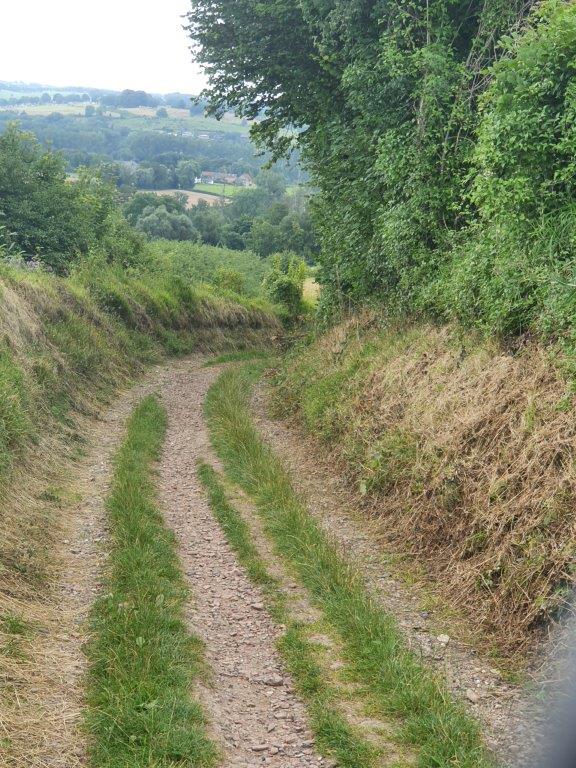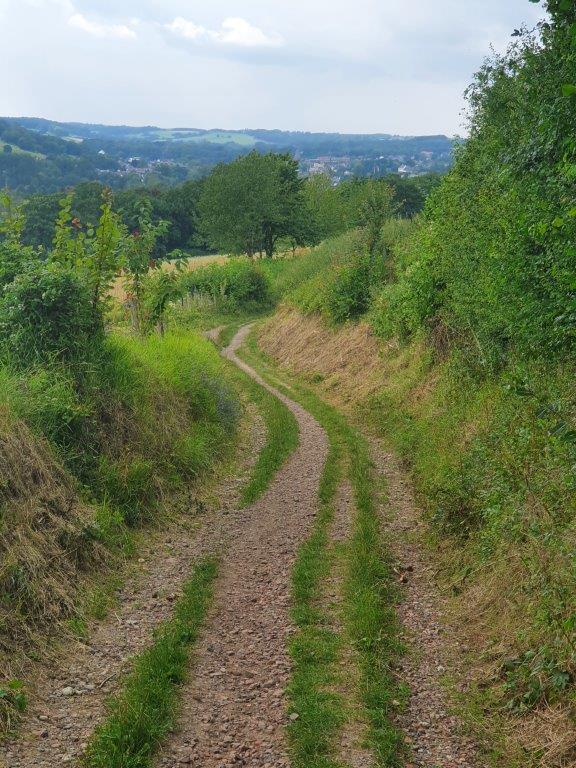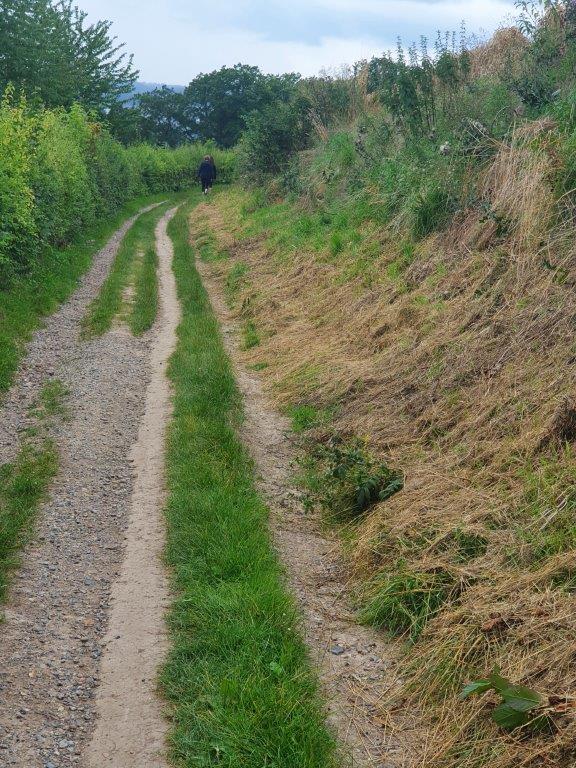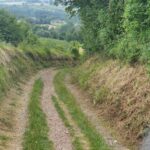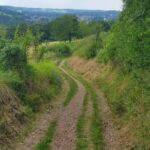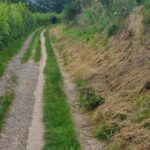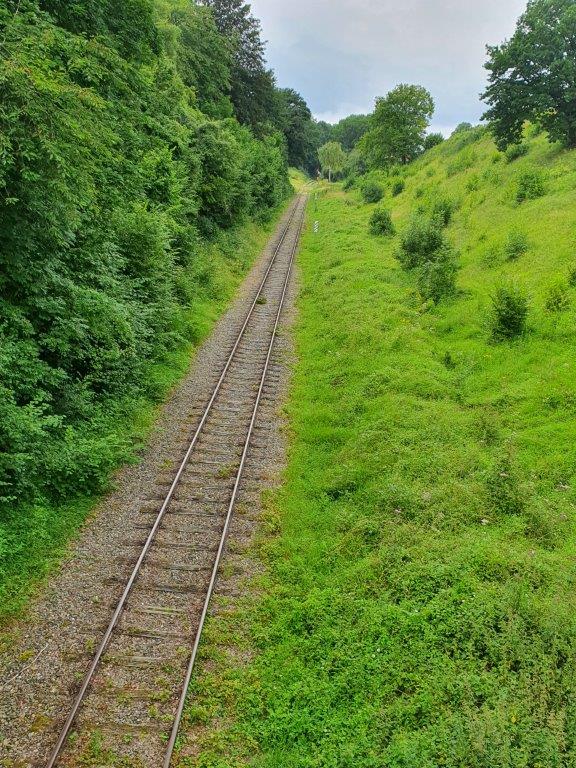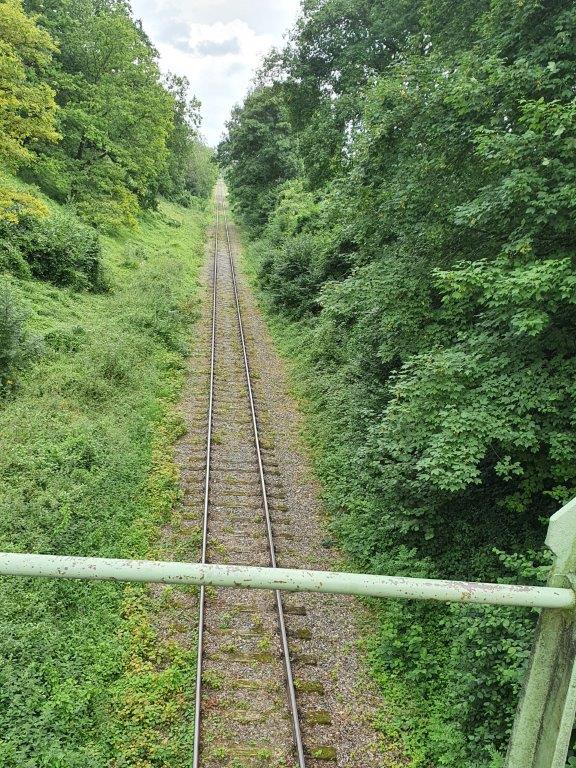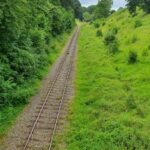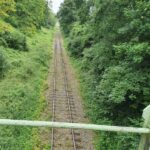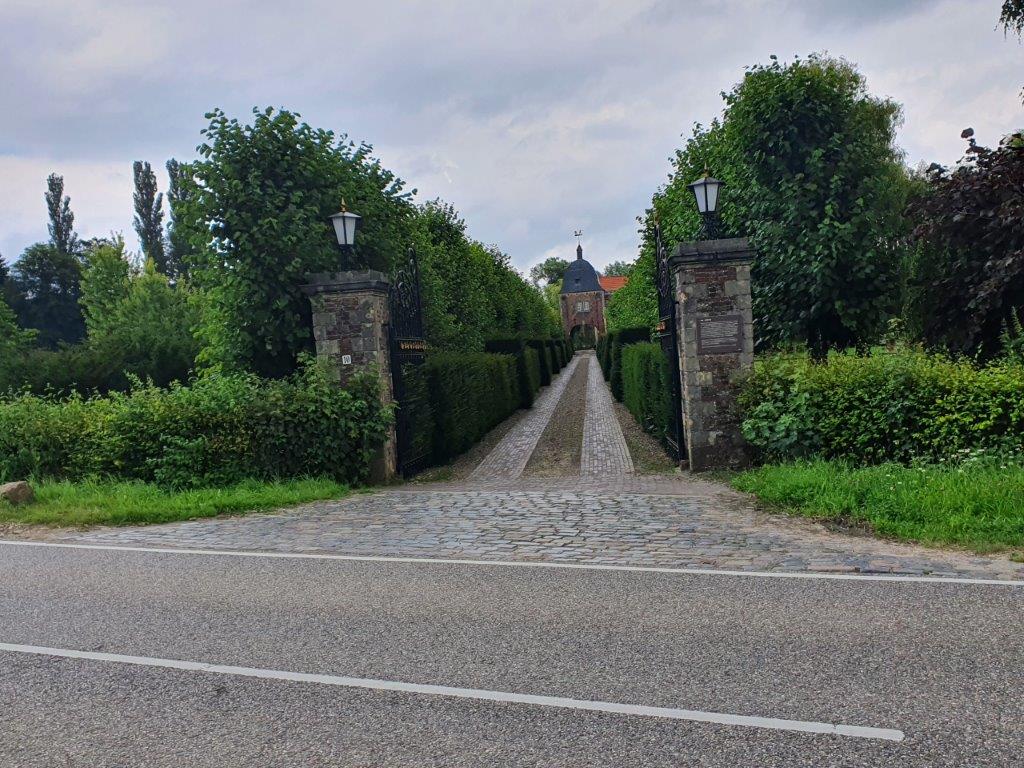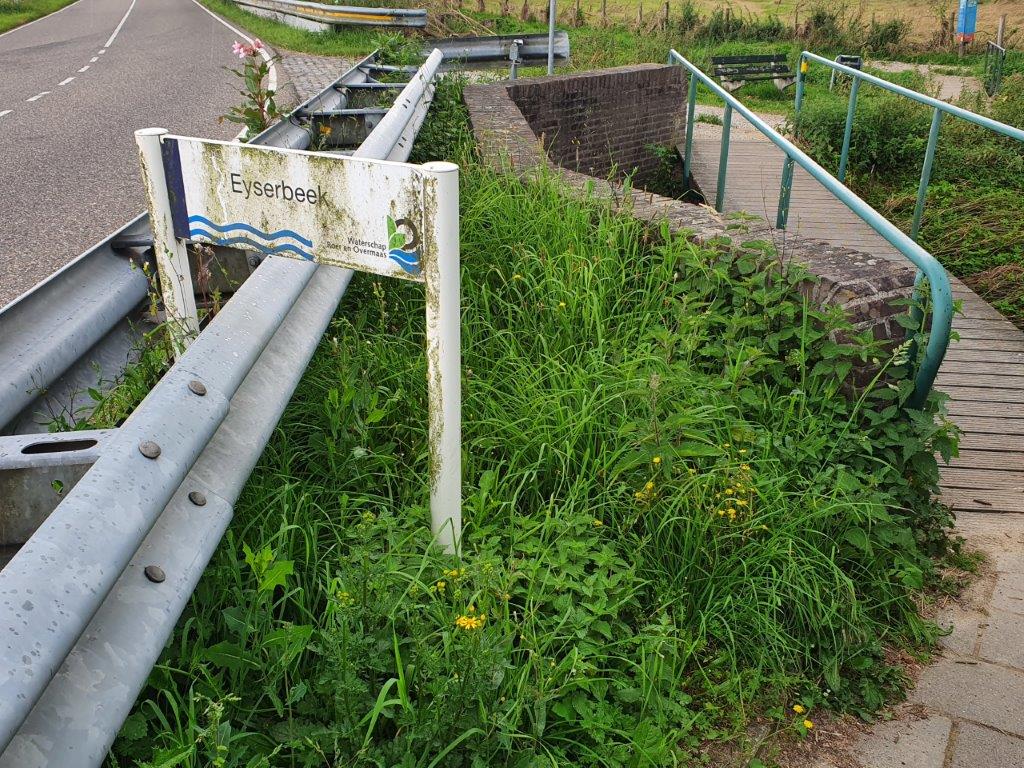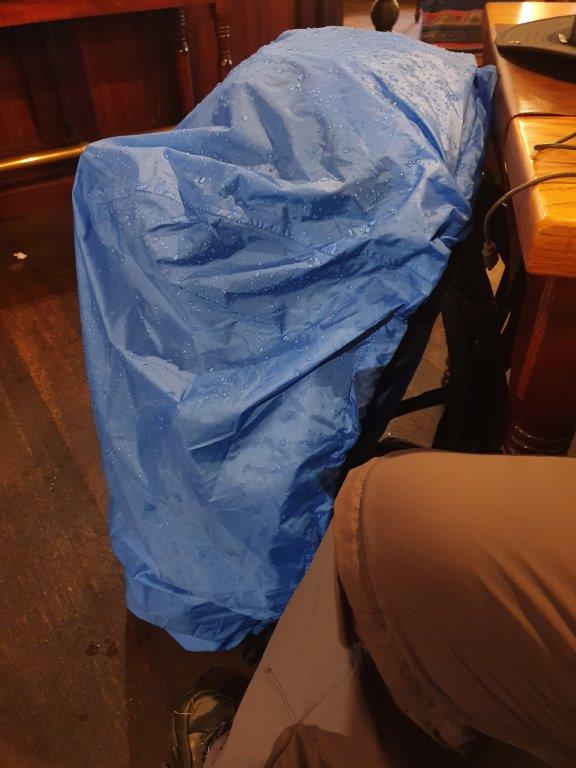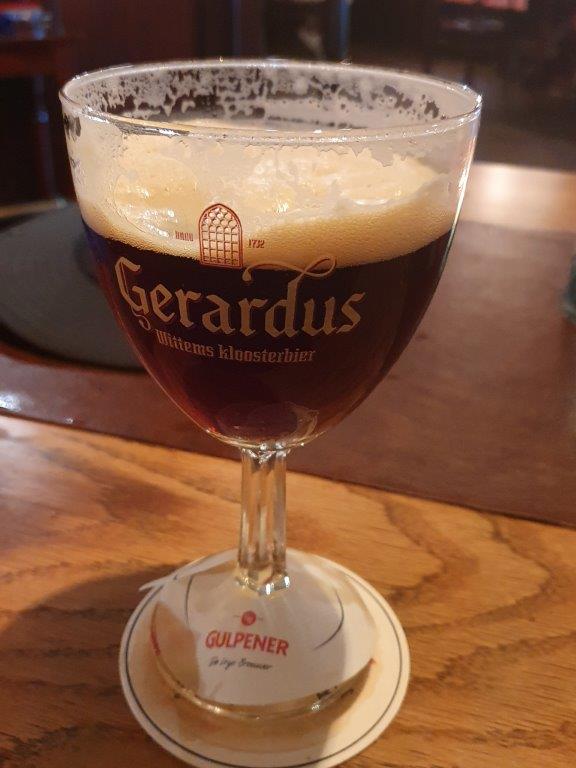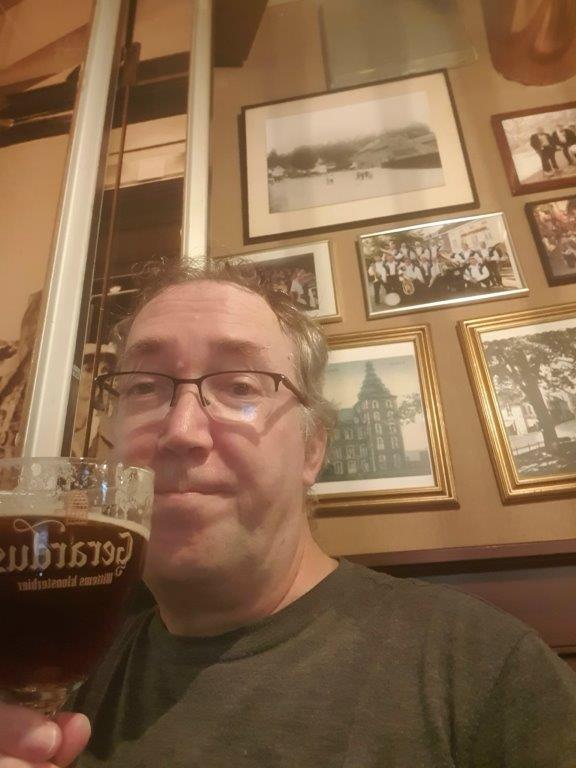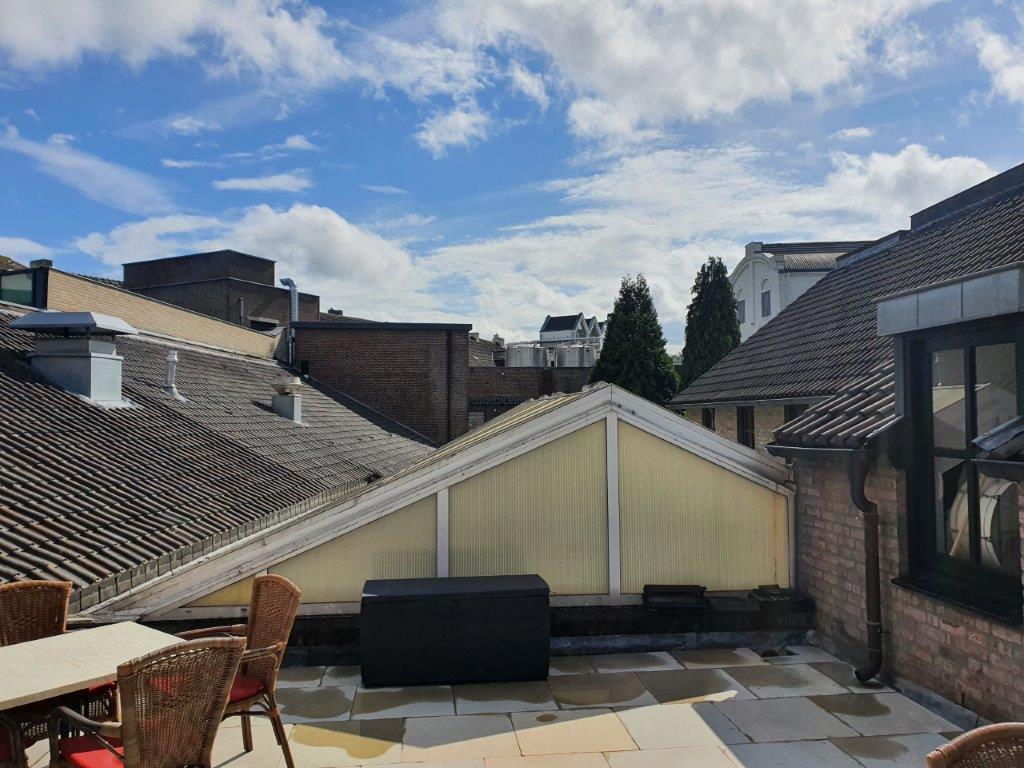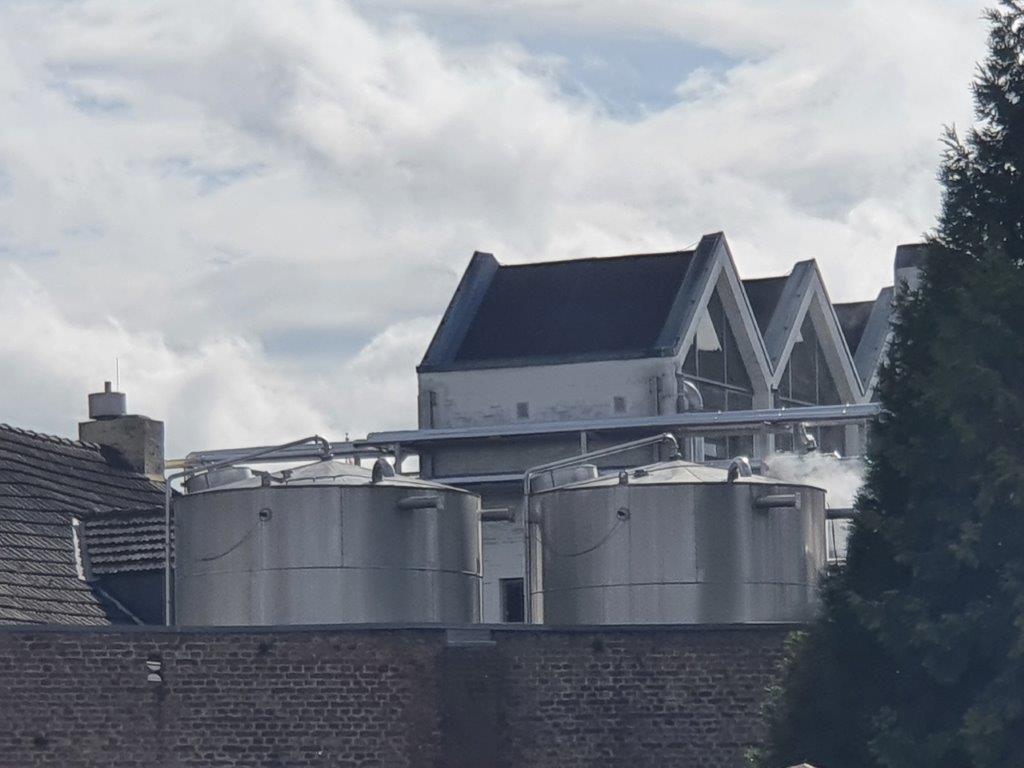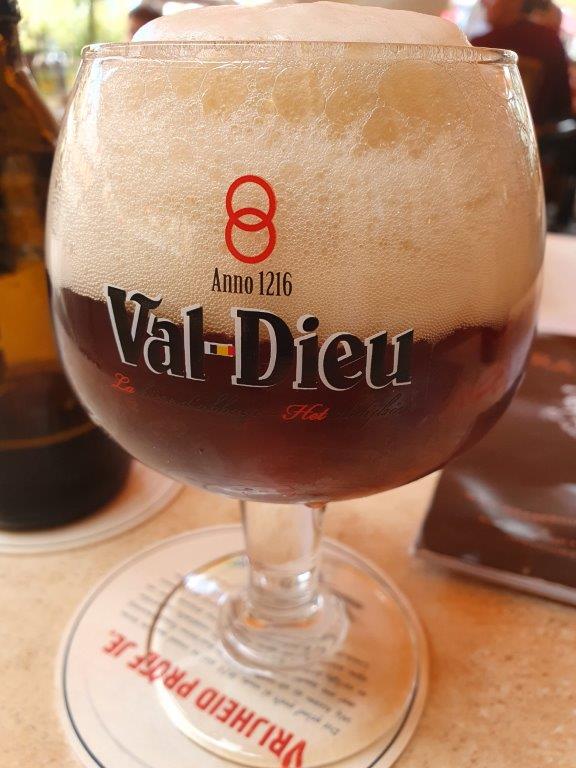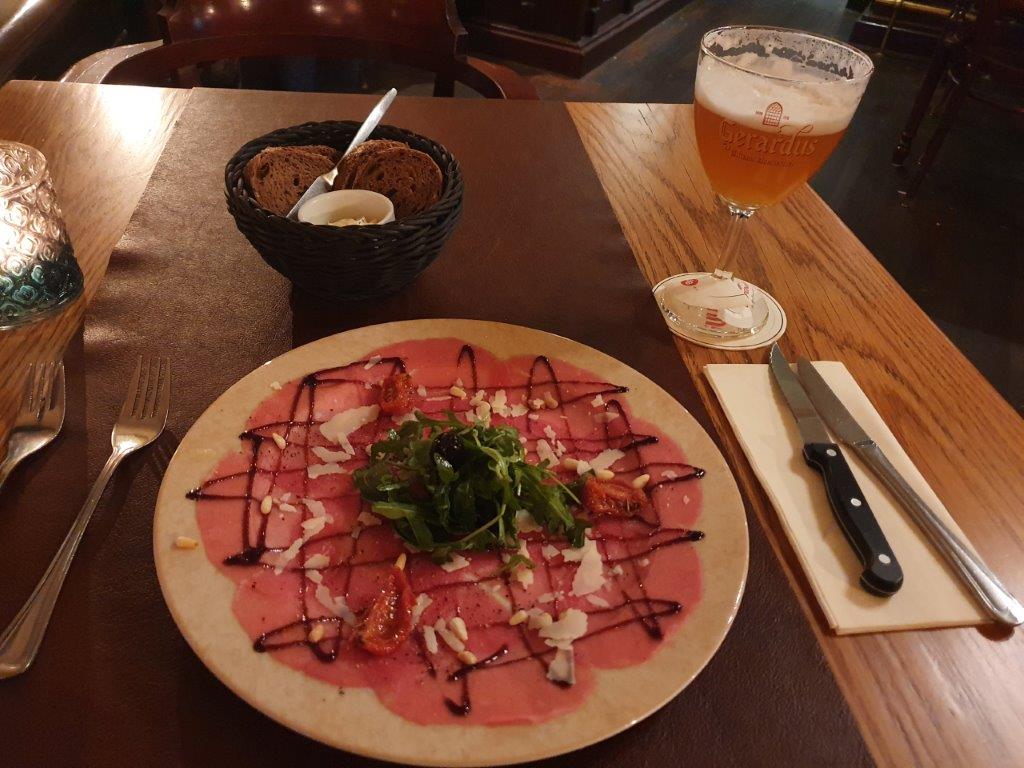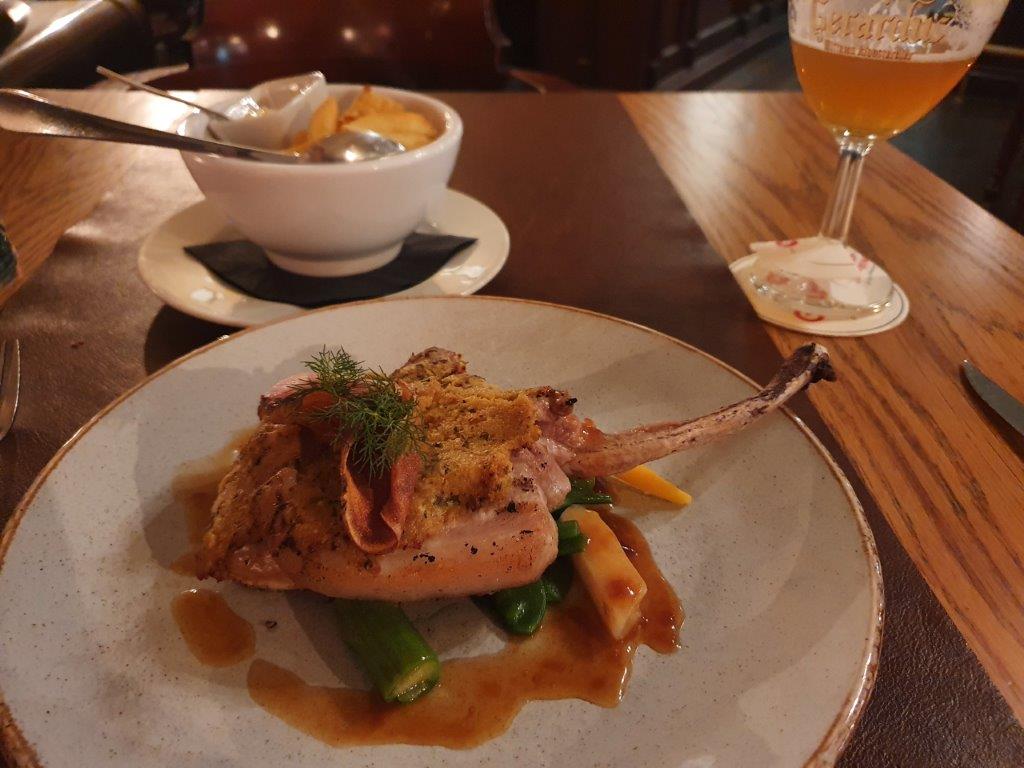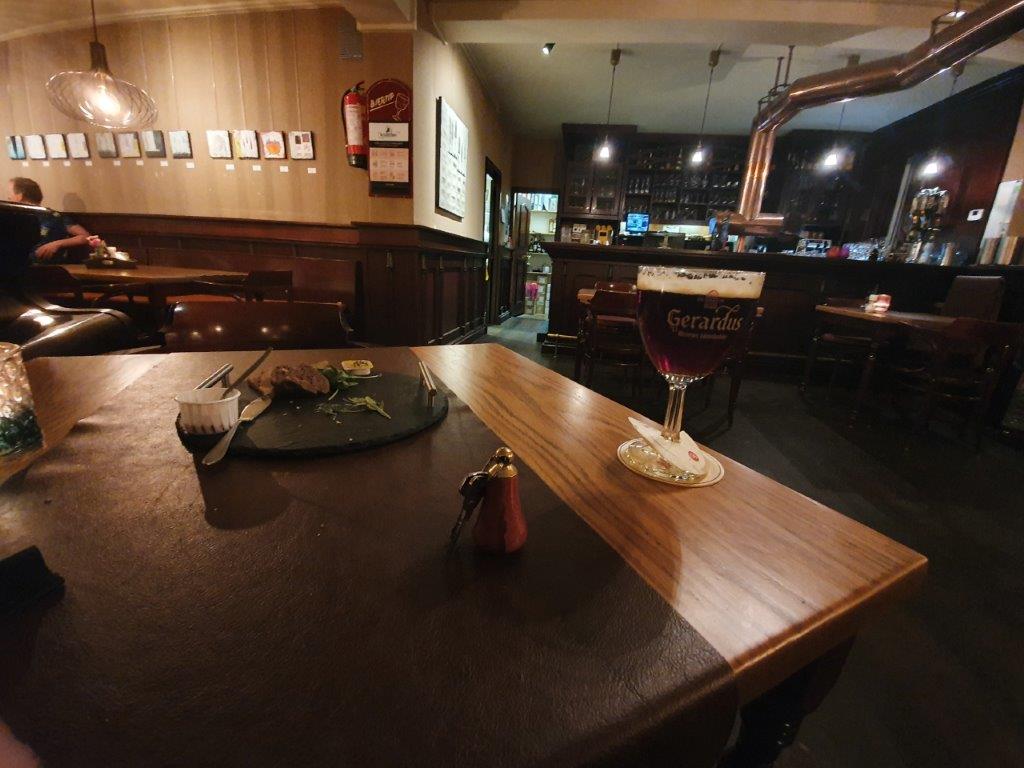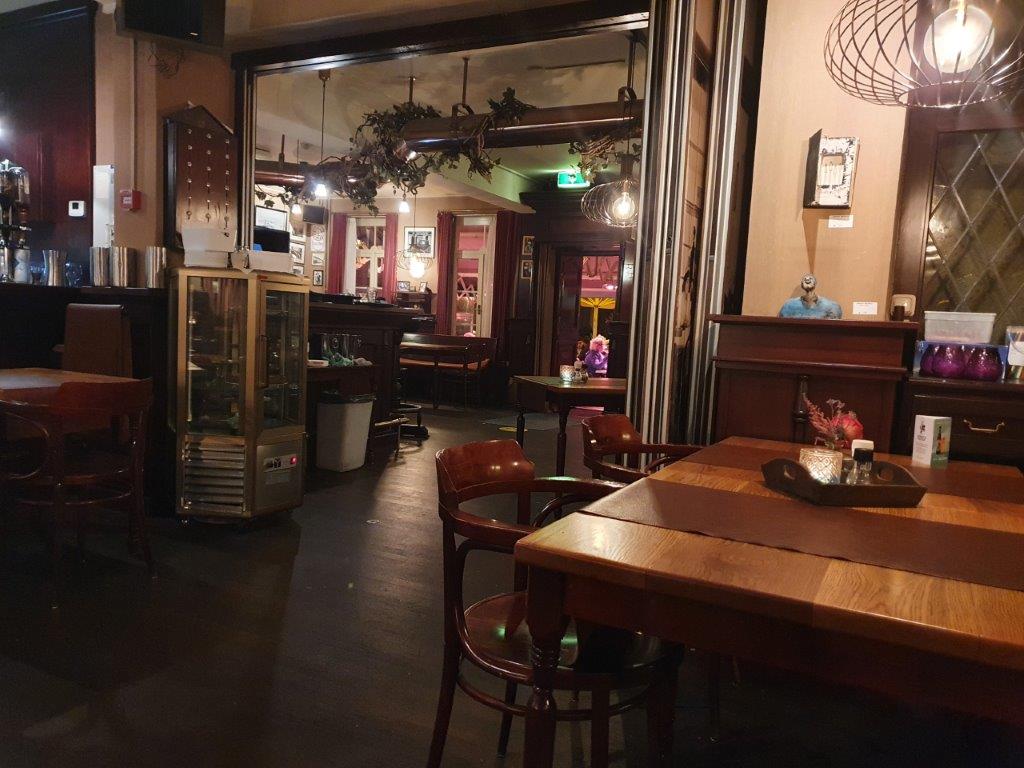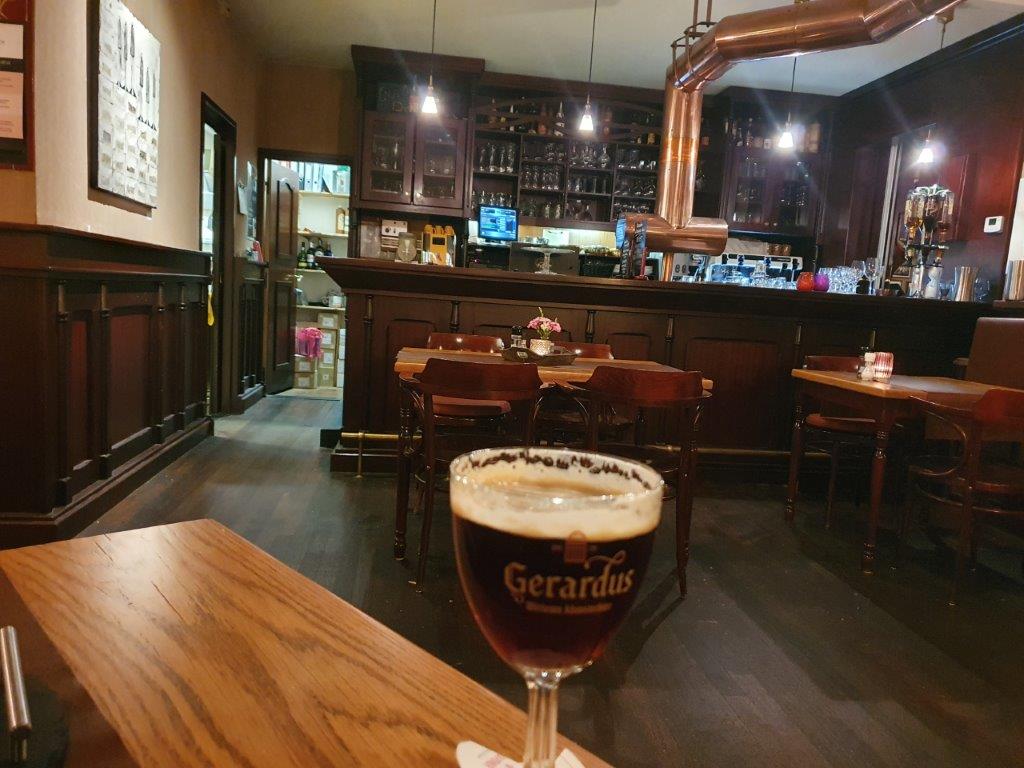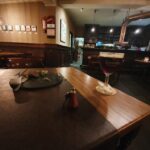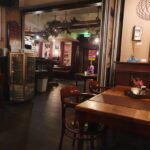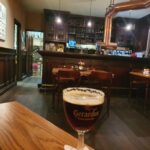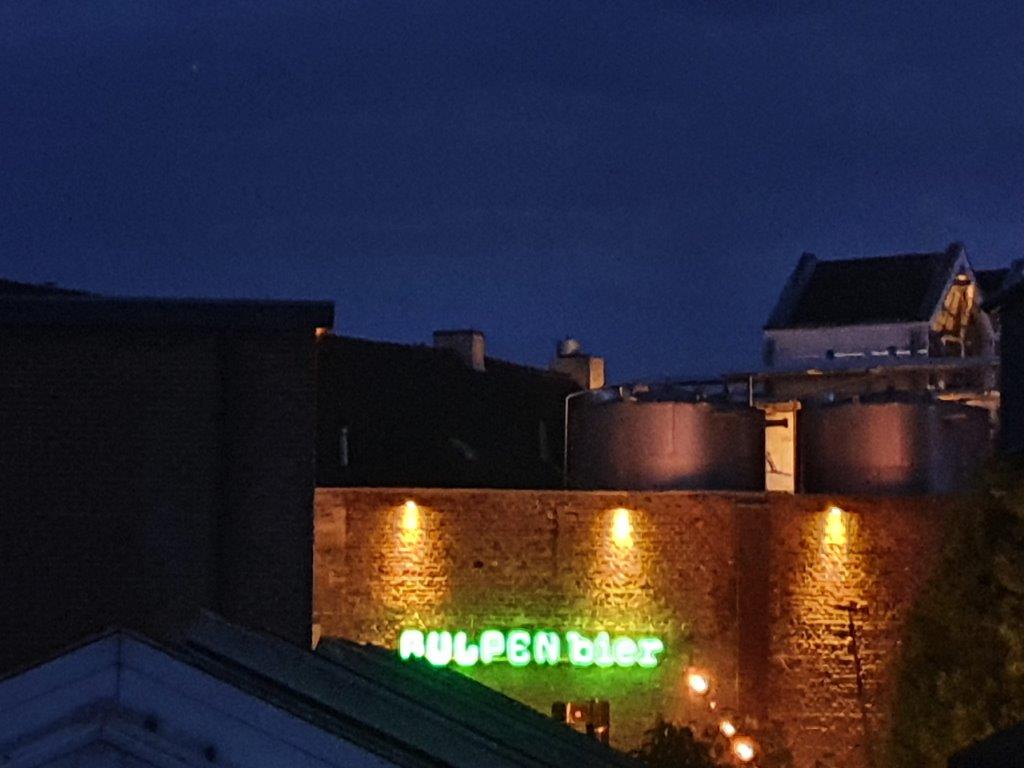Dutch Mountain Trail Walk 4: Vijlen – Gulpen: Of Black Riders and Railroad Switchmen
After a quick hot shower and a quick breakfast, The Wandelgek checked out and thanked for the hospitality he had enjoyed, which also meant that the hosts kept the bar longer open in the evenings than the official openings hours
Map
Then he took his large backpack on top of his shoulders and walked out the door towards the road, where he went right, towards the village center.
Past the church he went left and descended into the lower valley.
Then The Wandelgek walked towards the hamlet of Rott, slowly leaving the Church of Vijlen permanently behind him. It had been a companion for many days and could be seen when he walked from Kerkrade to Vaals, from Vaals to Vijlen and during his 2 wine walks.
The Wandelgek advanced in the direction of … , past the vineyard Martinushoeve…
…and then towards and through the hamlet of Rot…
…, from where he picked up on the next section of Dutch Mountain Trail.
The trail went almost continuously south for a long while, after leaving the Vijlenerbos, the trail stayed upon a hill ridge, which meant that views over the vale were excellent…
After having advanced some kilometers, the trail started to descend slowly towards the vale.
Brooks and valleys
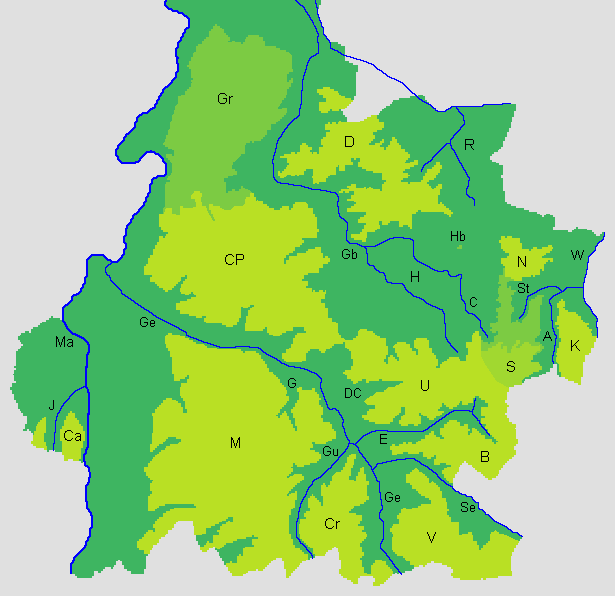
Dutch: Map with plateaus and valleys of Zuid-Limburg, Netherlands Legend: B Plateau van Bocholtz Ca Plateau van Caestert CP Centraal Plateau Cr Plateau van Crapoel D Plateau van Doenrade Gr Plateau van Graetheide Hb Heksenberg K Plateau van Kerkrade M Plateau van Margraten N Plateau van Nieuwenhagen S Plateau van Spekholzerheide U Plateau van Ubachsberg V Plateau van Vijlen A Anstelerbeek C Caumerbeek DC Droogdal van Colmont E Eyserbeek G Gerendal Gb Geleenbeek Ge Geul Gu Gulp H Bekken van Heerlen J Jeker Ma Maas R Bekken van de Roode Beek Se Selzerbeek St Strijthagerbeek W Worm
These vales are all created by small rivers or streams that run through them, like e.g. the Mechelderbeek, which means Mechelder Brook. Mechelen is a small village which gave its name to this brook.
The Wandelgek crossed the Mechelderbeek via a small bridge. The path was still a bit under water, but this was nothing compared to what these brooks must have looked like a few weeks earlier when most of them overflowed and caused disaster in the low and deep valleys of South Limburg.
Then the trail followed the Mechelderbeek for a while.
The path changed into a paved road.
A crossroads signpost, between Mechelen, Elzet, Wahlwiller and Hilleshagen, informed The Wandelgek that he was still on track (see the little white and blue symbol on the back of the traffic sign) and directed him straight ahead towards the little village of Wahlwiller.
The road went on south past another field cross…
…and through the green fields. Far to the right was the little hamlet of Hilleshagen.
Slowly to road kept descending until far away, straight ahead, the village of Wahlwiller became visible. First the church tower rose from the deep vale in which it was embedded, then the rest of the village slowly showed itself…
The road changed into a dirt path again and advanced through the typical hilly and rural landscape of South Limburg. A landscape crossed by little streams, occupied by relatively small patches of farmland where trees and hedgerows were allowed to grow, thus stimulating its biodiversity a lot.
This is something which is much less seen in the rest of the country, although it seems that politics are changing their view on agriculture, stimulating eco farming and biodiversity much more than in the past. But the country is not there yet. There is much work to be done. In 2015 The Wandelgek backpacked through the south of England andcwas very pleasantly surprised by its enormous biodiversity. See more of that in this blogpost: England: Where hobbits walk… – Walk through The Shire – The Cotswolds: Area of Outstanding Natural Beauty (Cotswolds 4) – 2016
The last stretch of the dirtpath towards Wahlwiller was going through loads of exuberant foliage…
I loved walking through paths that were completely surrounded by green foliage like walking through a tunnel of vegetation. There were lots of these in South Limburg but here are some photo’s of the one near Wahlwiller
Somewhere… in Peter Jackson’s Hobbitland…
I totally associate these pics with the scene where Frodo 1st sees a black rider in the LotR movie trilogy, when Frodo says: “Get off the road!”
Don’t worry though. I’ll never get off the road. I was actually searching for a black rider instead of running away from one
And so The Wandelgek stayed On The Road and reached the village of Wahlwiller a little later…
Wahlwiller
Wahlwiller (Limburgish: Wilder [ˈβɪldəʁ]) is a village in the Dutch province of Limburg. It is located in the municipality of Gulpen-Wittem. The village is located south of the Selzerbeek.
The name of the village is derived from villare, what means “belonging to a villa”. In the 14th century the village is mentioned under names as Waelwilre, Wailwilre and Walwilre. The prefix “wael” indicates that the inhabitants were speaking a Walloon language (=French language Belgium).
On the northern side of the village lies the Kruisberg, of Amstel Gold Race fame.
The Cunibertus Church
In 1946 in the Cunibertus Church in Wahlwiller, the artist Aad de Haas added two to the traditional fourteen stages in Jesus’ agony: the betrayal of Judas at the beginning and Jesus’ resurrection at the end. Much too profane, according to a conservative clique. Under pressure from the Vatican, the beautiful Stations of the Cross were moved to a museum in 1949, only to return to Wahlwiller more than thirty years later. De Haas has never experienced this himself. The Rotterdammer – who had fled to Limburg during the war – died in 1972.
See this blogpost:Dutch Mountain Trail Deviation: Wine estate walk 2 about religion in the south of The Netherlands, wine and cement, for a classic road of the cross in 14 stations.
The trail went around the old walls of the Cunibertus Church…
…and then north towards the Selzerbeek (stream), crossing it at a small bridge and then going west following the stream for a few kilometers.
Crossing the Selzerbeek meant leaving Wahlwiller, which was entirely build on its south of the stream.
Selzerbeek (or Senserbach) is a river of North Rhine-Westphalia, Germany and Limburg in the Netherlands. It stretches over approximately 13 kilometres from its source at Aachen to its mouth near Gulpen into the Geul.
There was this very narrow path which was bordered by the stream left and a wire fence right, which got partly blocked by a large tree. Normally it would have been easy to pass the tree on the fence side, but it was way too small to do this carrying a large New Fjallraven Kajka 75 L. Trekking backpack . So The Wandelgek needed to pass the tree on the riverside, where the ground descended toward the stream. It was quite a tricky balancing act.
After a while, the trail departed from the river, turning north. At a small wooden gat was the start of the:
Route des vins
The Route des Vins is a walk through the Limburg hills. There are already a number of vineyards in this beautiful area, some larger than others. The aim of the Route des Vins is to introduce the hiker to both Limburg wine and the beautiful landscape. The Route des Vins starts and ends in the village of Wahlwiller, behind the church in the parking lot. The route goes up and down hill so it is good to wear sturdy walking shoes.
If you follow the arrows and walk ten kilometers, you will pass five different vineyards:
- Wittemer Vineyard
- St. Hubertus Vineyard
- St. Cunibertus Vineyard
- Domain Aldenborgh
- Domaine Salamander
The DMT will pass through the 1st 3 vineyard before advancing north towards the village of Eys.
I love these LotR-like paths
St. Hubertus vineyard
The 1st vineyard en-route was the St. Hubertus vineyard. The 3 vineyards visited via the trail, were all quite small compared to the vineyards visited by The Wandelgek near Vijlen. There were no wine tasting rooms available so The Wandelgek restrained himself to photographing and enjoying the views from the ascending path. Most vineyards need a hillslope to achieve the best possible grapes to produce wine. Here that was no different. For the trail it meant that there were great views over the lower valleys to enjoy.
The St. Hubertus vineyard can be found on a steep southern slope just north west of Wahlwiller, rich in limestone and flint, with beautiful limestone grasslands and in the valley the Selzerbeek. Even the Romans appreciated this. According to tradition, the Romans had already planted vineyards on the southern slope of the Bornberg north of Wahlwiller. At the end of the sixties of the last century, the construction of vineyards was started again. In Wahlwiller (between Vaals and Maastricht) there are now 3 vineyards that all produce delicious mainly white wines. Every year a large wine festival is organized between the Vineyards, always the last weekend of September. It is not for nothing that Wahlwiller has been named Wine Village of the Municipality of Gulpen-Wittem.
Next vineyard on the trail was the:
St. Cunibertus vineyard
Both, St.Cunibertus and St. Hubertus vineyards are producing white wines from Auxerois, Müller-Thurgau, Pinot Gris and Pinot Noir grapes.
The sun showed itself a bit when I was visiting these vineyards…
Wittemer vineyard
On the hills along the small Zinselbeek near Wahlwiller lies another piece of earthly paradise. Tingling Wittemer wines originate here. That wine can be made from grapes must have been discovered by accident. Ripe grapes can easily bruise; the skin is broken and the yeast cells present on the skin come into contact with the sugars of the juice and the alcoholic fermentation can start. Alcohol in combination with other flavorings in fruit juice produces a drinkable product with pleasant properties: the wine is born.
The story goes that the Romans established here (at the beginning of our era) already practiced viticulture in these regions. At the end of the Middle Ages and at the hands of Napoleon, viticulture was severely restricted. The importation of the infamous root louse ruins grape cultivation and makes viticulture in the Netherlands disappear completely. After the first early attempts were made in 1968 to start growing wine again in the Netherlands (on Slavante along the southern slopes of the St.Pietersberg in Maastricht), in 1971 Dr. Schepel, GP in Gulpen, 1000 vines on the terraces of the Zinselbeek in Wahlwiller. He experimented with many grape varieties. He made “Wittemer Wijn” and proudly called it the “Wittemer Wijngaard”.
Since 1999, Wim Hendriks and Leny van Bavel have taken over the management and restored the old traditions as much as possible. The “Wittemer Wijngaard” again produces “Wittemer Wijn” from the grape varieties Riesling, Müller Thurgau, Pinot Noir and a single Pinot Gris. Riesling, in particular, deserves special mention, as this is an admittedly difficult, but also very noble grape variety. Thanks to the pioneering spirit of Schepel, this variety is abundantly present here and it is therefore possible to make good quality wine in Wahlwiller.
Then The Wandelgek followed the ascending trail to the summit…
… and walked over a high plain or plateau towards a much higher, forested hill. That was The Eyserberg (Eyser mountain, named after the village of Eys at its base), also known as the Eyserbos (Eyser wood).
Weather conditions looked a bit unstable and forecasts had been bad for this day. But it had been not that bad at all. Occassionally there was a bit of sun and otherwise it was cloudy but quite warm. However, this was hill country and The Wandelgek spoke to some other walkers that encountered him. They cane from the small hill town of Valkenburg, which is more north and they said they had seen heavy rainfall up there, coming south now. The Wandelgek decided to quicken his pace and try to reach Gulpen where hus walk for today would end, before getting caught up in that heavy rainfall.
Sometimes it was quite difficult to find trail signs, like e.g. the one below…
At the verge of the plateau, the trail began to descend towards the valley and the village of Eys…
Not far from the valley floor The Wandelgek reached almost the village of Eys,
…but before reaching that village, the trail hit a railroad line and bend sharp to the west, thus leaving Eys behind.
This railroad is named:
The Miljoenenlijntje
The Zuid-Limburgse Stoomtrein Maatschappij (South Limburg Steam Train Company) or ZLSM is a heritage railway operating from its main station of Simpelveld to Schin op Geul and Kerkrade in the south of the Netherlands. It also runs across the border from Simpelveld to Aachen-Vetschau and has an extensive collection of stock. The ZLSM is currently partnered with the Great Central Railway in England, as they have both double-track railways, although one is disused.
In the year 1989, The Wandelgek backpacked on his very 1st travels without his parents from The Netherlands through Belgium to Luxemburg and back. During the return journey he ended his travels in South Limburg, where he walked from Maastricht to Gulpen and from Gulpen to Valkenburg in 2 days. That 2nd day to Valkenburg he walked via Simpelveld, a small village with a railway station.
One of the reasons to visit the railway station, was because he was wild camping and needed a place to brush his teeth and to refill his water bottles. This was possible at the statuon’s toilet section.
A man who worked as a switchman (dutch = wisselwachter). A switchman or pointsman is a rail transport worker whose original job was to operate various railway switches or points on a railroad.
The Wandelgek got into a conversation about his job. He was a few years before his pension and he had worked for a long time at this station, where no trains stopped. He had fond memories of a time when there were trains stopping at this station and he was station chief.
The tourist trains of the Miljoenenlijntje stopped at this station, but because they were very ecpensive to manage, the company that did went bankrupt and the service stopped (nowadays (2019) the service has been reinstated).
He was also talking about his current job as a switchman, where he had to operate several railway switches. Some of those were electronically operated, but he proudly announced that some were operated the old way, meaning with large wooden levers which pulled or released long steel chains attached to the switches that were near to the station.
Suddenly he asked whether I was interested in seeing those levers and him operating those and I enthousiastically said I would love to see that.
He invited me into his switch house cabin and showed me how to operate the railway switches. Suddenly, bells started to ring very loudly and he said a train was on its way to the station.
He started to walk towards a lever to pull the chain and change position of the switch and thus the direction of the train, when I interupted him and bravely asked him whether he would allow me to pull the lever instead. He smiled, stepped aside and let me have a go.
It was not that easy. I had to put in my full strength and weight to get some movement in that lever but eventually I succeeded. The train had already past the switch though… No just joking
A lot of years before his encounter with the switchman, The Wandelgek had been on a trip towards the german city of Aachen with his parents and brother and inside of the train. It is indeed the most beautiful stretch of the entire dutch railway network and it got etched into his mind.
All this popped up in The Wandelgek’s memory when he walked along side the railway line of this tourist railway line, which had been put into operation again, only a few years earlier.
After passing an old railway station, the trail crossed underneath the railway tracks via a tunnel which looked like it was a dark rabbit hole into Wonderland…
…and it really was!
The world at the other side of the tunnel really was a wonderland with beautiful trees and a trail ascending towards the little hamlet of De Piepert, but 1st it crossed another small brook the Eyserbeek…
Eyserbeek
The Eyserbeek (Limburgish: Ezerbaek) is a river in the province of Limburg, Netherlands. The Eyserbeek is a right-bank tributary to the river Geul, which later joins the Meuse. Rising in Bocholtz and flowing through Simpelveld and Eys, the Eyserbeek eventually drains in the river Geul in Gulpen. The Eyserbeek lies on the north of the plateau of Bocholtz and south of the plateau of Ubachsberg.
De Piepert
De Piepert is a hamlet that belongs to the South Limburg church village of Eys in the municipality of Gulpen-Wittem.
The paved road leaving De Piepert eastbound, was going to Eys.
But there was also a trail ascending westbound from De Piepert into the Eyserbos.
The Wandelgek entered this path and after a 1st slow ascending stretch it suddenlybturned north and ascended very steeply towards the summit of the Eyserbos/Eyserberg.
After some steep stairs…
…the trail proceeded through a large meadow in bloom,…
… before entering the Eyserbos again for the last steep climb to the summit…
The Wandelgek had now reached the 3rd of the 7 summits that were challenged on the DMT.
The trail kept this altitude for a while before descending towards today’s destination at the larger village of Gulpen (seen from the Eyserbos below)…
Via a very long descend, treading on sharp rocks, The Wandelgek walked into the valley of the river Gulp, which is the largest tributary of the river Geul. The rains that were coming from Valkenburg finally had reached The Wandelgek and although at first he only noticed a slight drizzle,
As he reached the valley floor, he crossed a bridge over the Miljoenenlijntje….
…and then he advanced towards the tiny hamlet of Cartils. The trail was going through this hamlet but The Wandelgek decided to deviate from the trail so he could walk past the castle of Cartils.
It was now really raining and the sky looked like it had lots more to offer where that came from, so The Wandelgek who was now near to his destination increased his speed and after crossing the Eyserbeek just before Gulpen, he followed the Burggraaf into Eysden and towards its central villa square, where he had booked a room in an old Inn (dutch = Herberg), named De Zwarte Ruiter (The Black Rider).
It had really, really started raining now and The Wandelgek had been pulling his rain cover over the backpack. After he arrived at the central village square he immediately went into
De Zwarte Ruiter / The Black Rider
…to check in …
…and drink a good sturdy beer. It was a Gerardus Brune (dutch: Gerardus Dubbel) from the Gulpener Beer Brewery, which was just around the corner.
He had been scarcely 5 minutes inside when he looked outside and saw the cannisters of heaven were now pouring empty. The water was now like a continuous grey curtain keeping the world behind completely out of sight. But inside it was cozy and I had a good time celebrating my 4th summit
Village figures, newspaper readers, walkers and cyclists, regular guests and tourists, business people, they all meet at De Zwarte Ruiter.
Herberg De Zwarte Ruiter owes its name to Rutten’s Bierbrouwerij De Zwarte Ruiter N.V., founded in 1893, a brewery that was successful with the production of Maastrichts Oud (“Mestreechs Aajt”) and Maastrichts Jong. Mestreechs Aajt is a dark, light-rinsed beer. Once the beer style of Maastricht, but it disappeared at the end of the 1950s due to the craving for lager. From 1991, history has been revived in Herberg De Zwarte Ruiter.
Since 1991 – the year of the opening of Herberg de Zwarte Ruiter – history has been revived by the restored Aajt brewery in Herberg de Zwarte Ruiter where, in collaboration with our valued neighbor and brewer the Gulpener Bierbrouwerij, the Mestreechs Aajt is once again serving traditional dishes. way is brewed. The Gulpener Bierbrouwerij has been run since 2015 by a descendant (the 8th generation!) of the Rutten family of brewers, Jan-Paul Rutten. Gulpener’s brewmaster explains: “The secret of the unique Mestreechs Aajt lies in the rich tradition of South Limburg’s ‘primal beer’, also known as ‘starte beer’. This beer is created by spontaneously fermenting it in special closed oak barrels. At least 4 seasons pass (!) before we filter the quite sour original beer and mix it with various other beers, such as Gulpener Dort and Oud Bruin. This is how the blend is created, with a cider-like scent that caresses the nose and the typical rindish taste that characterizes our Mestreechs Aajt.”
The Wandelgek is a lover of beer tasting and beer styles. For more information on that visit the Pub of this weblog at e.g.: The story behind the beer bottle label…
The morning when The Wandelgek left De Zwarte Ruiter, he was invited by the landlady to visit the old brewery kettles that were in the Inn and taste a bit of the Mestreechs Aajt beer, but more of that in an upcoming blogpost.
After he had finished his drink, The Wandelgek went to his room for a shower. From the rooftop he could see the Gulpener Beer Brewery…
Wonder what good stuff was brewing in those tanks, so a visit to the breweries’s beer garden was a must do for the next day…
After having showered and unpacking some stuff The Wandelgek returned to the bar room of De Zwarte Ruiter and ordered a Val Dieu Brune beer, which is named after the Belgian abbey of Val Dieu (Valley of God), that he had visited several times before and that he was still gonna visit in the next couple of days…
Rains kept pouring down that afternoon and evening, so The Wandelgek did not go out anymore, hoping for better weather the next morning. He had planned to do a short walk of about 8 kilometers and climb the 5th summit of the DMT the Gulperberg. But with this weather conditions he decided to postpone it till next morning. It was dinner time and the food at De Zwarte Ruiter is splendid.
E.g. their Carpaccio:
Then a good sturdy main course followed combined with a Gerardus Triple beer…
…finally The Wandelgek tried some more tasty beers combined with a cheese board including 3 local cheeses with apple sirup and bread.
Then it was time to go to sleep and as The Wandelgek walked over the roof terrace towards his room he had a view over the Gulpener beer Brewery and the now lit neon sign.
Then he went to bed and had a good night rest, because he had planned some interesting local walks for the next day…
More information about Herberg De Zwarte Ruiter



